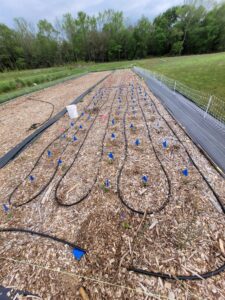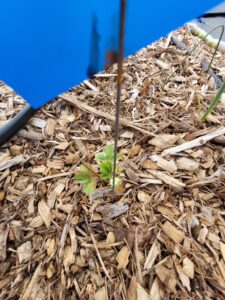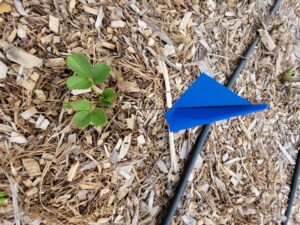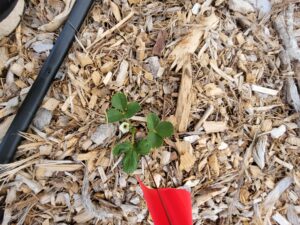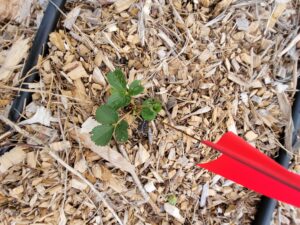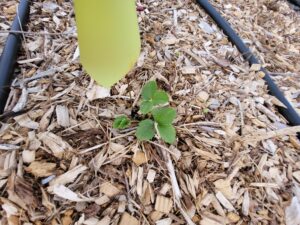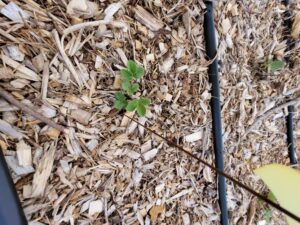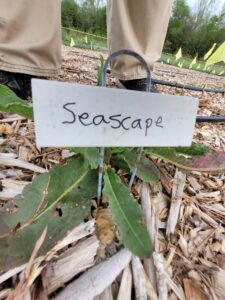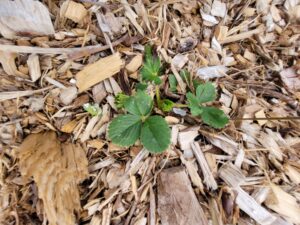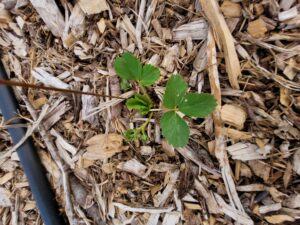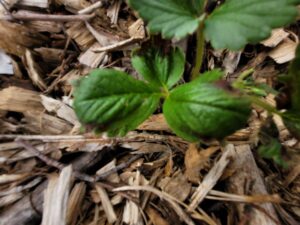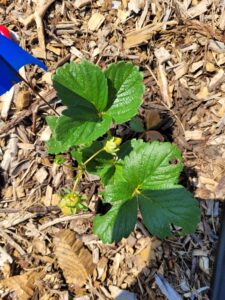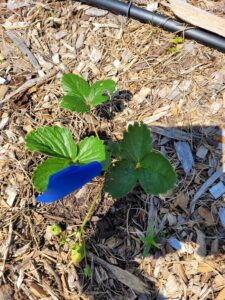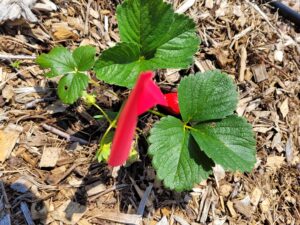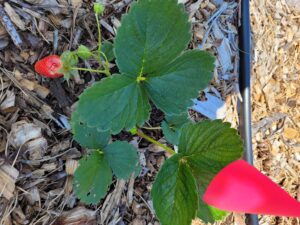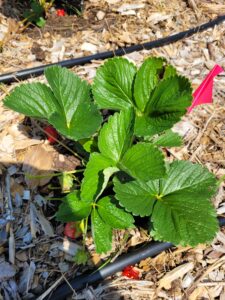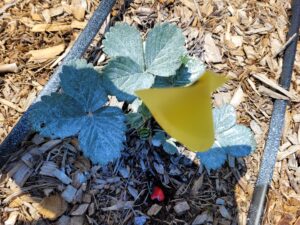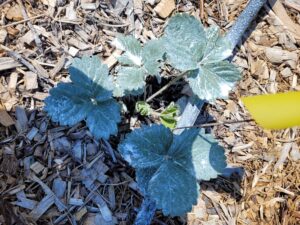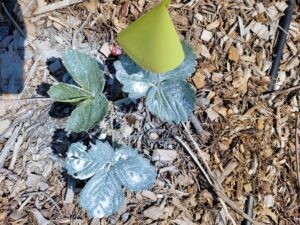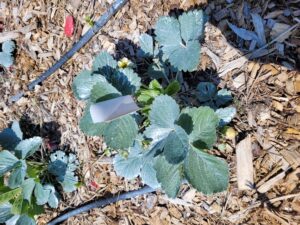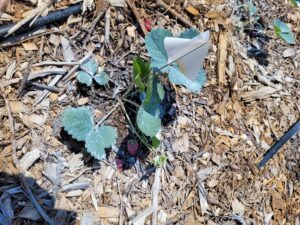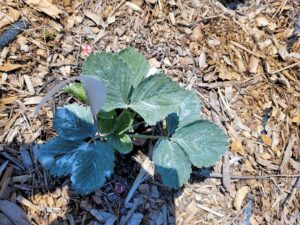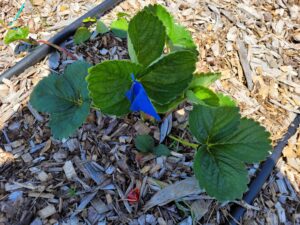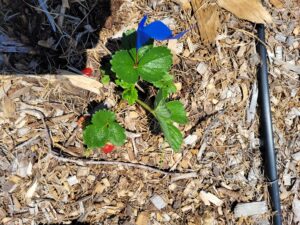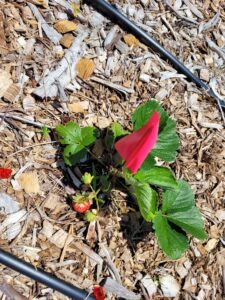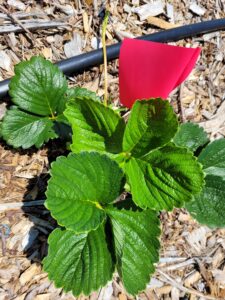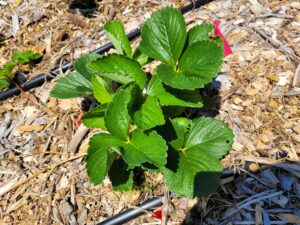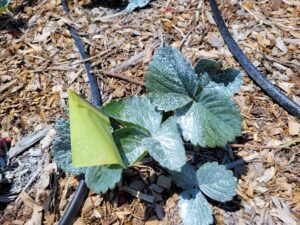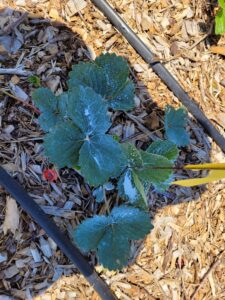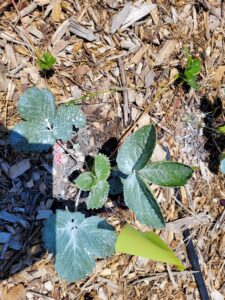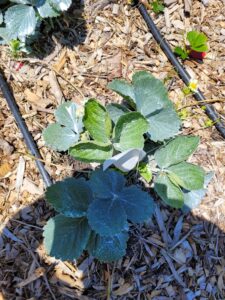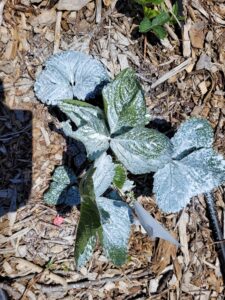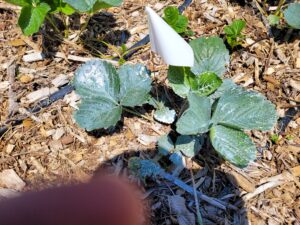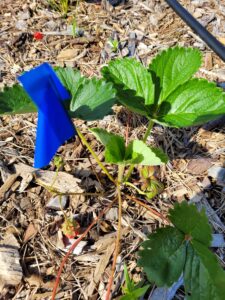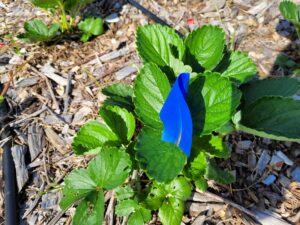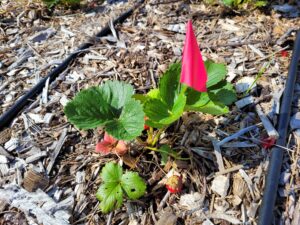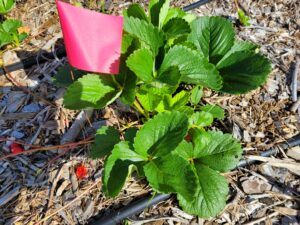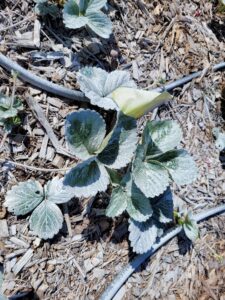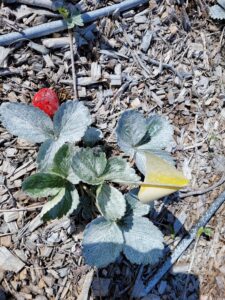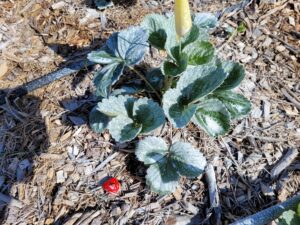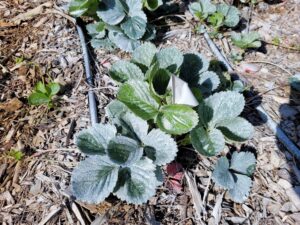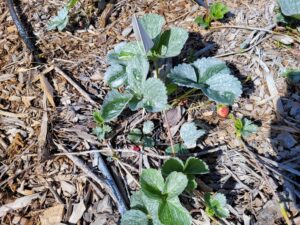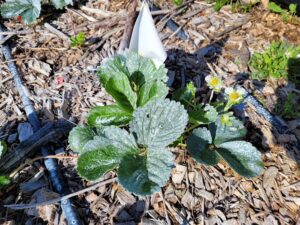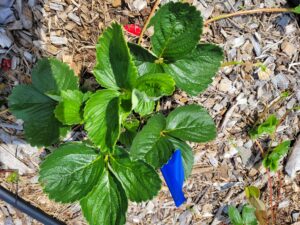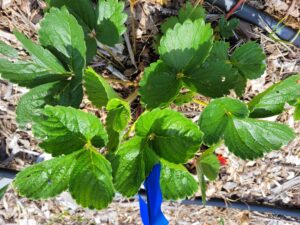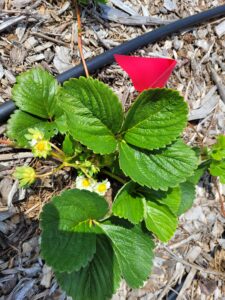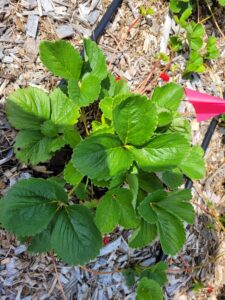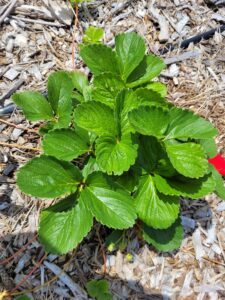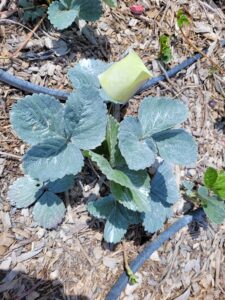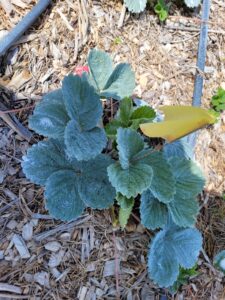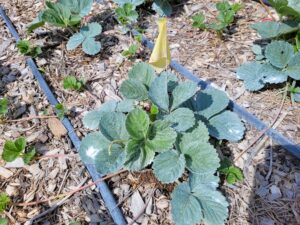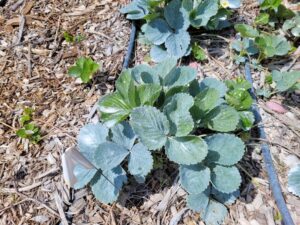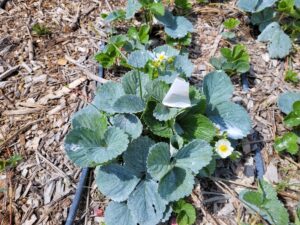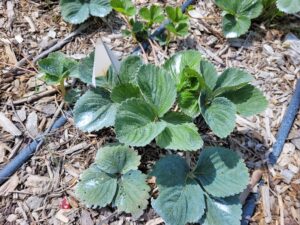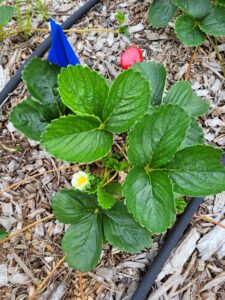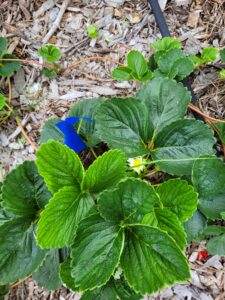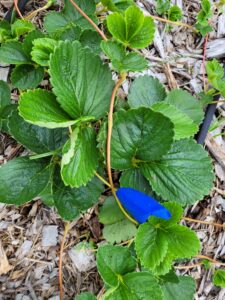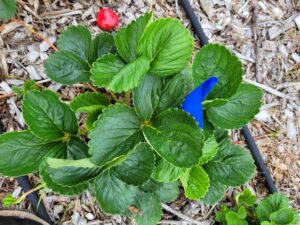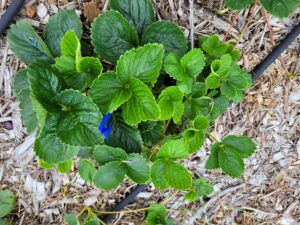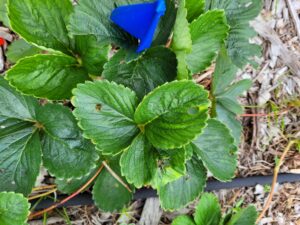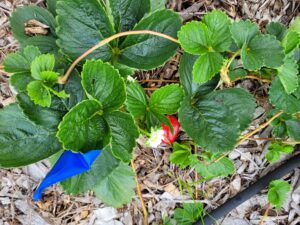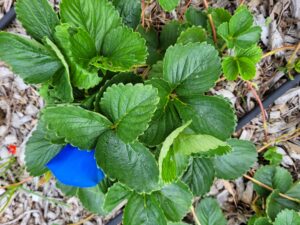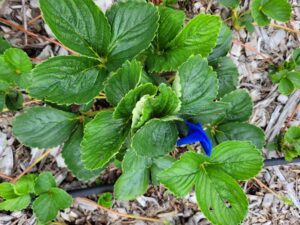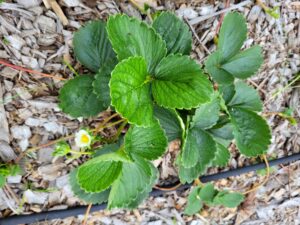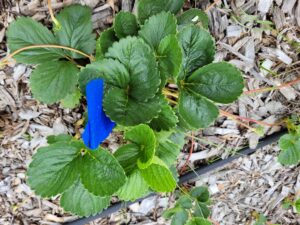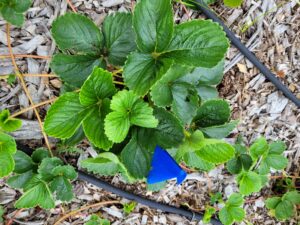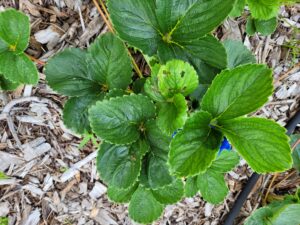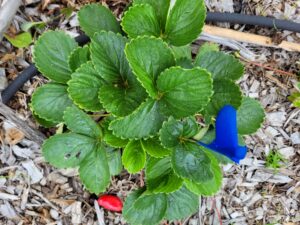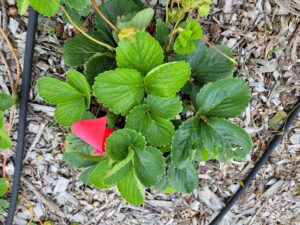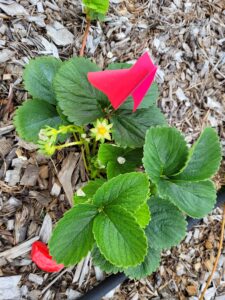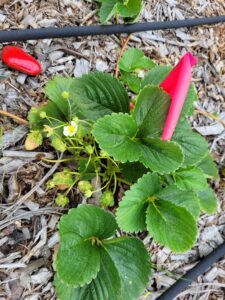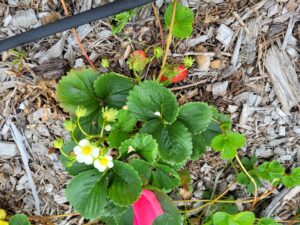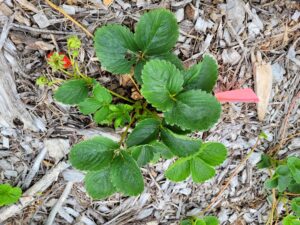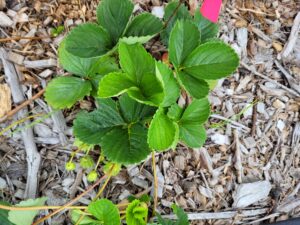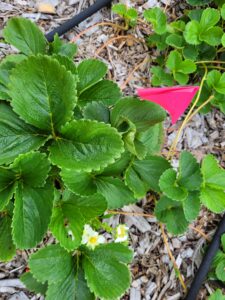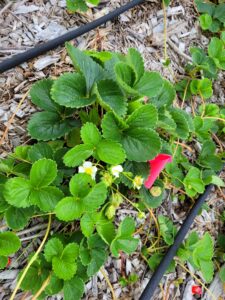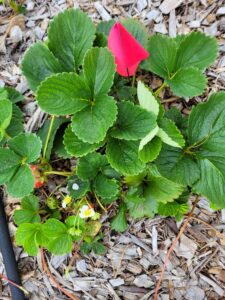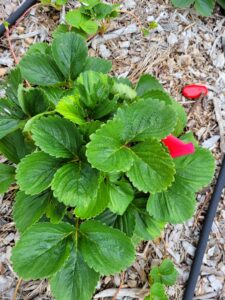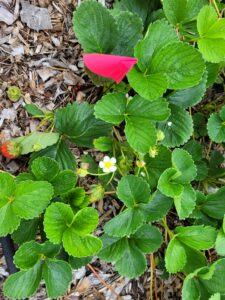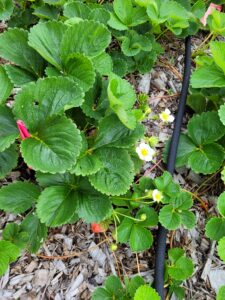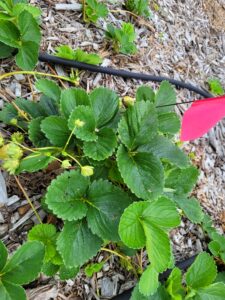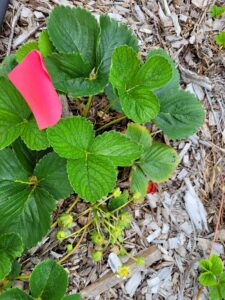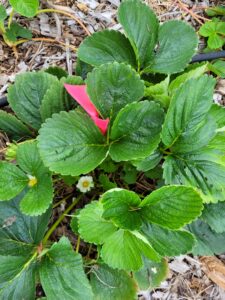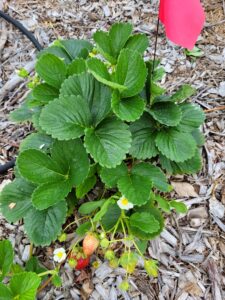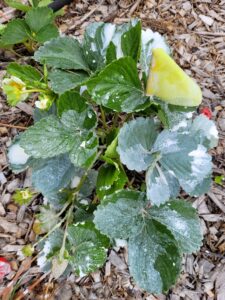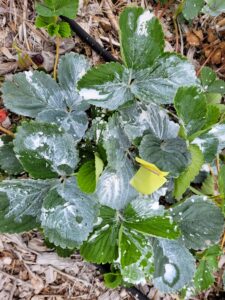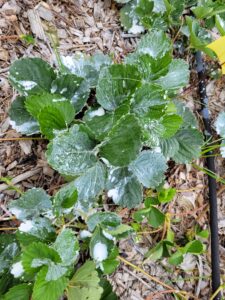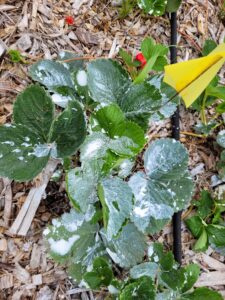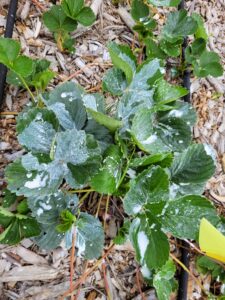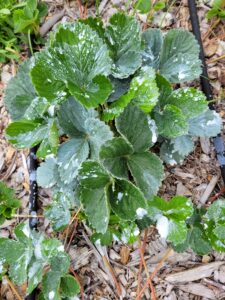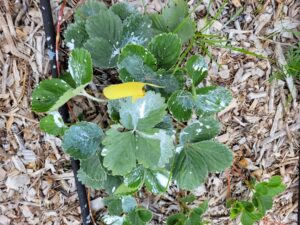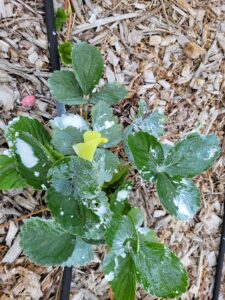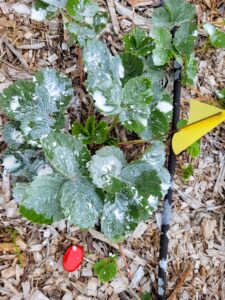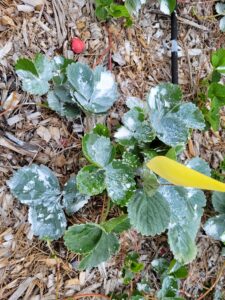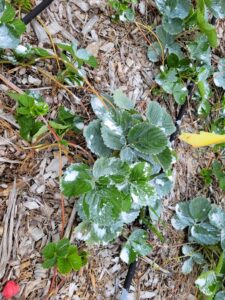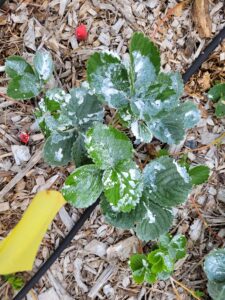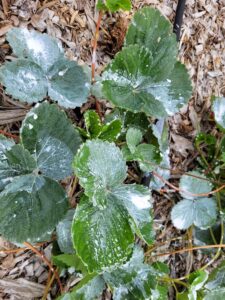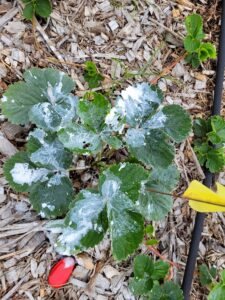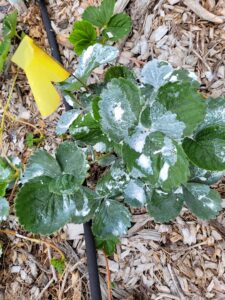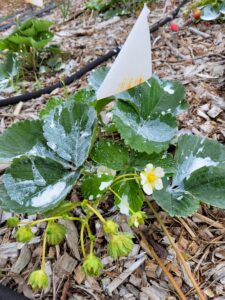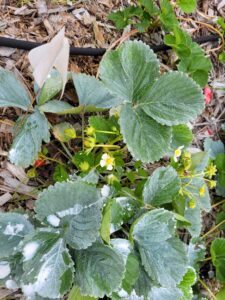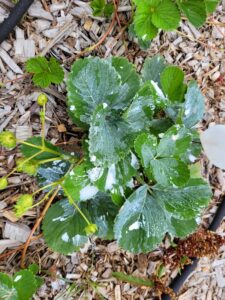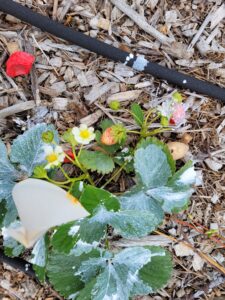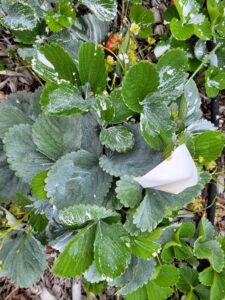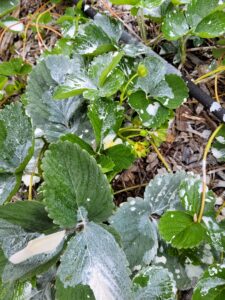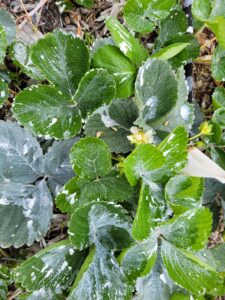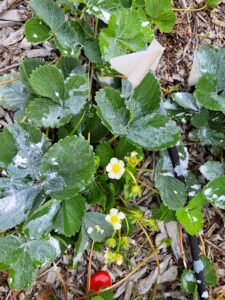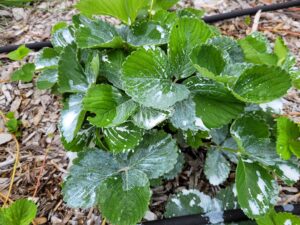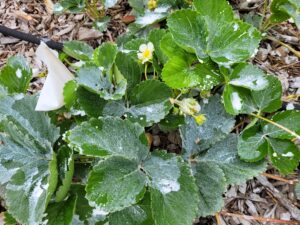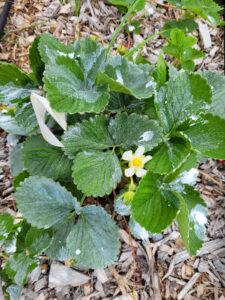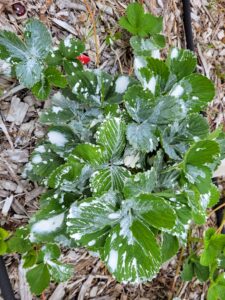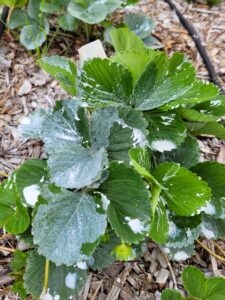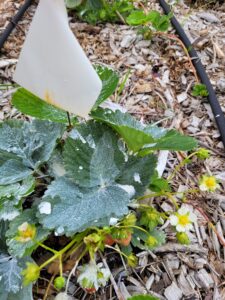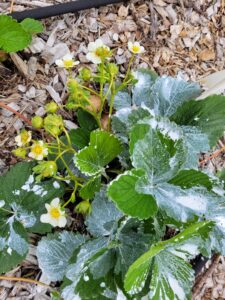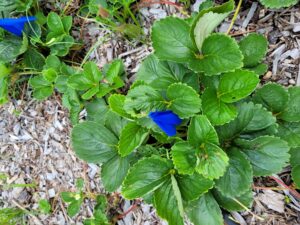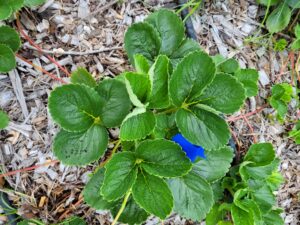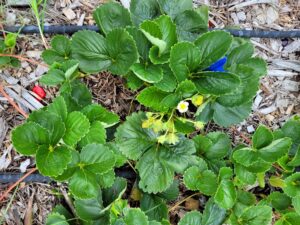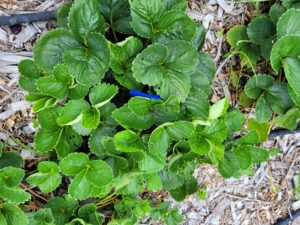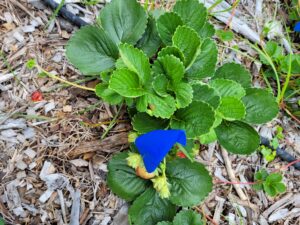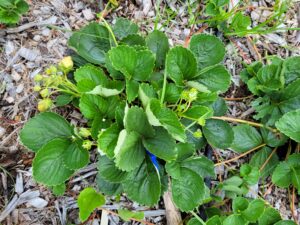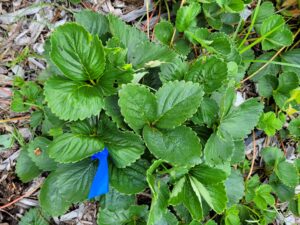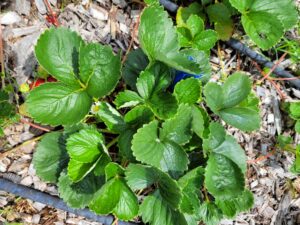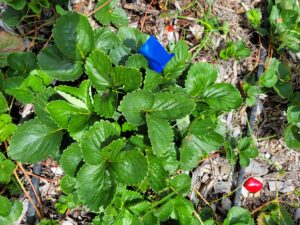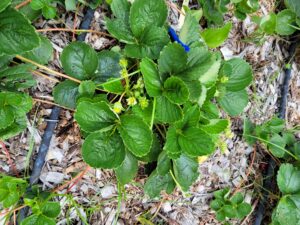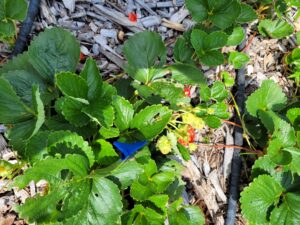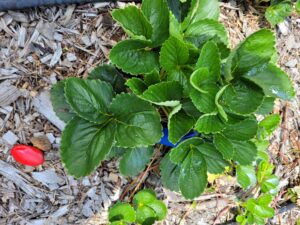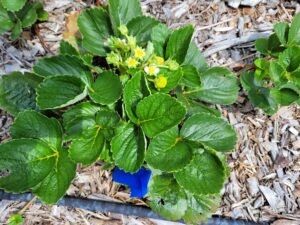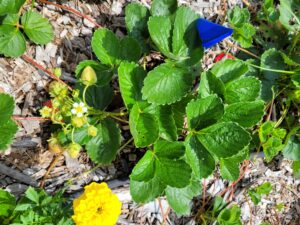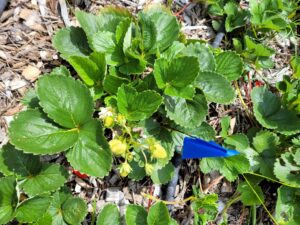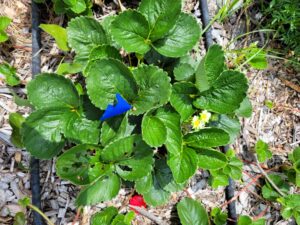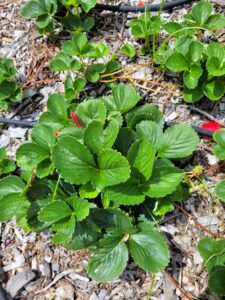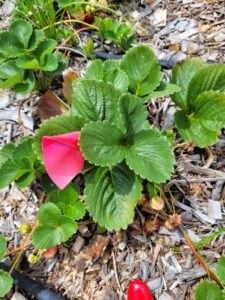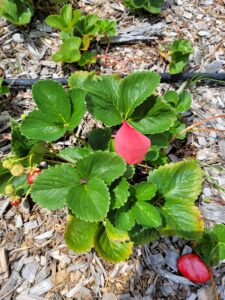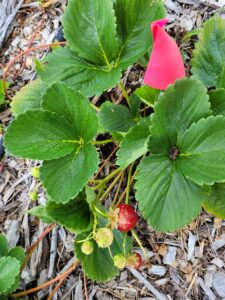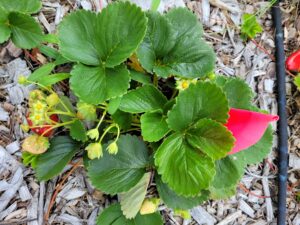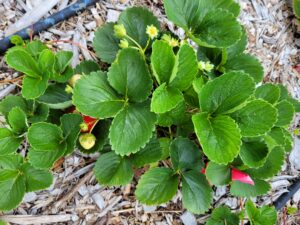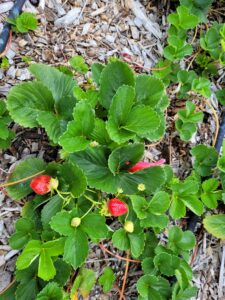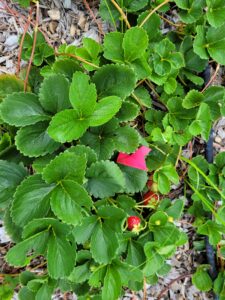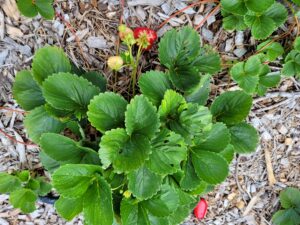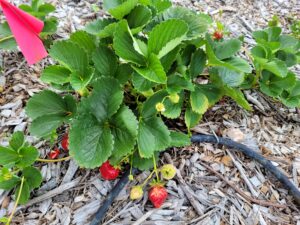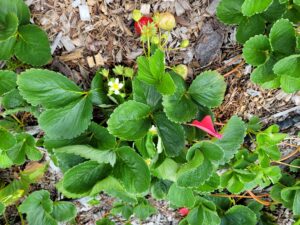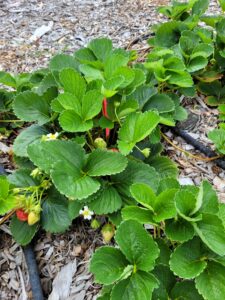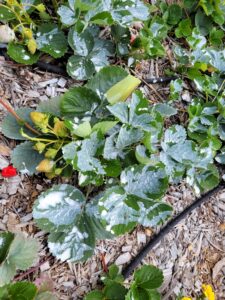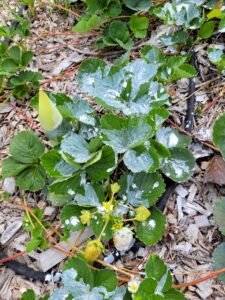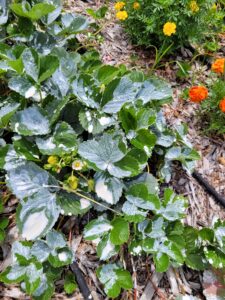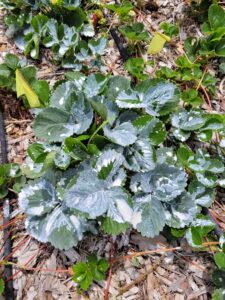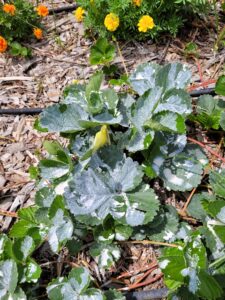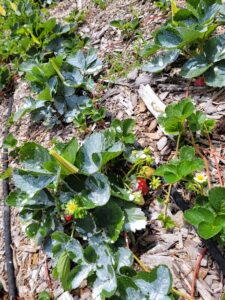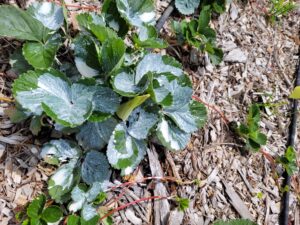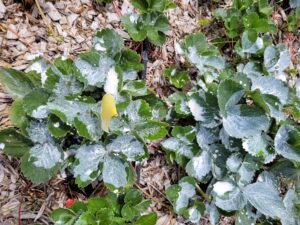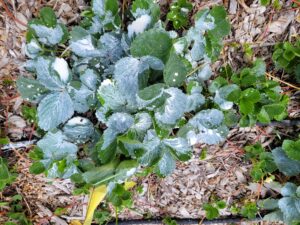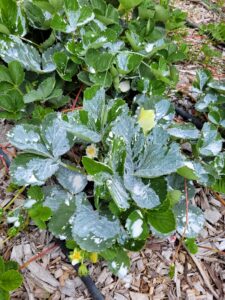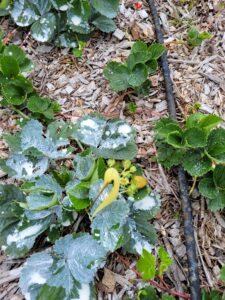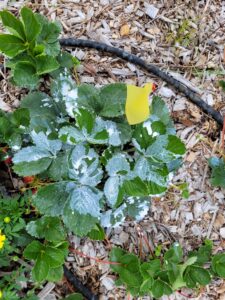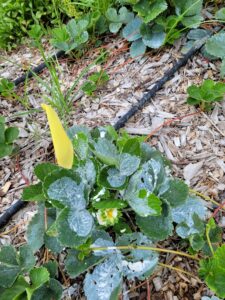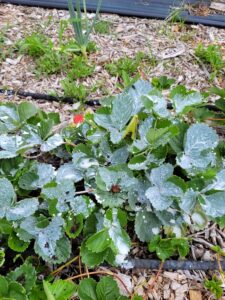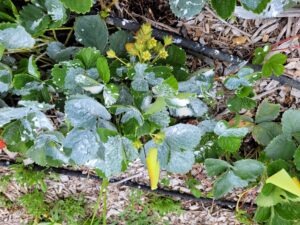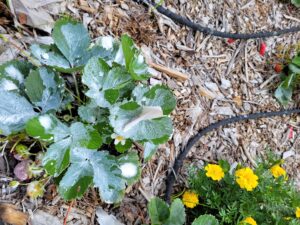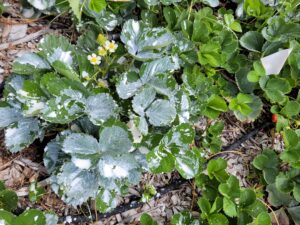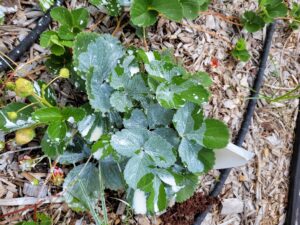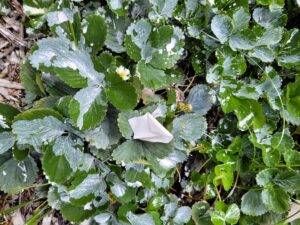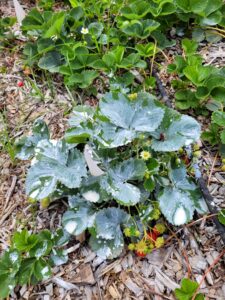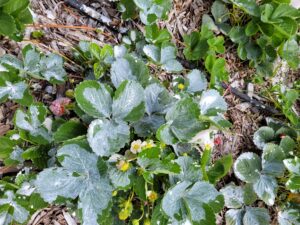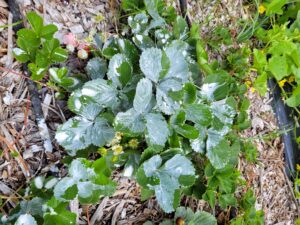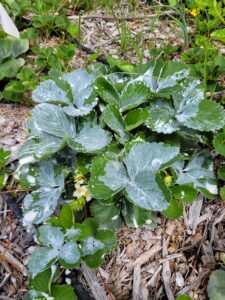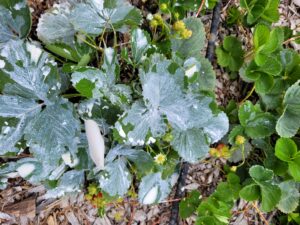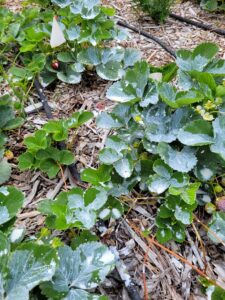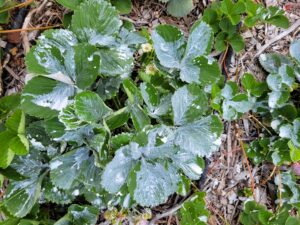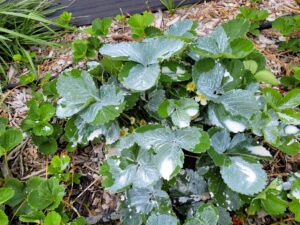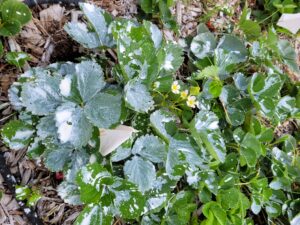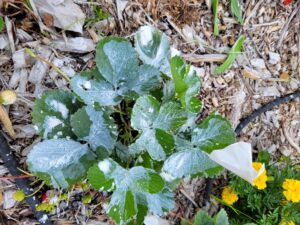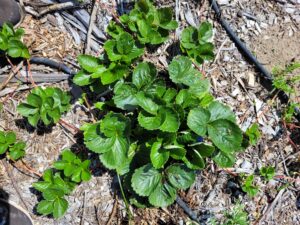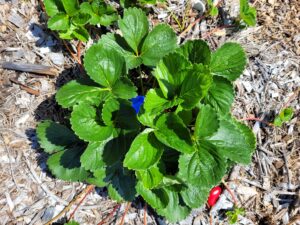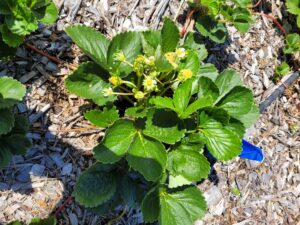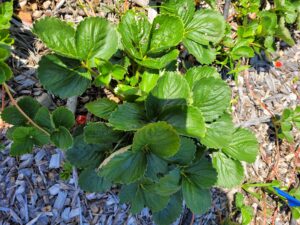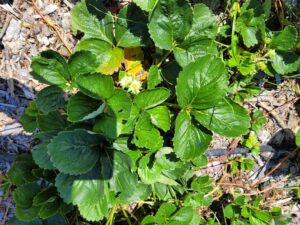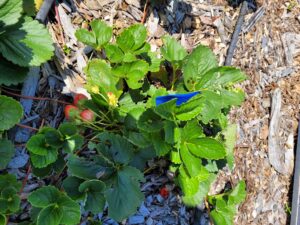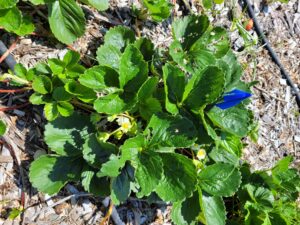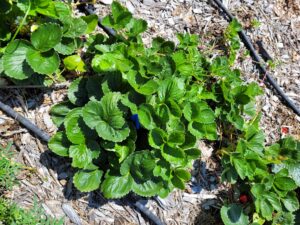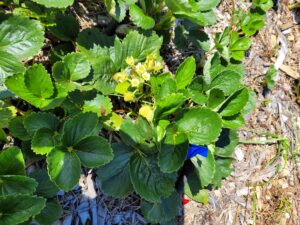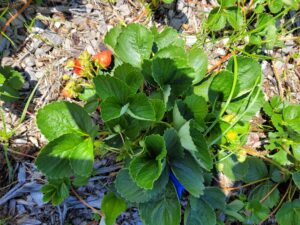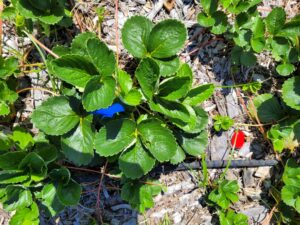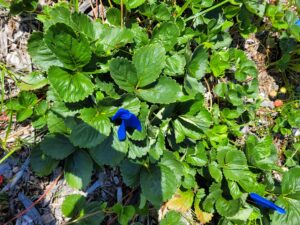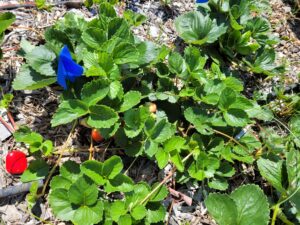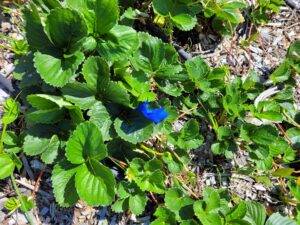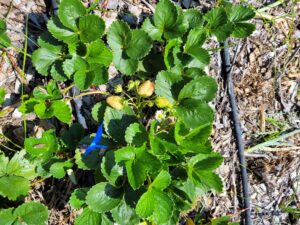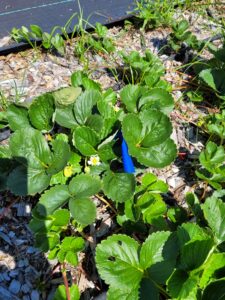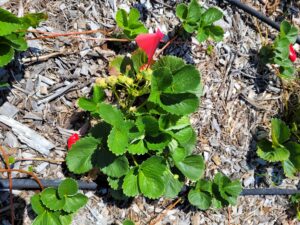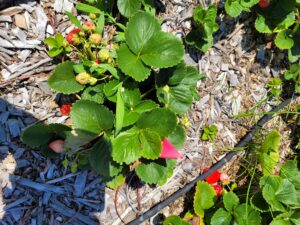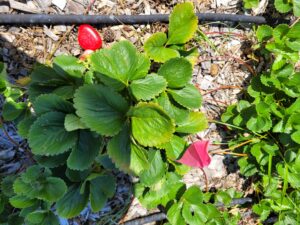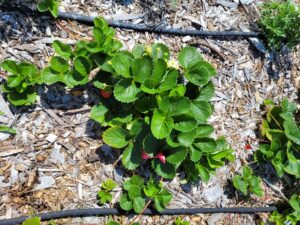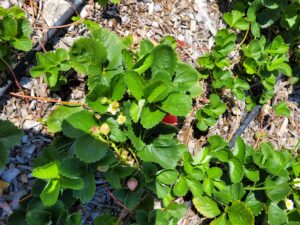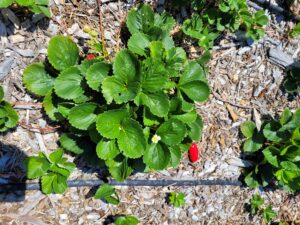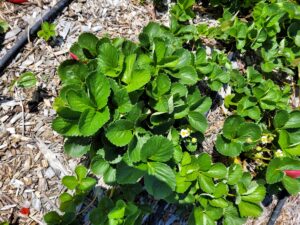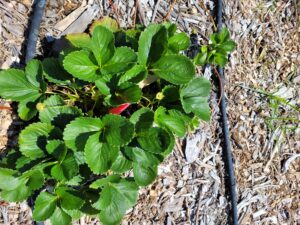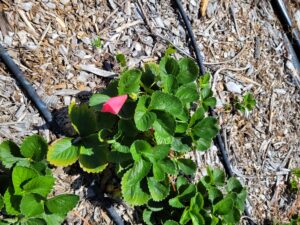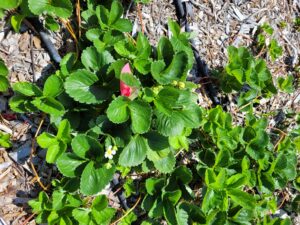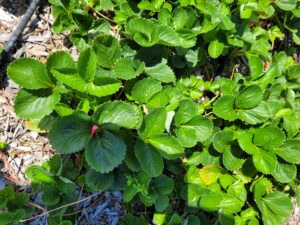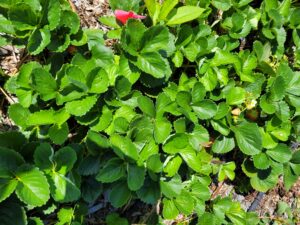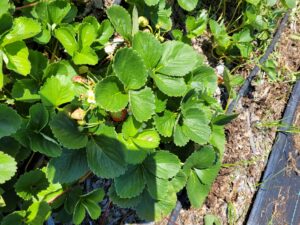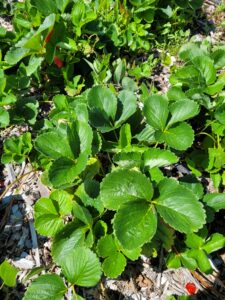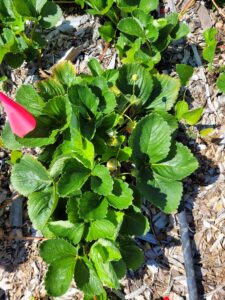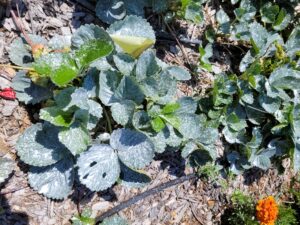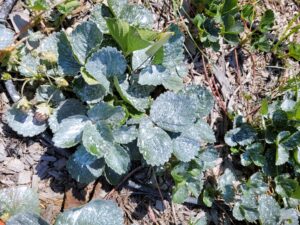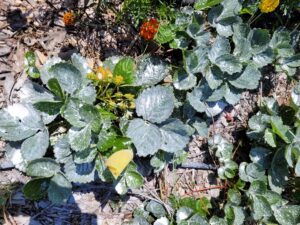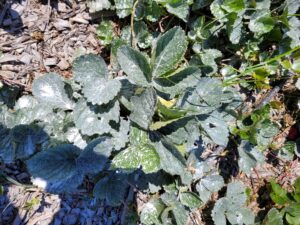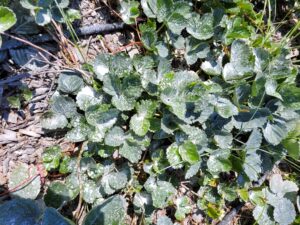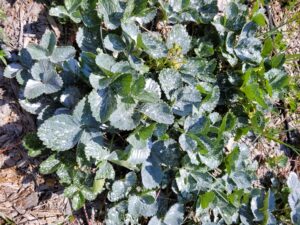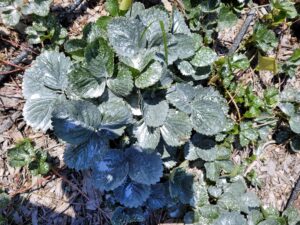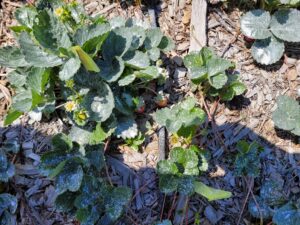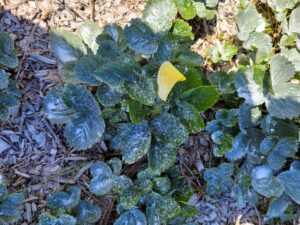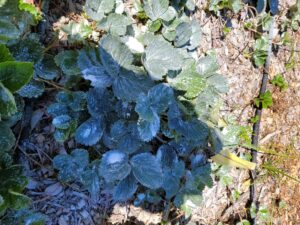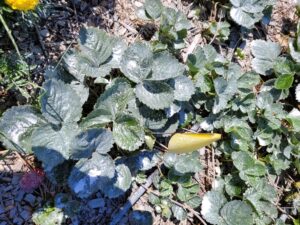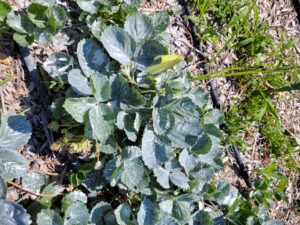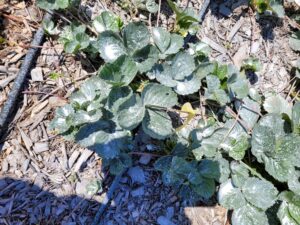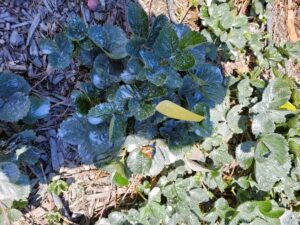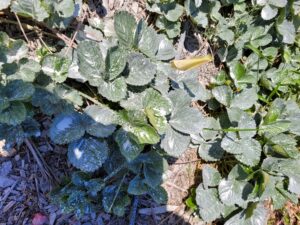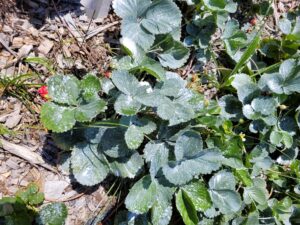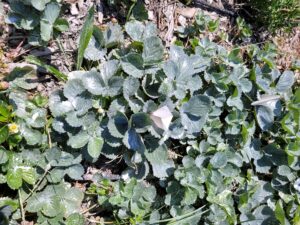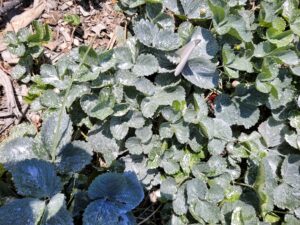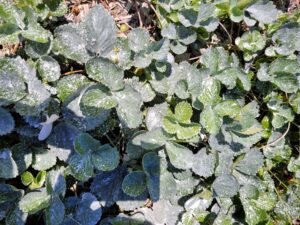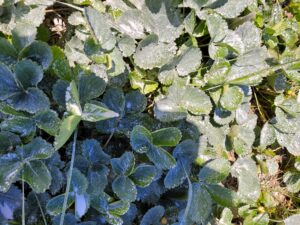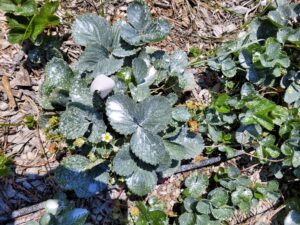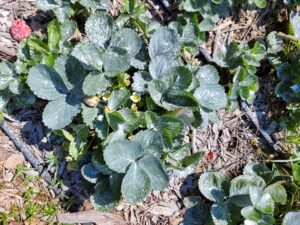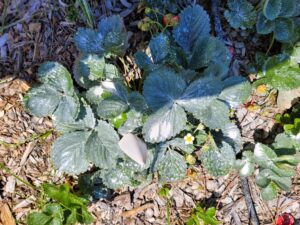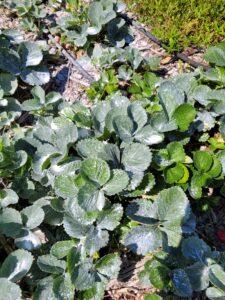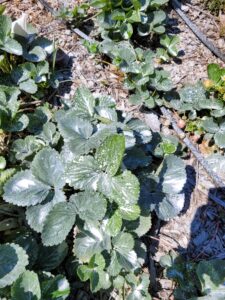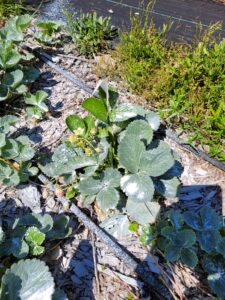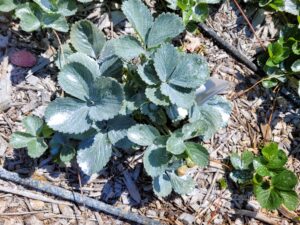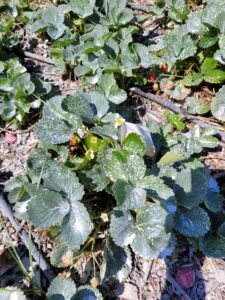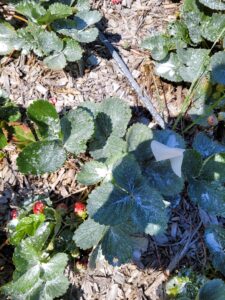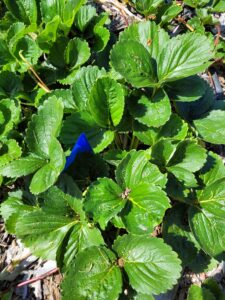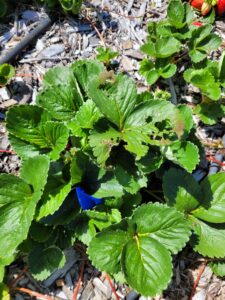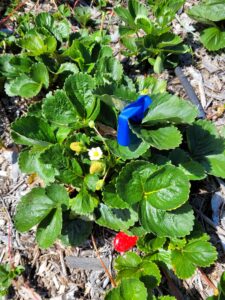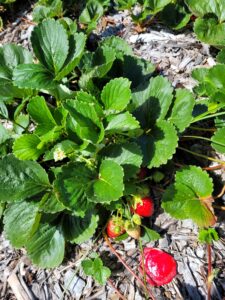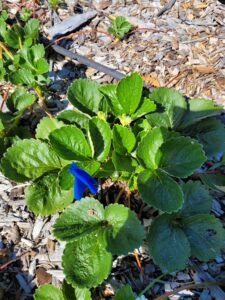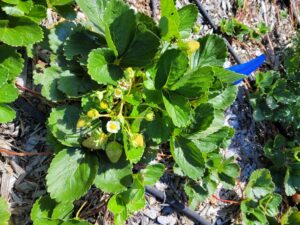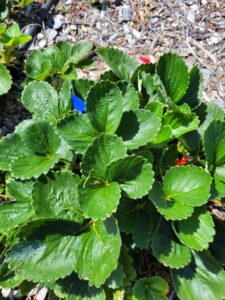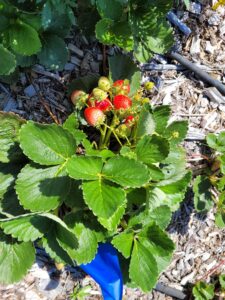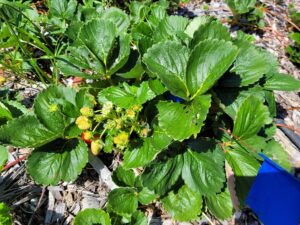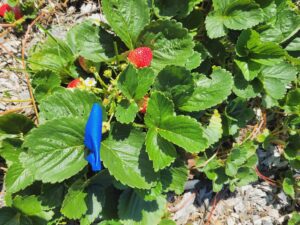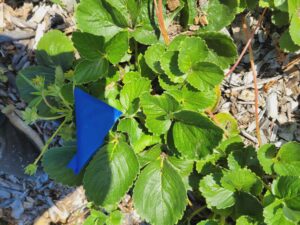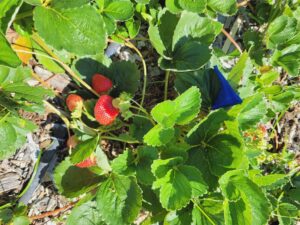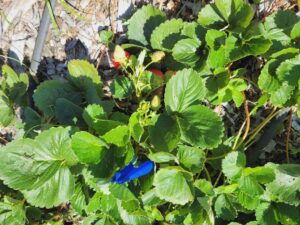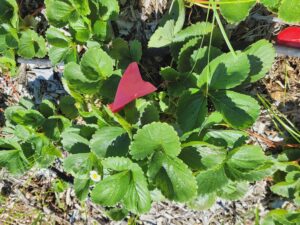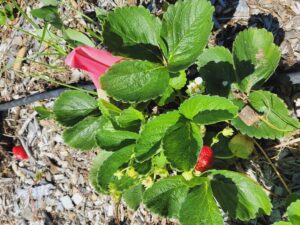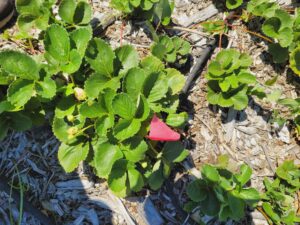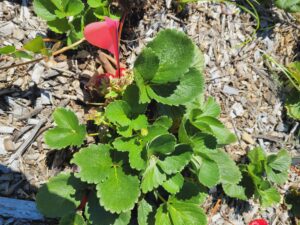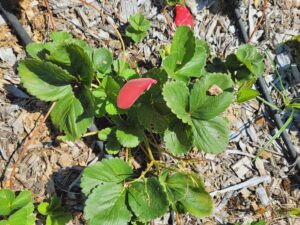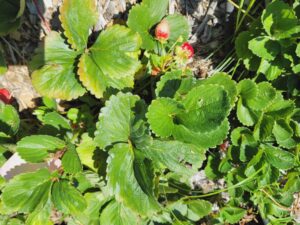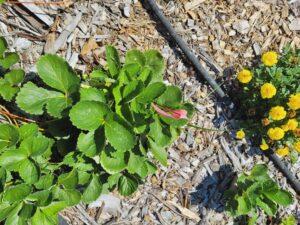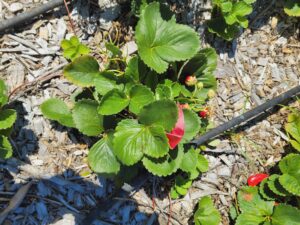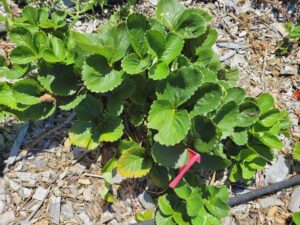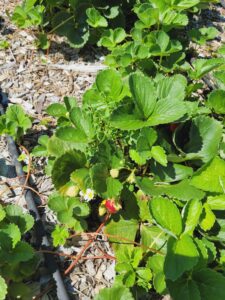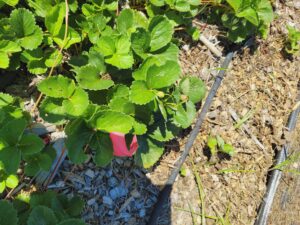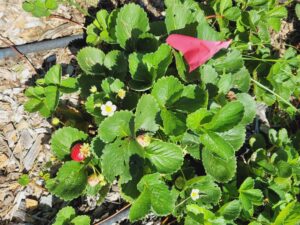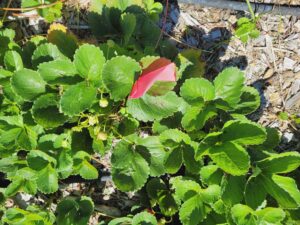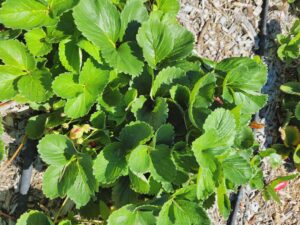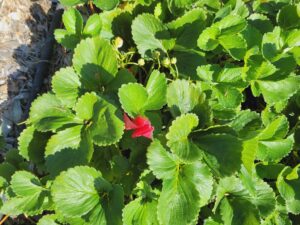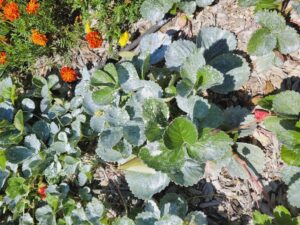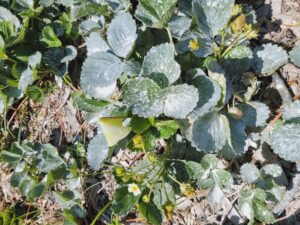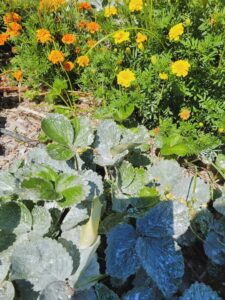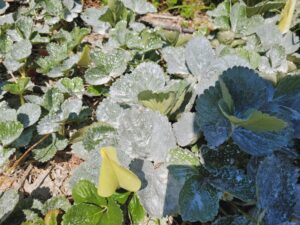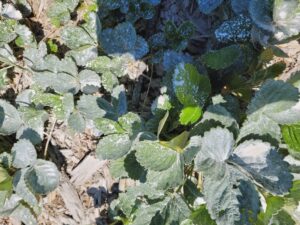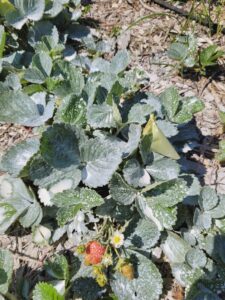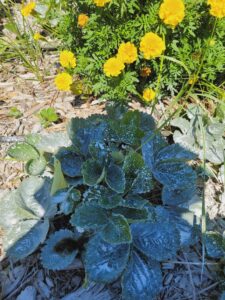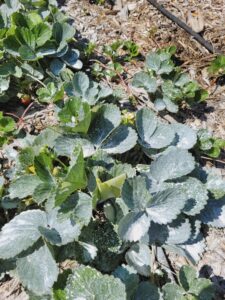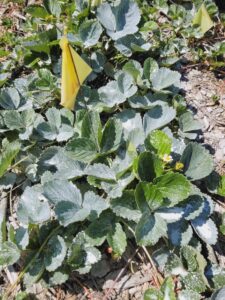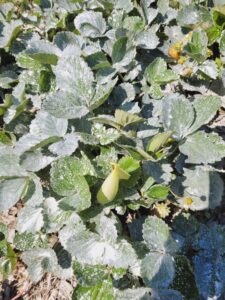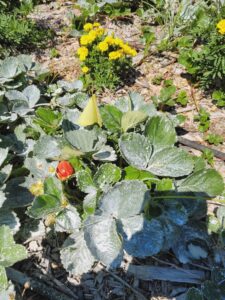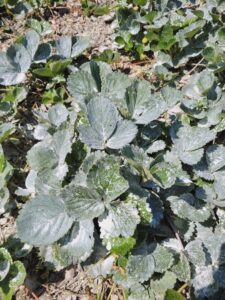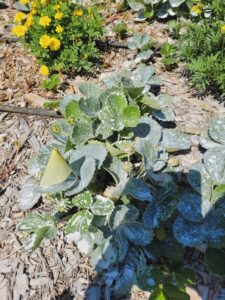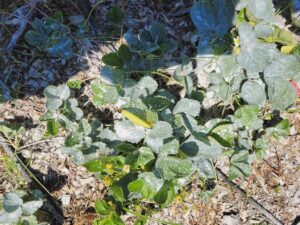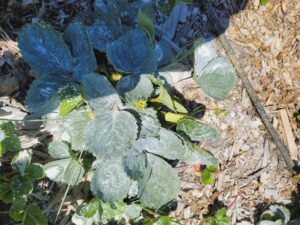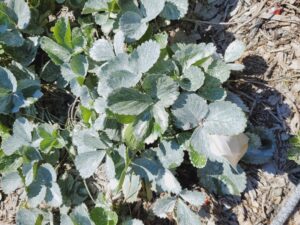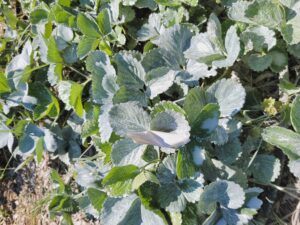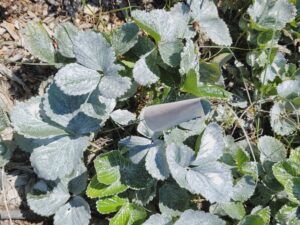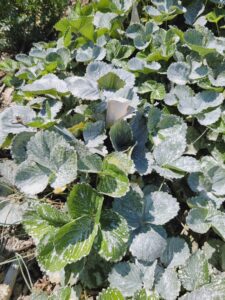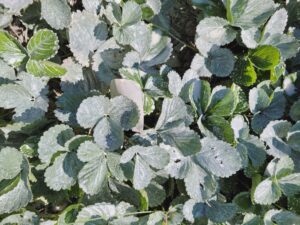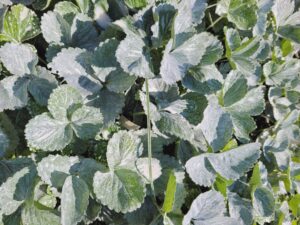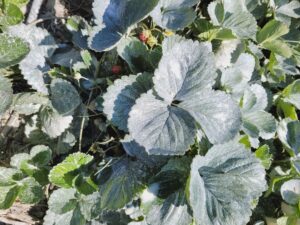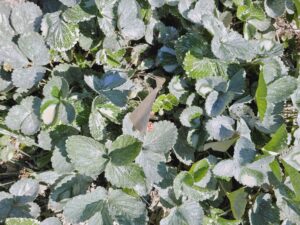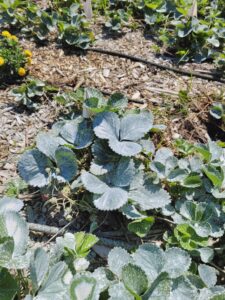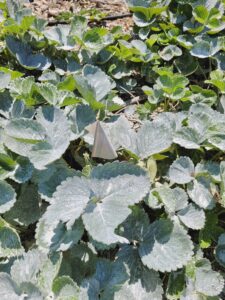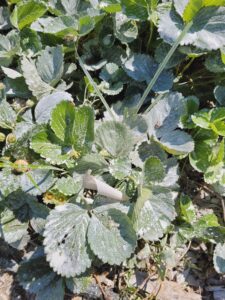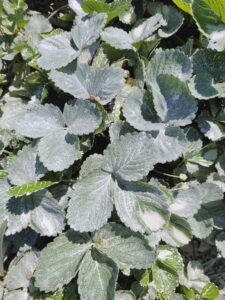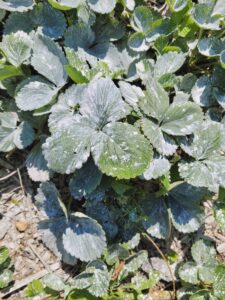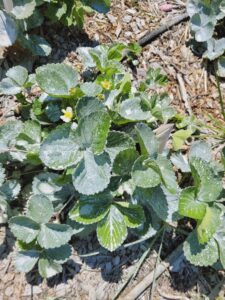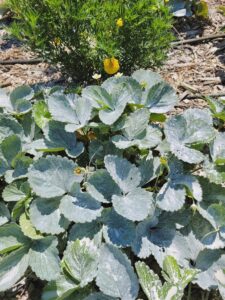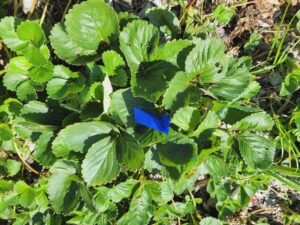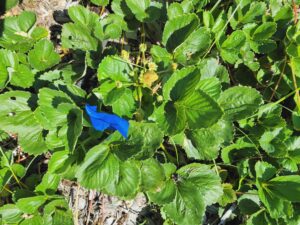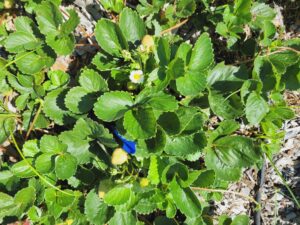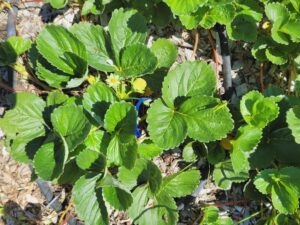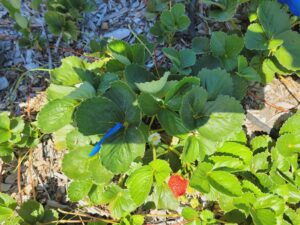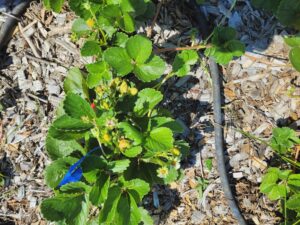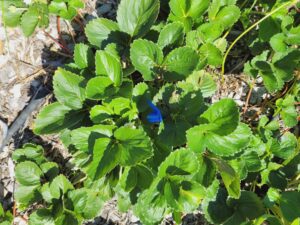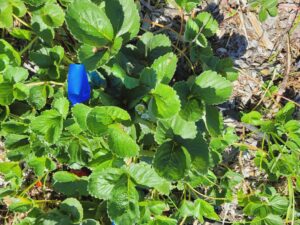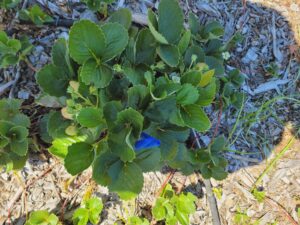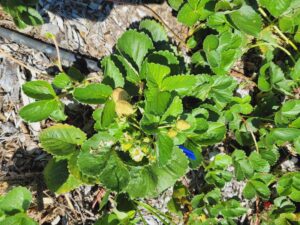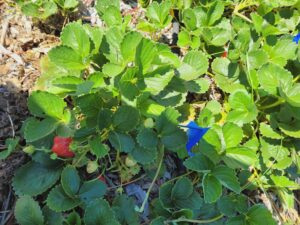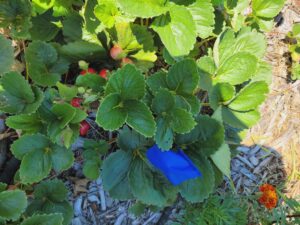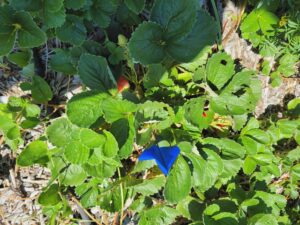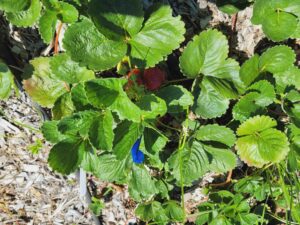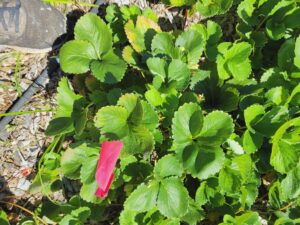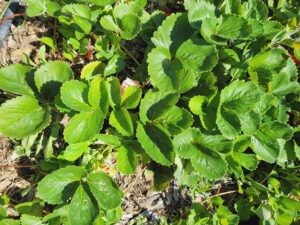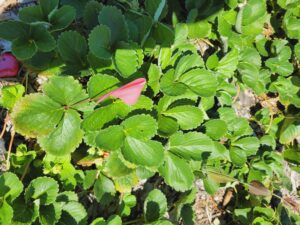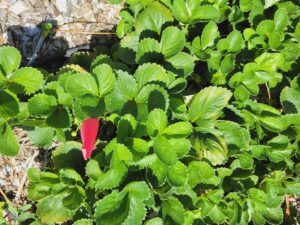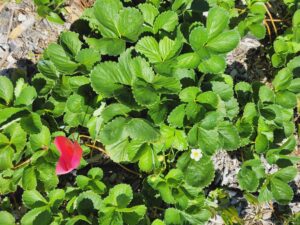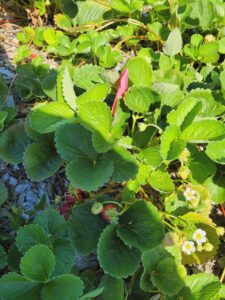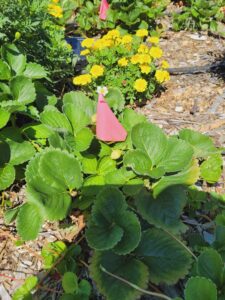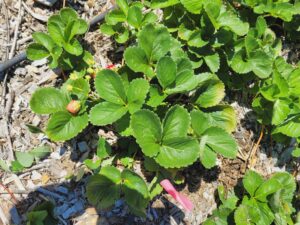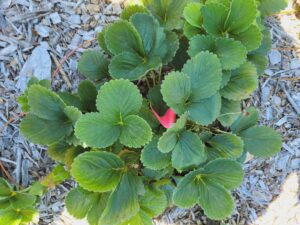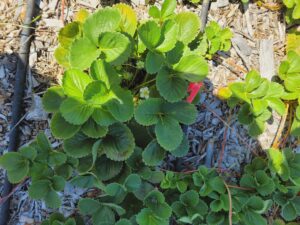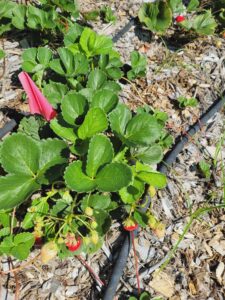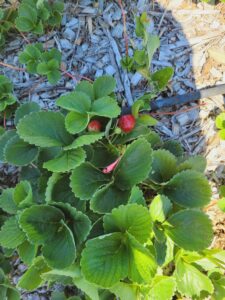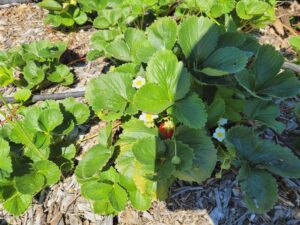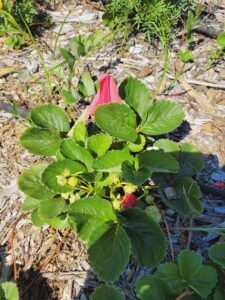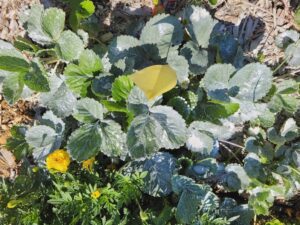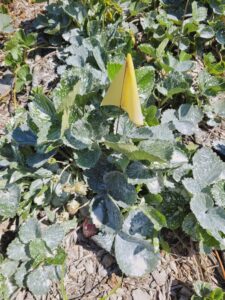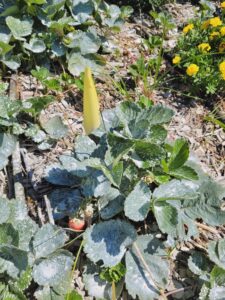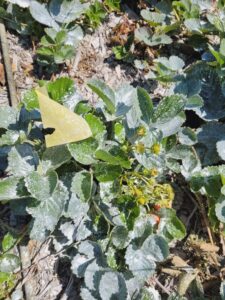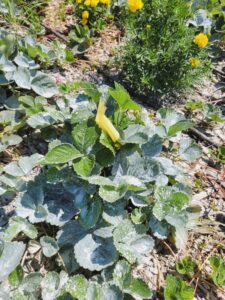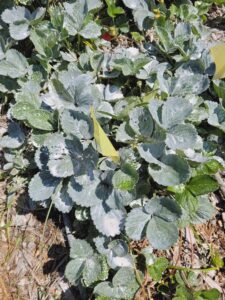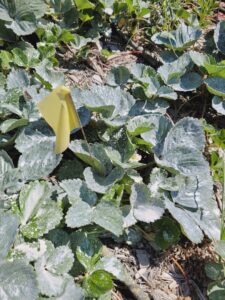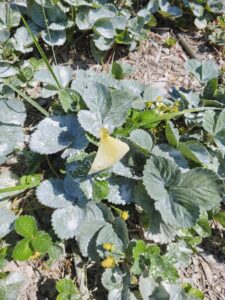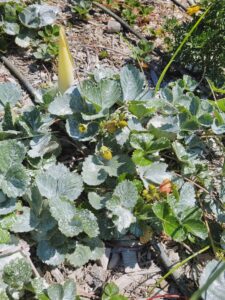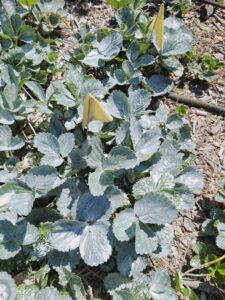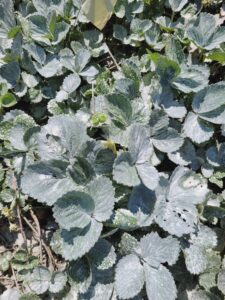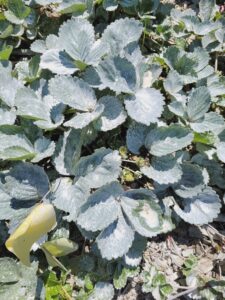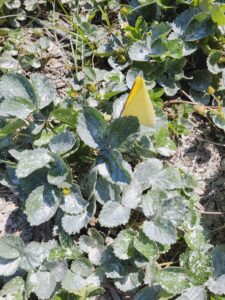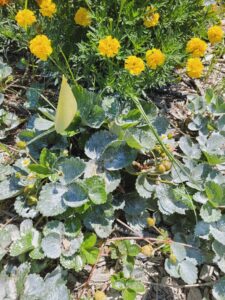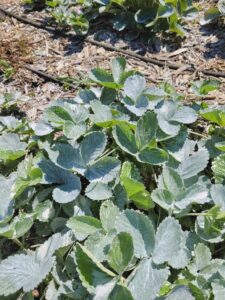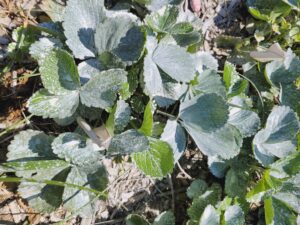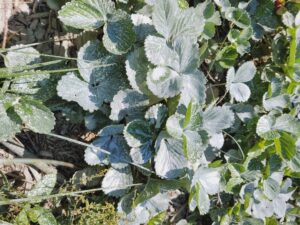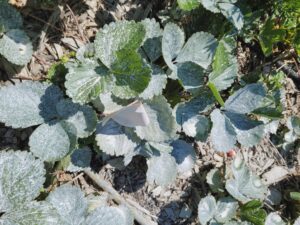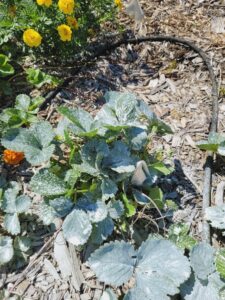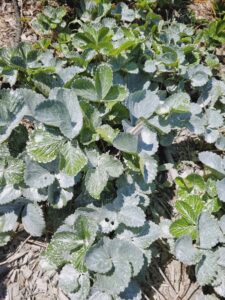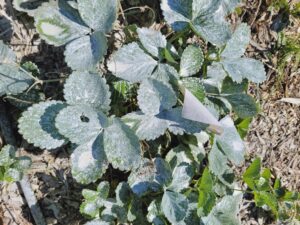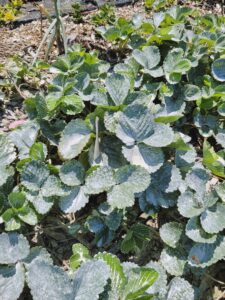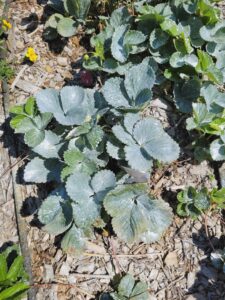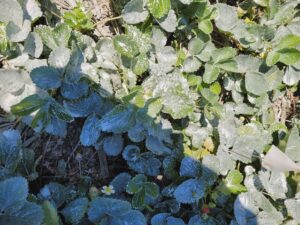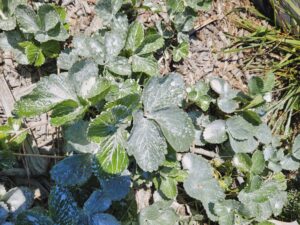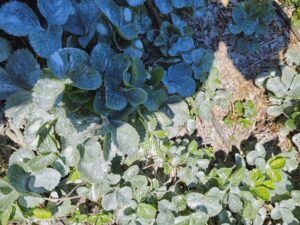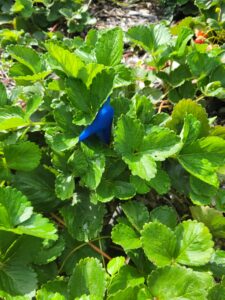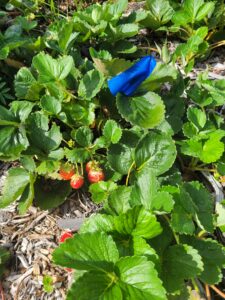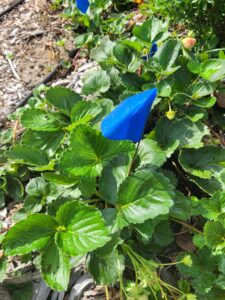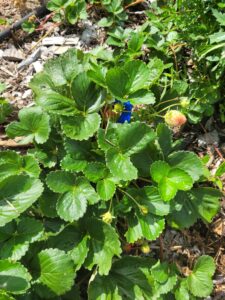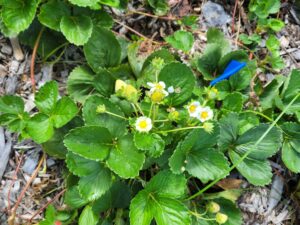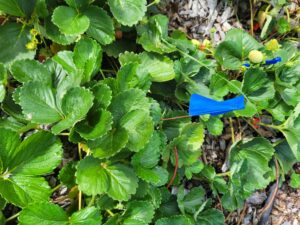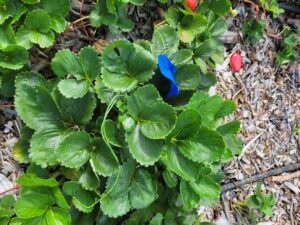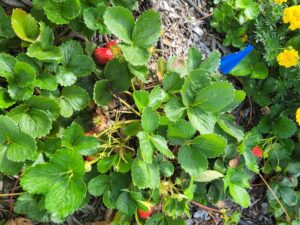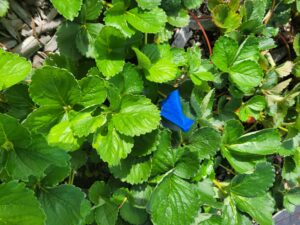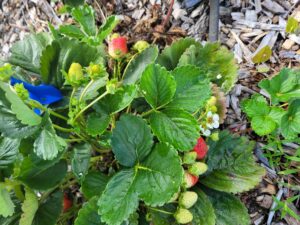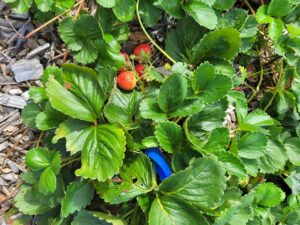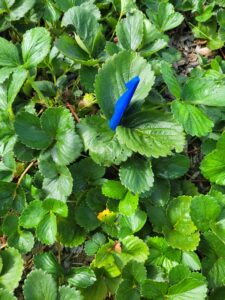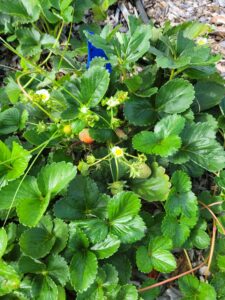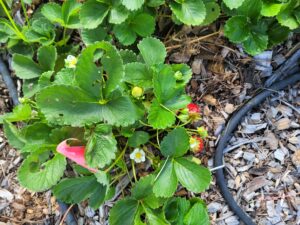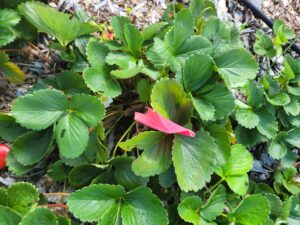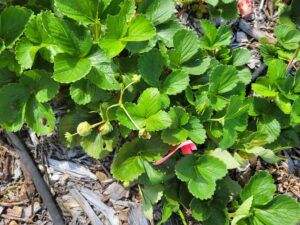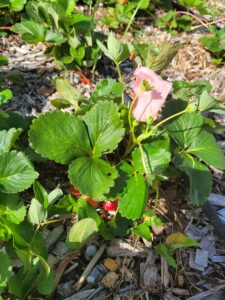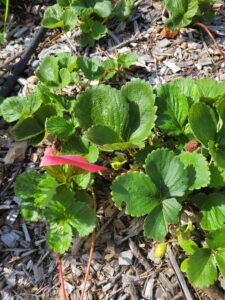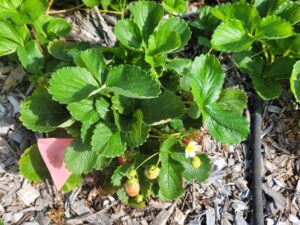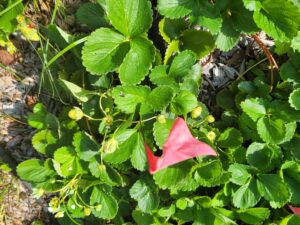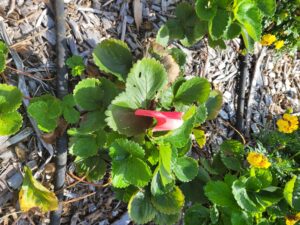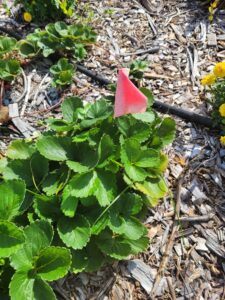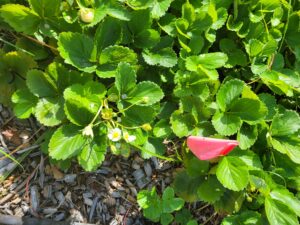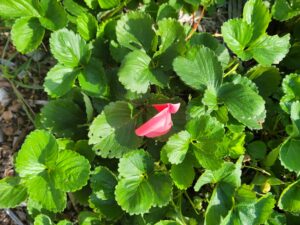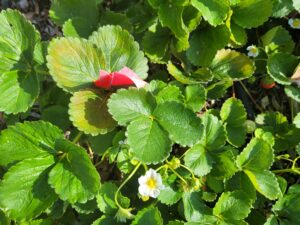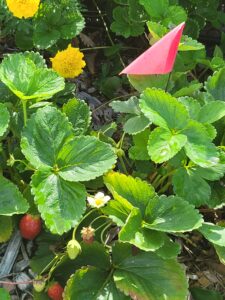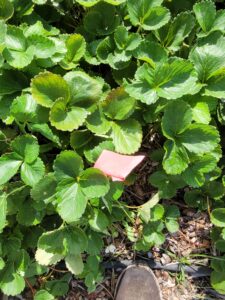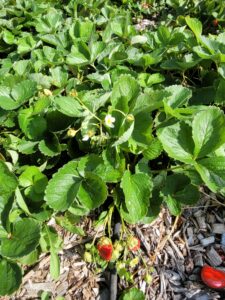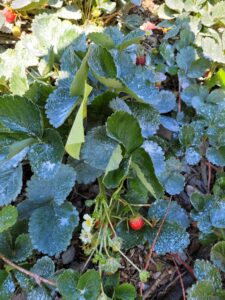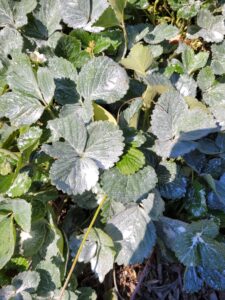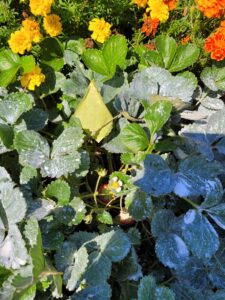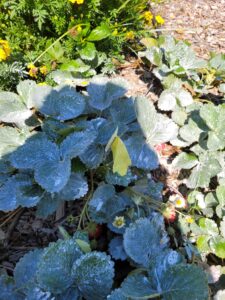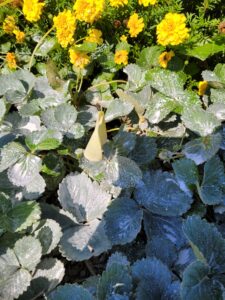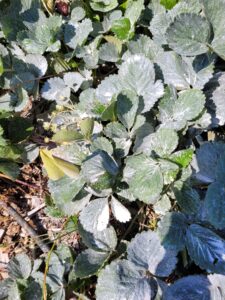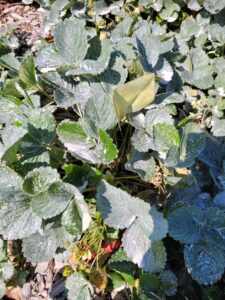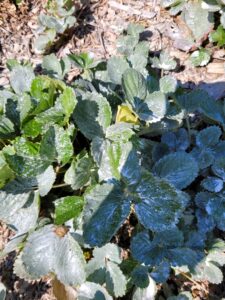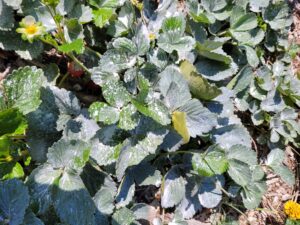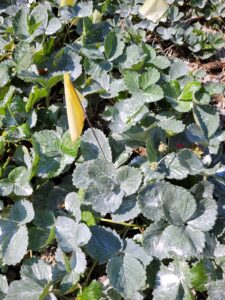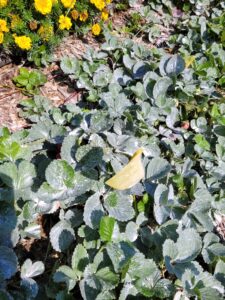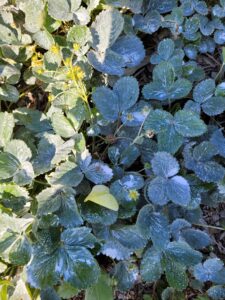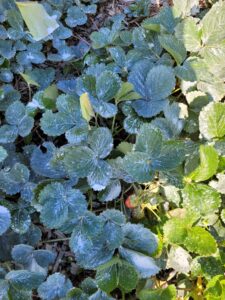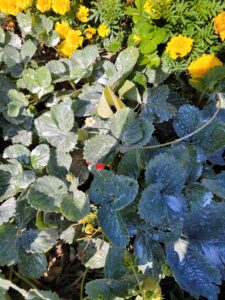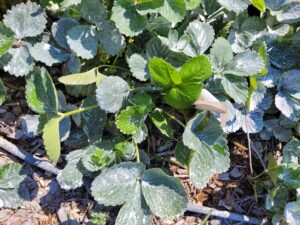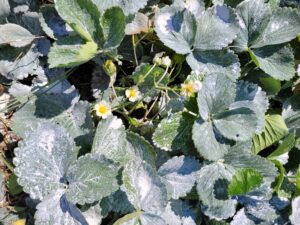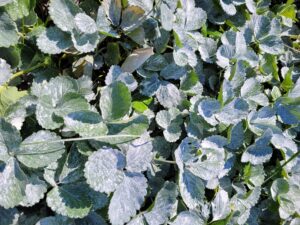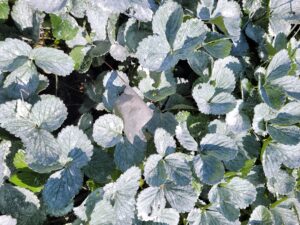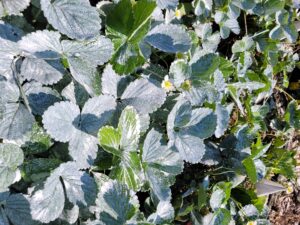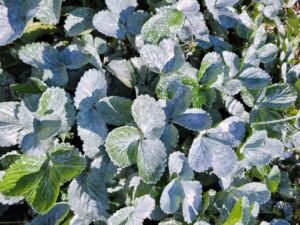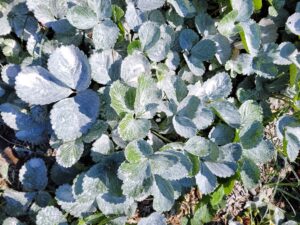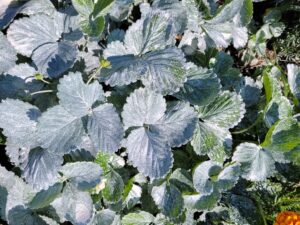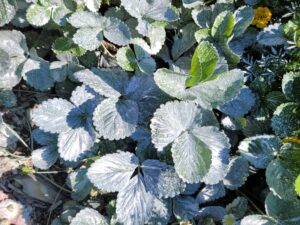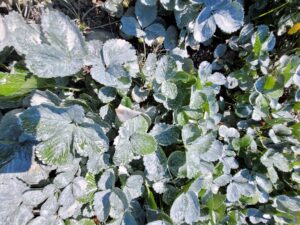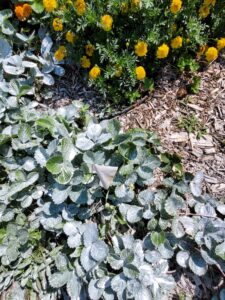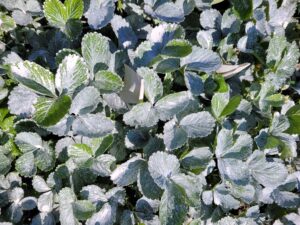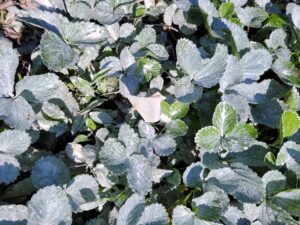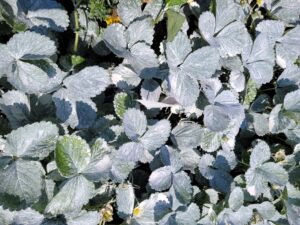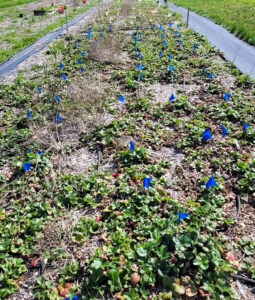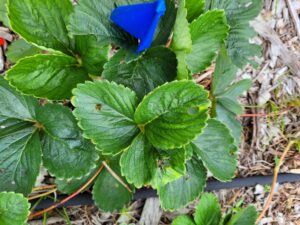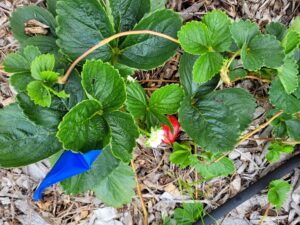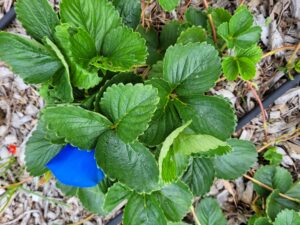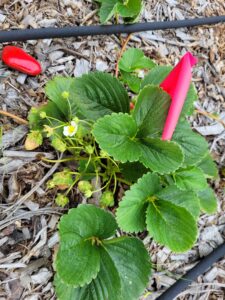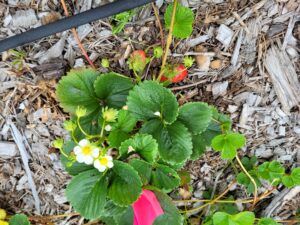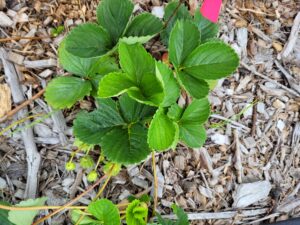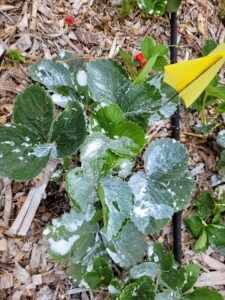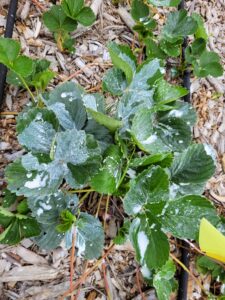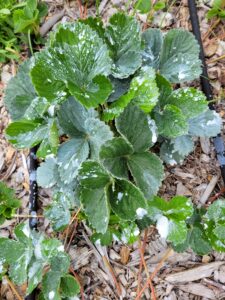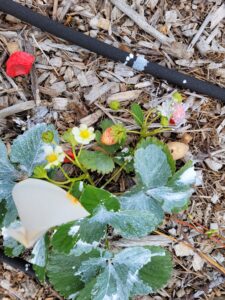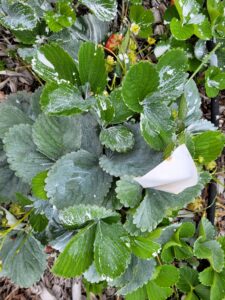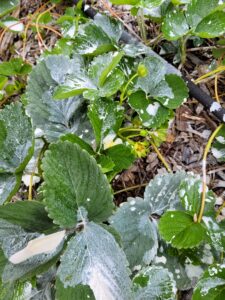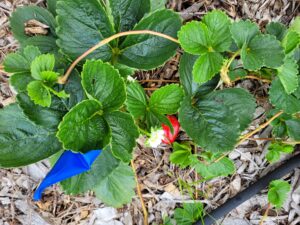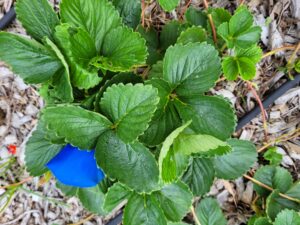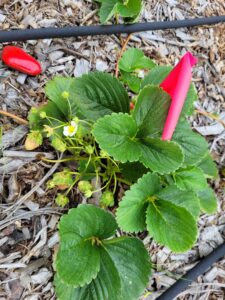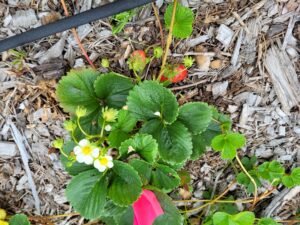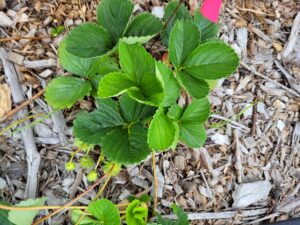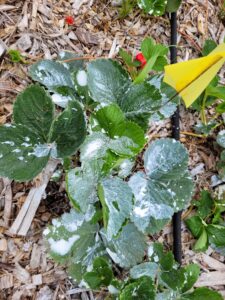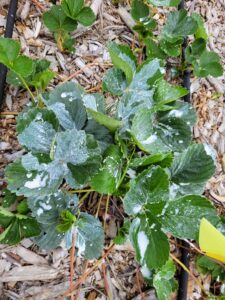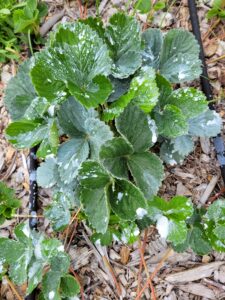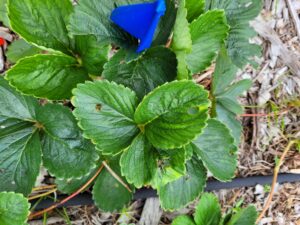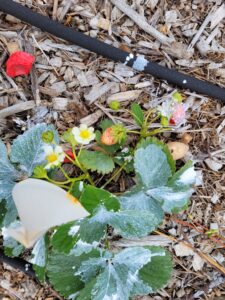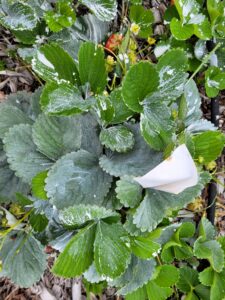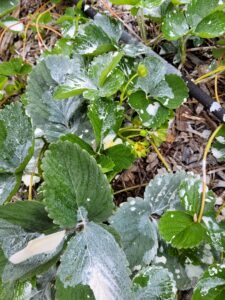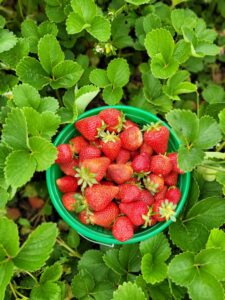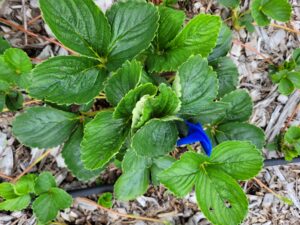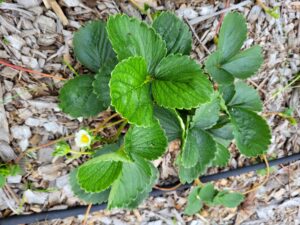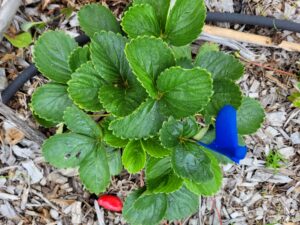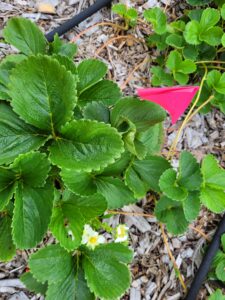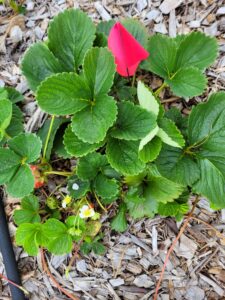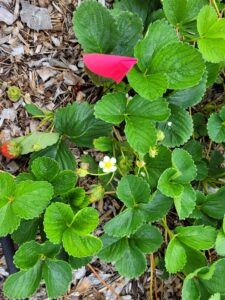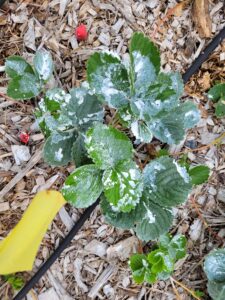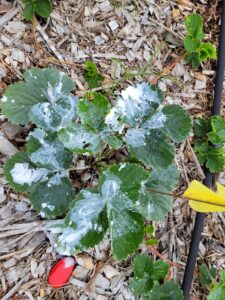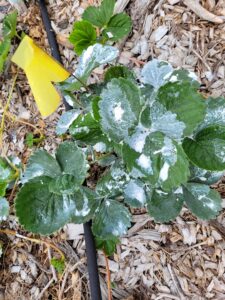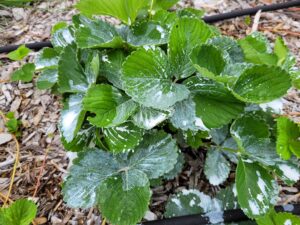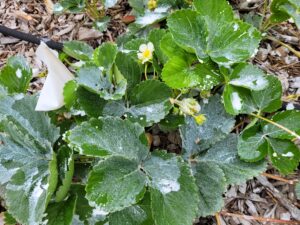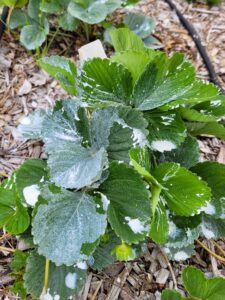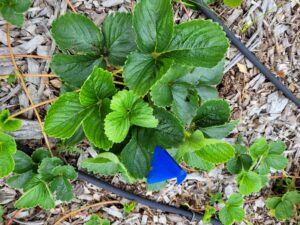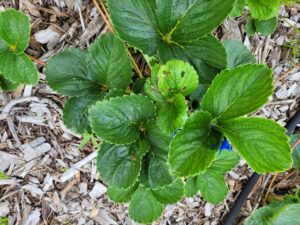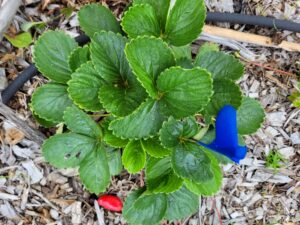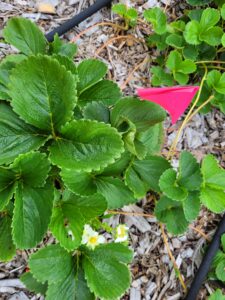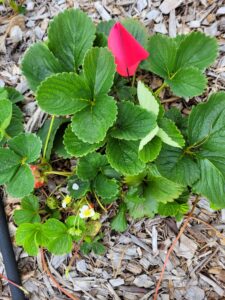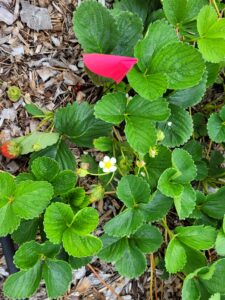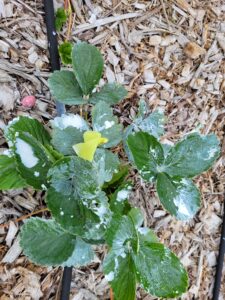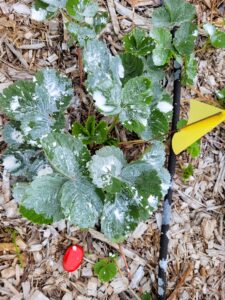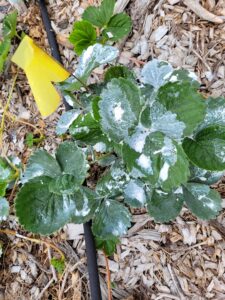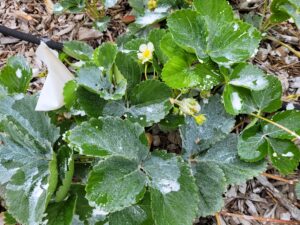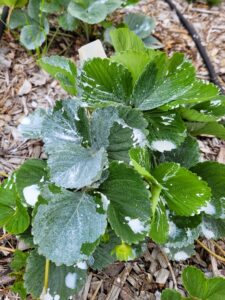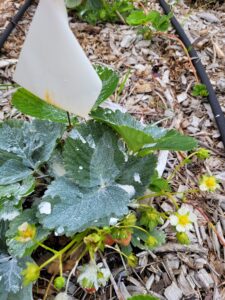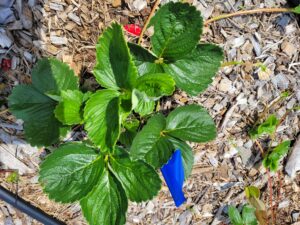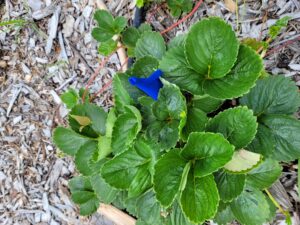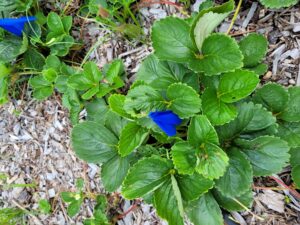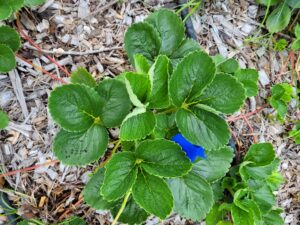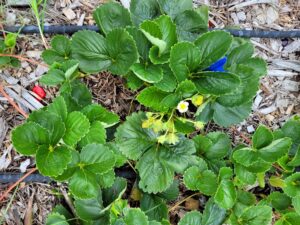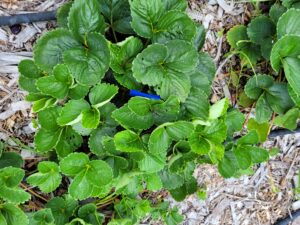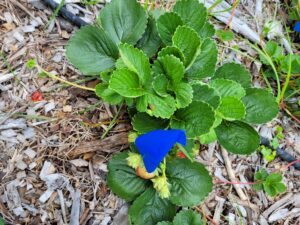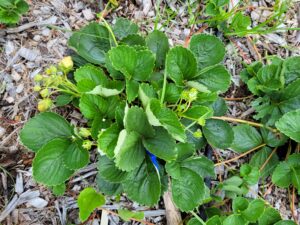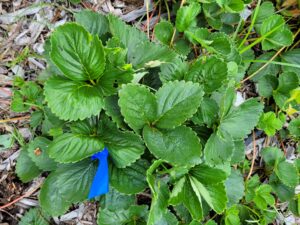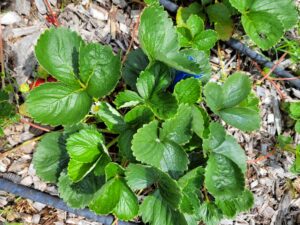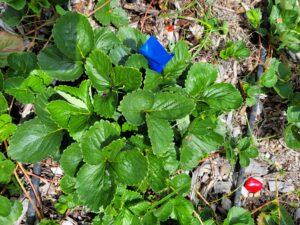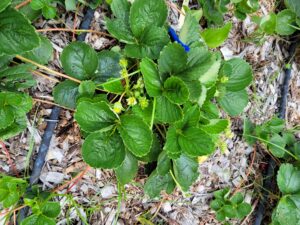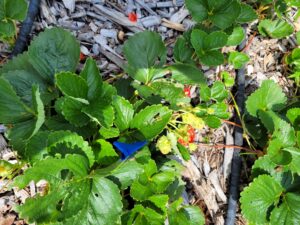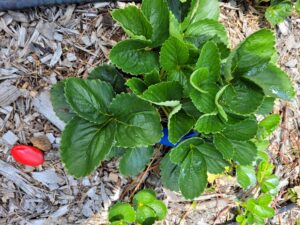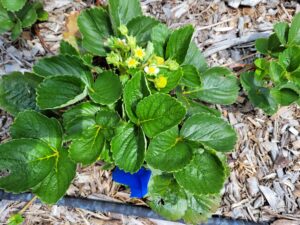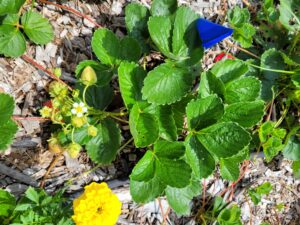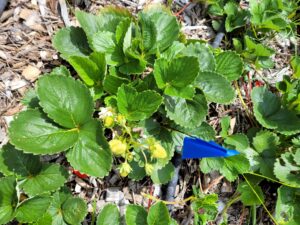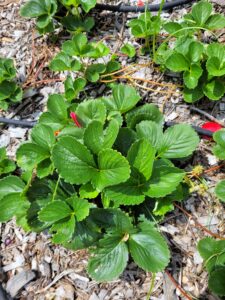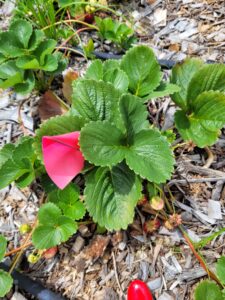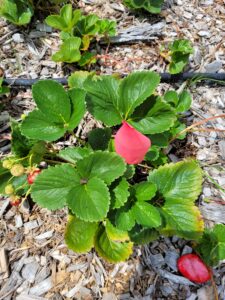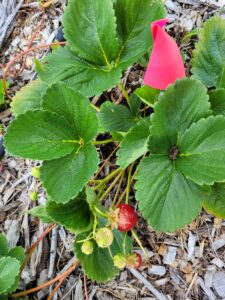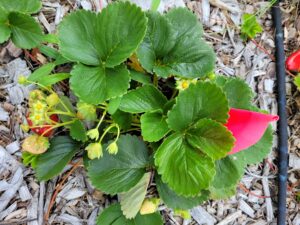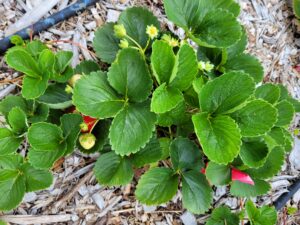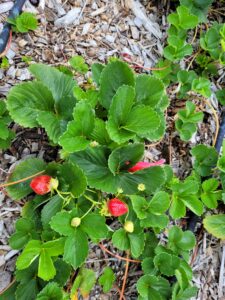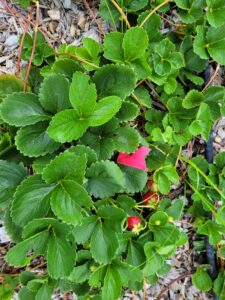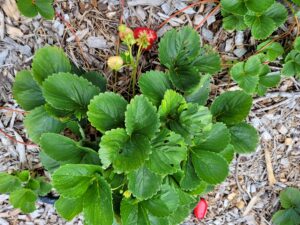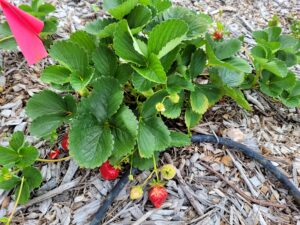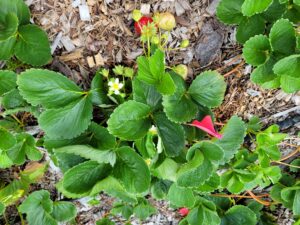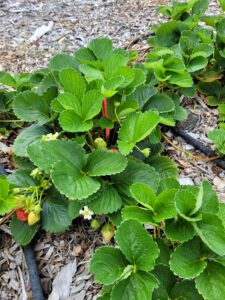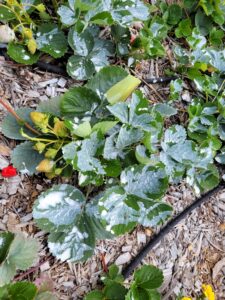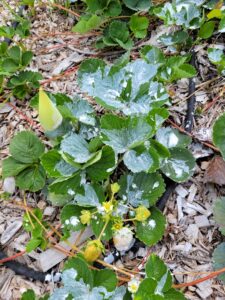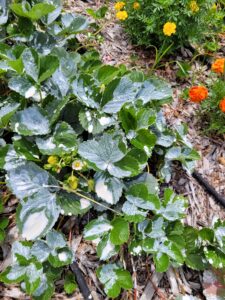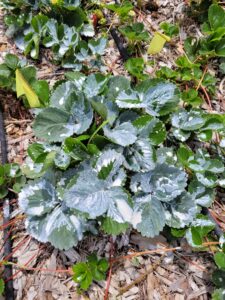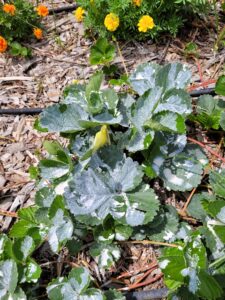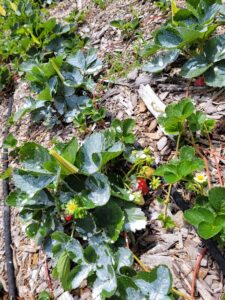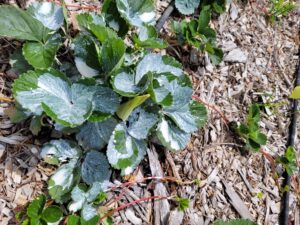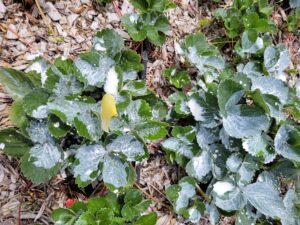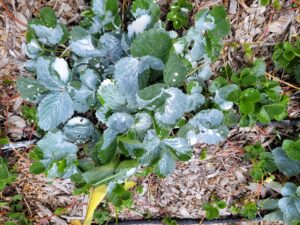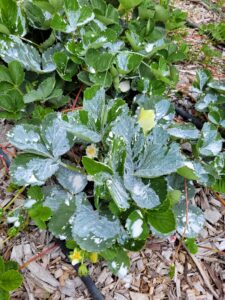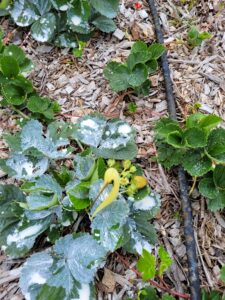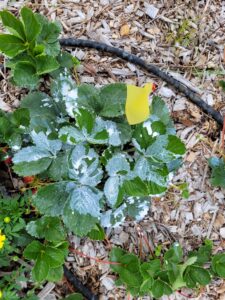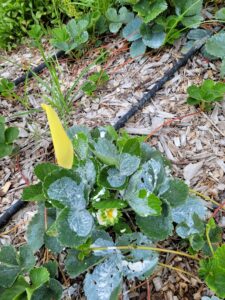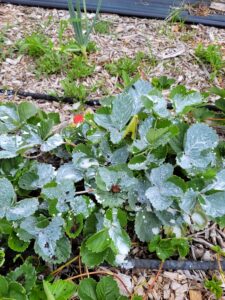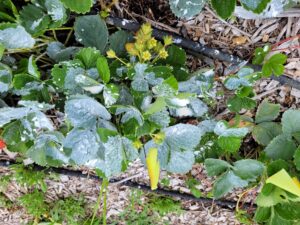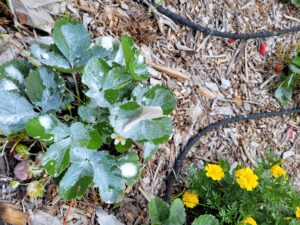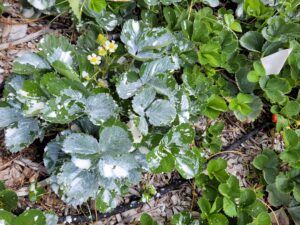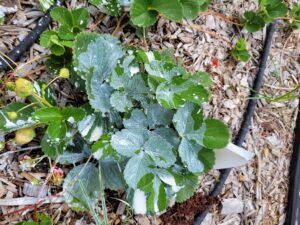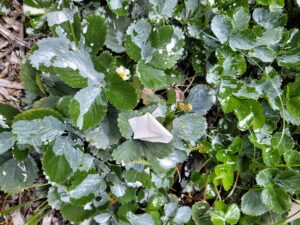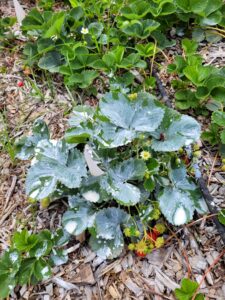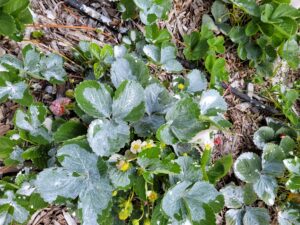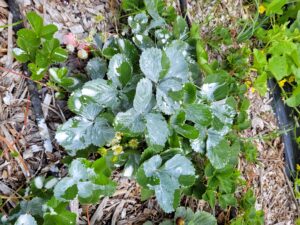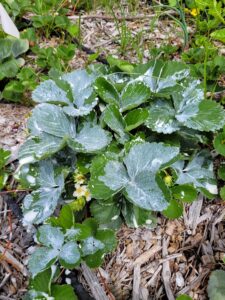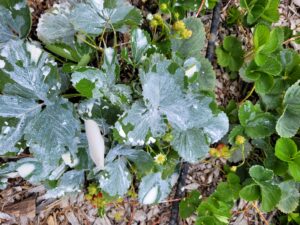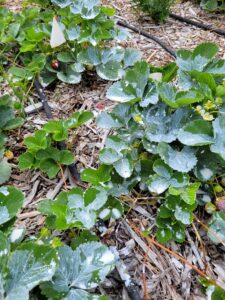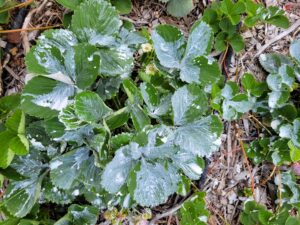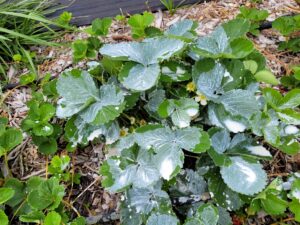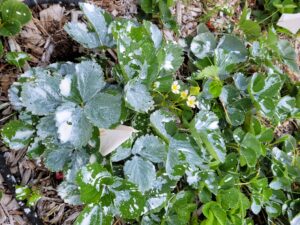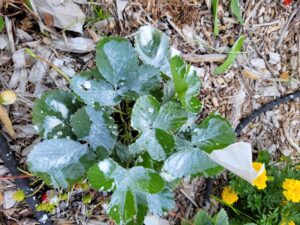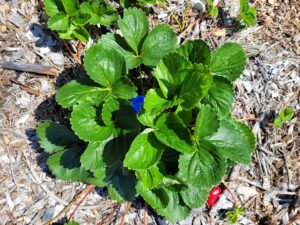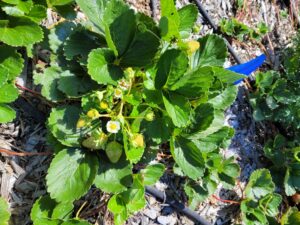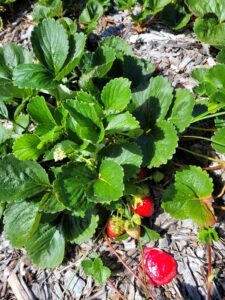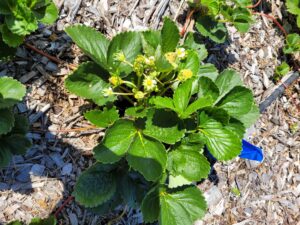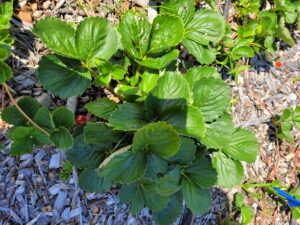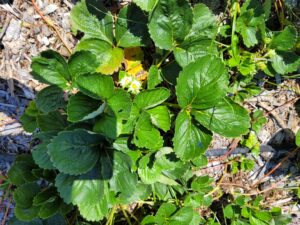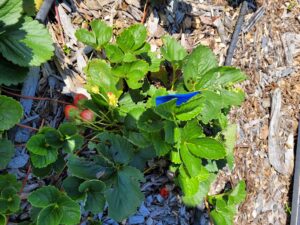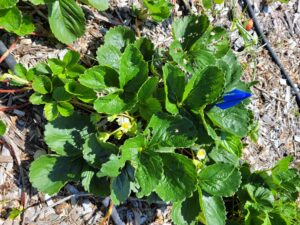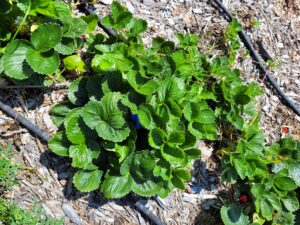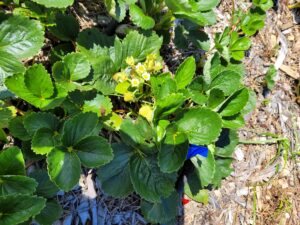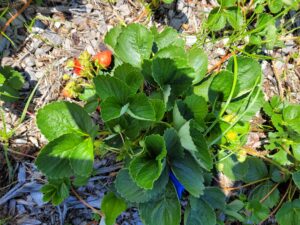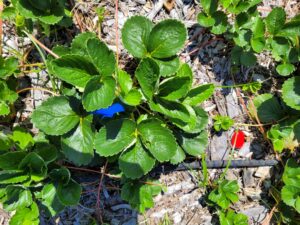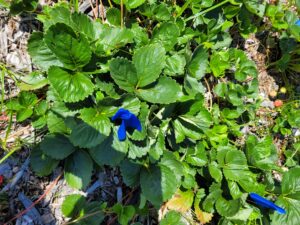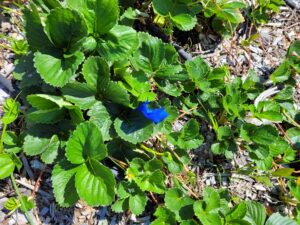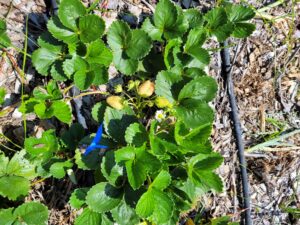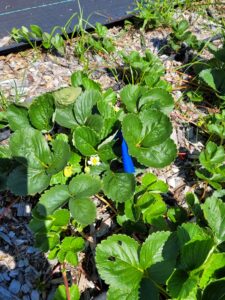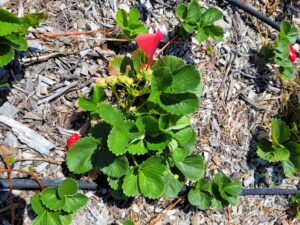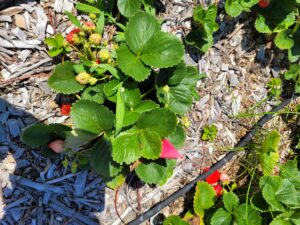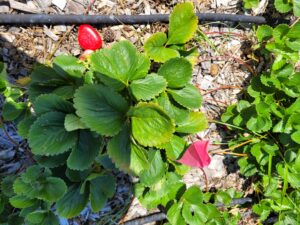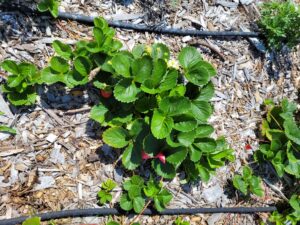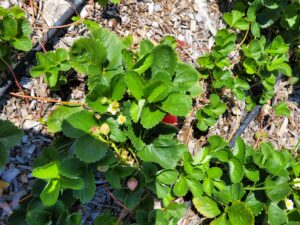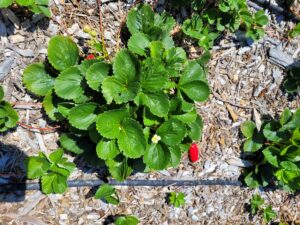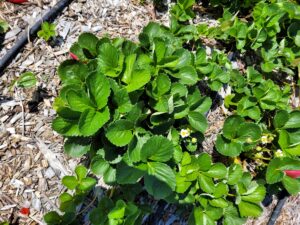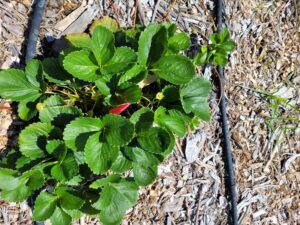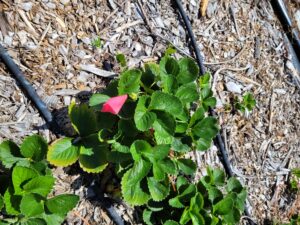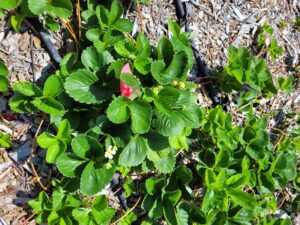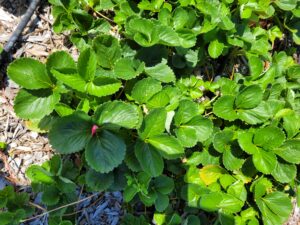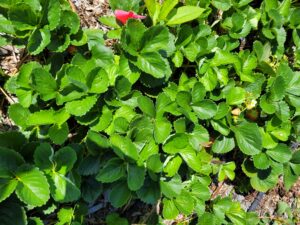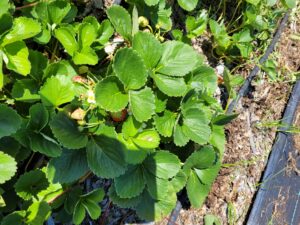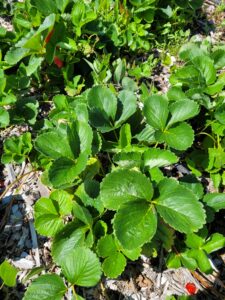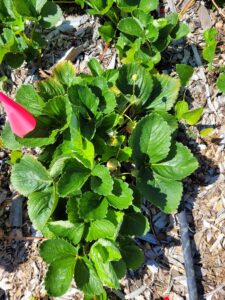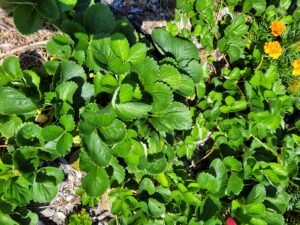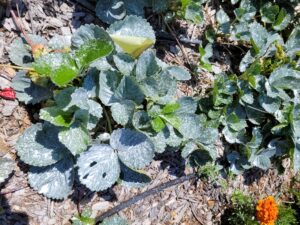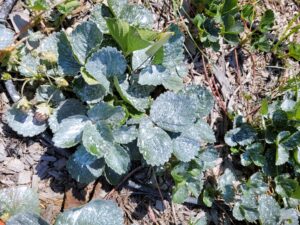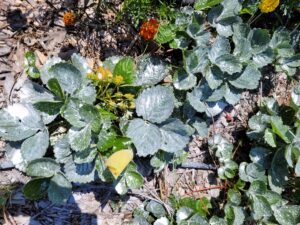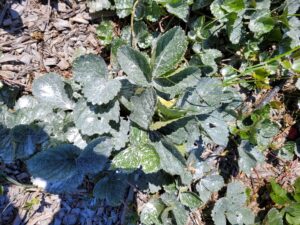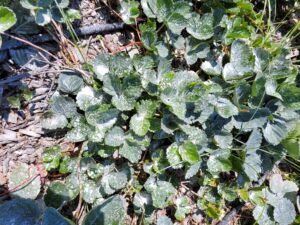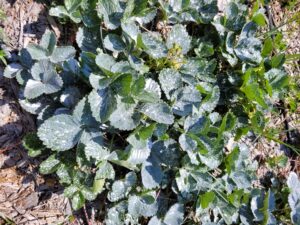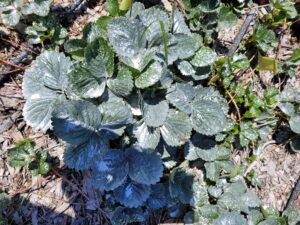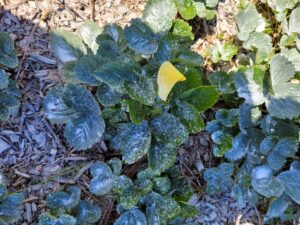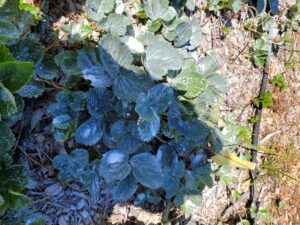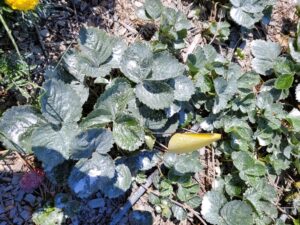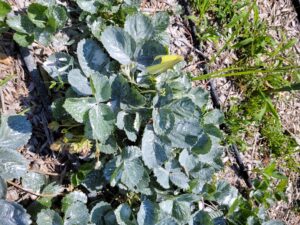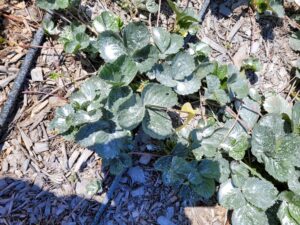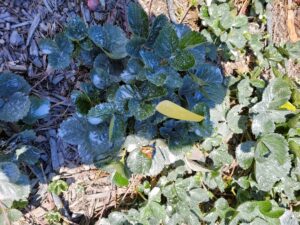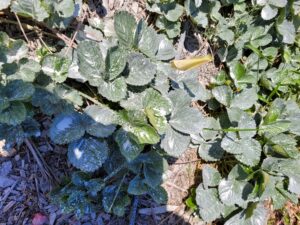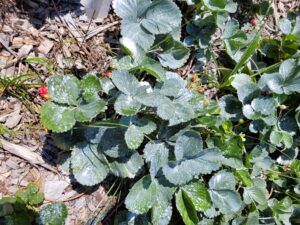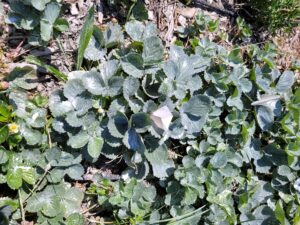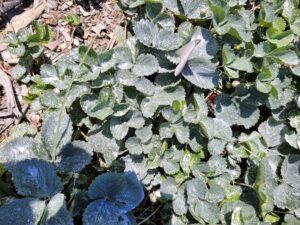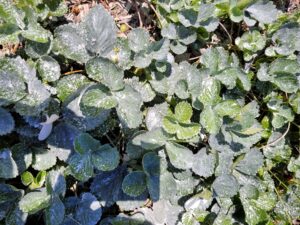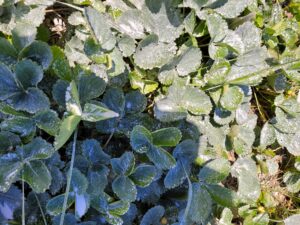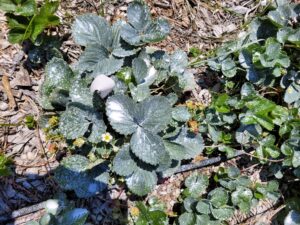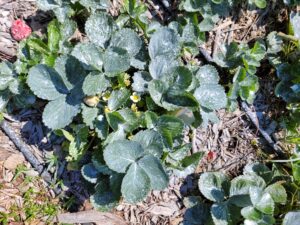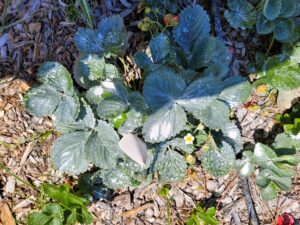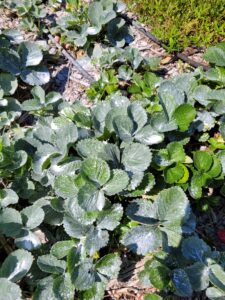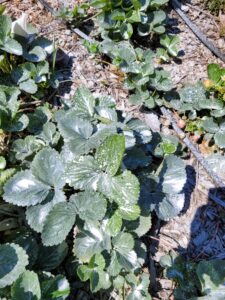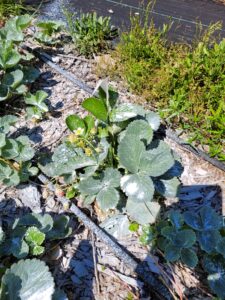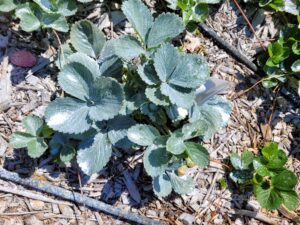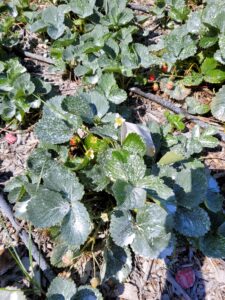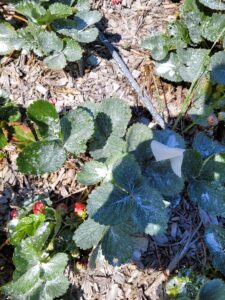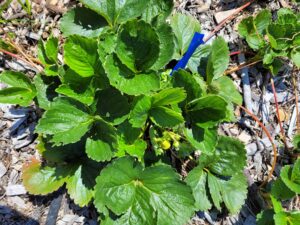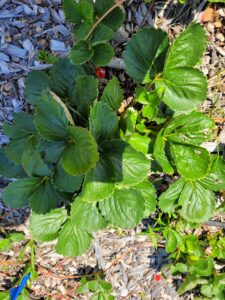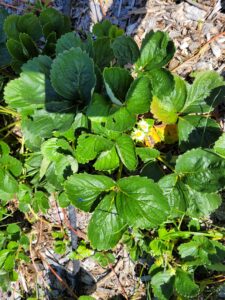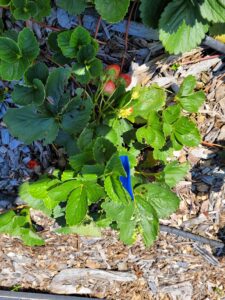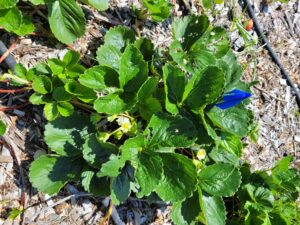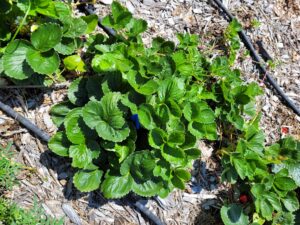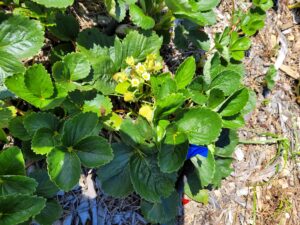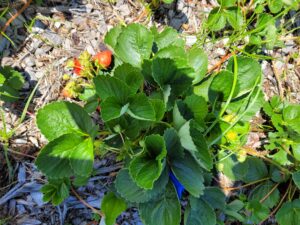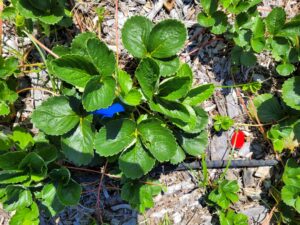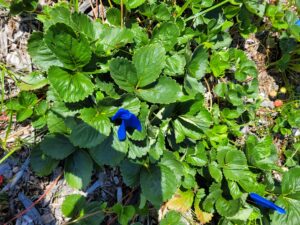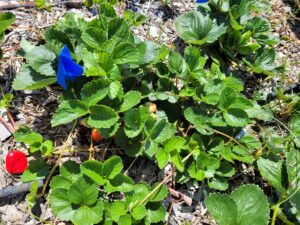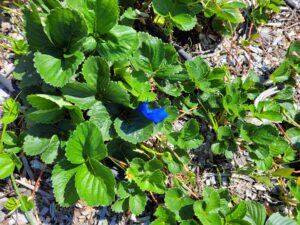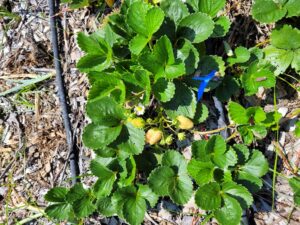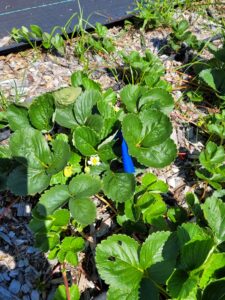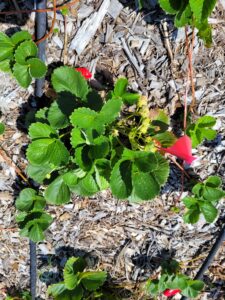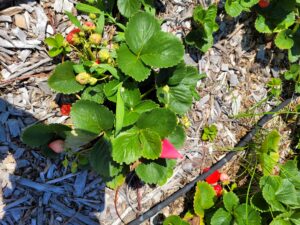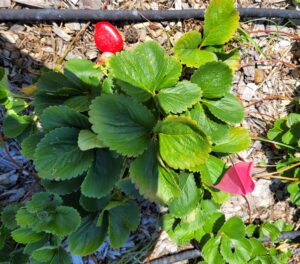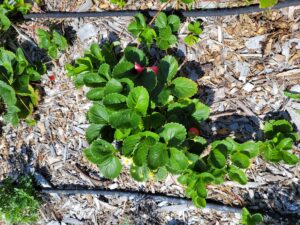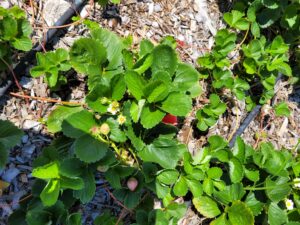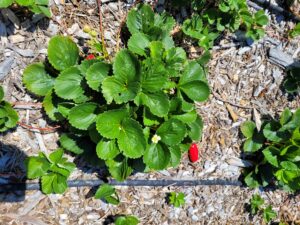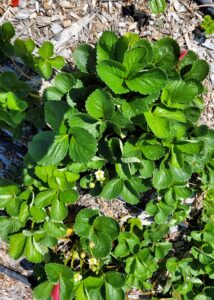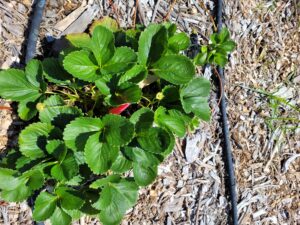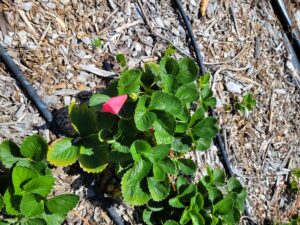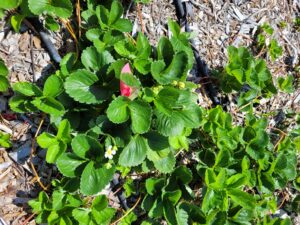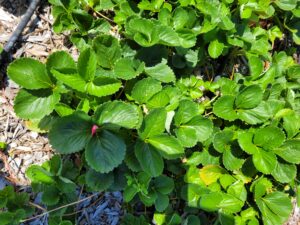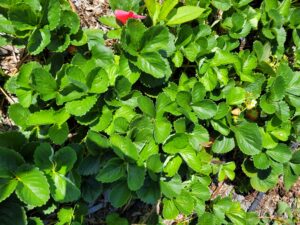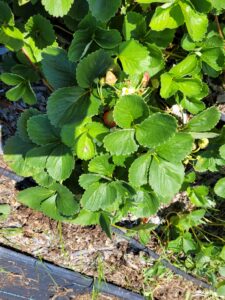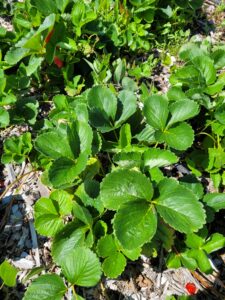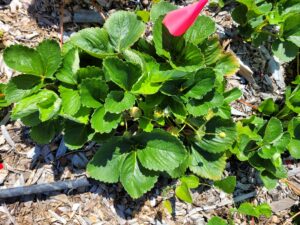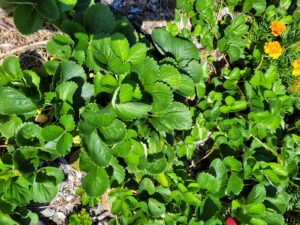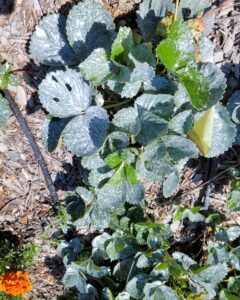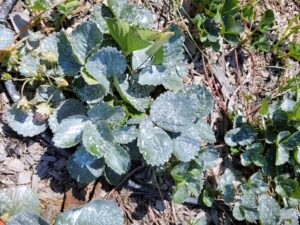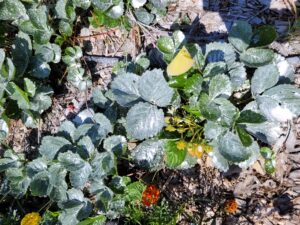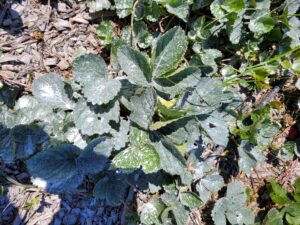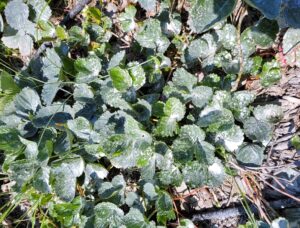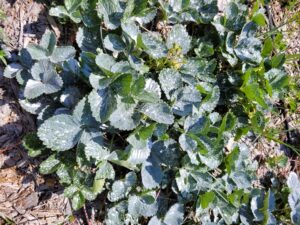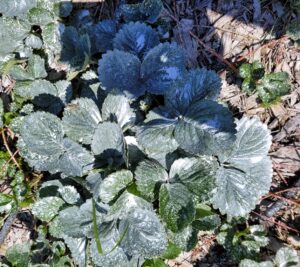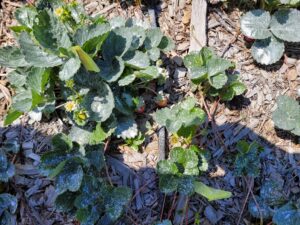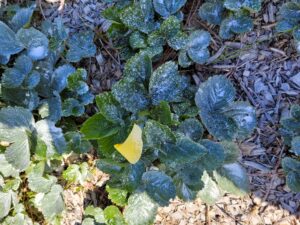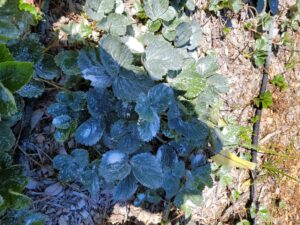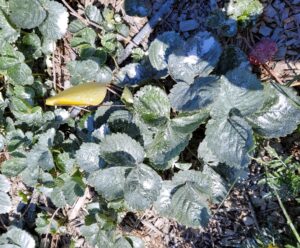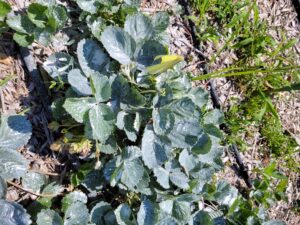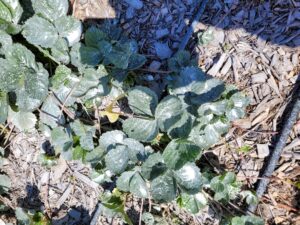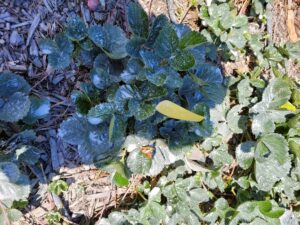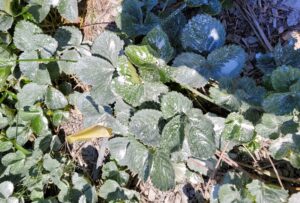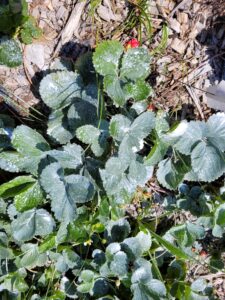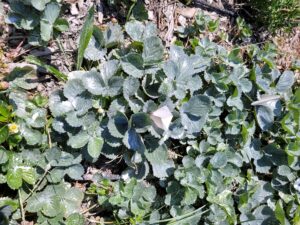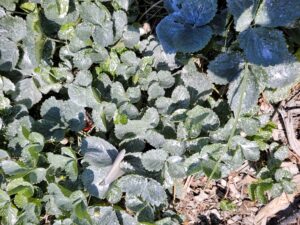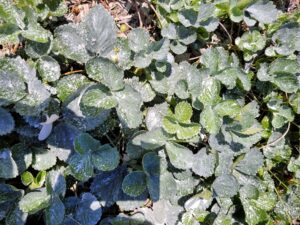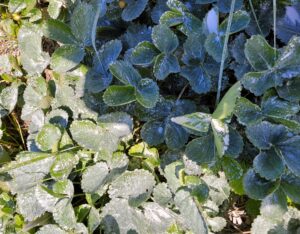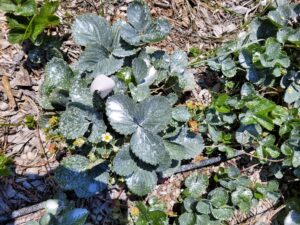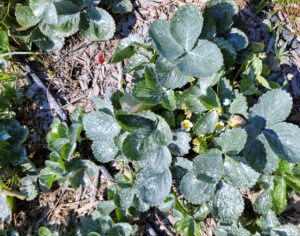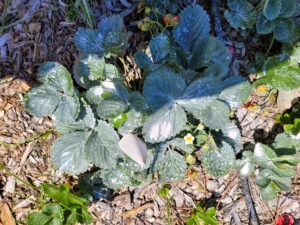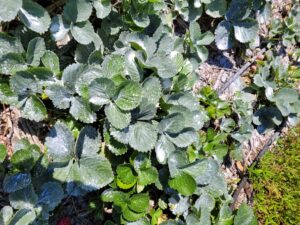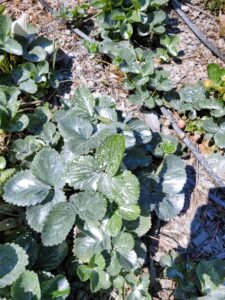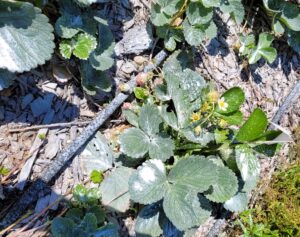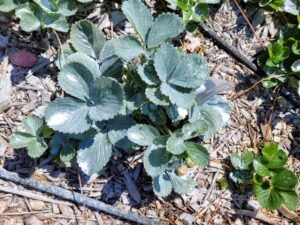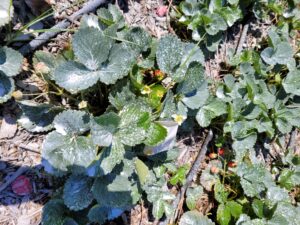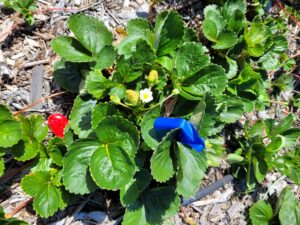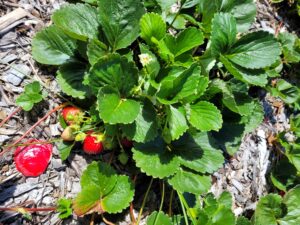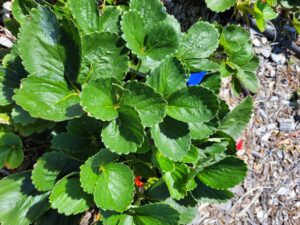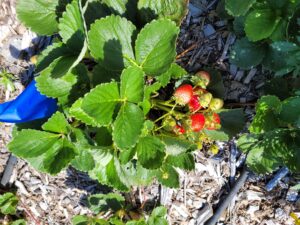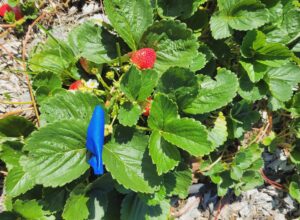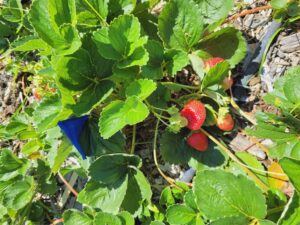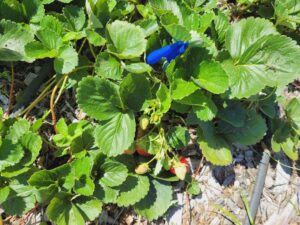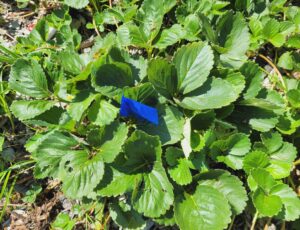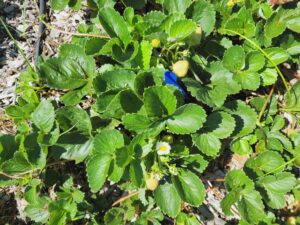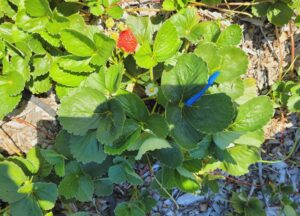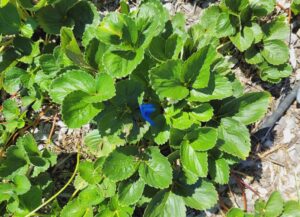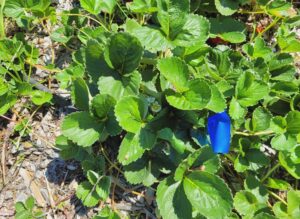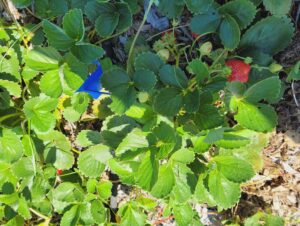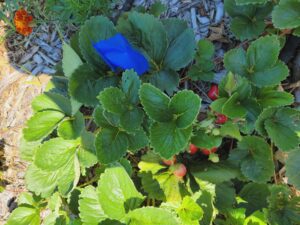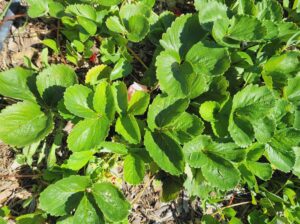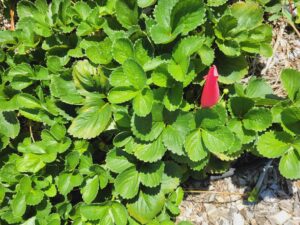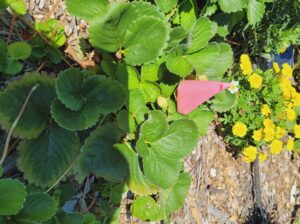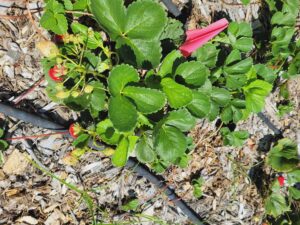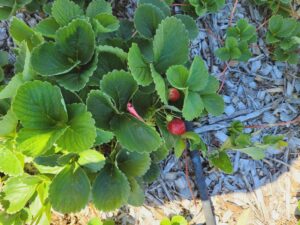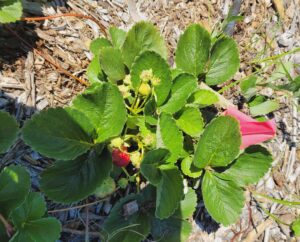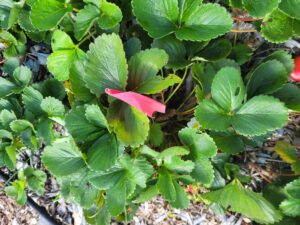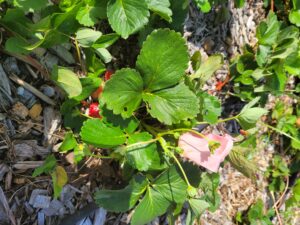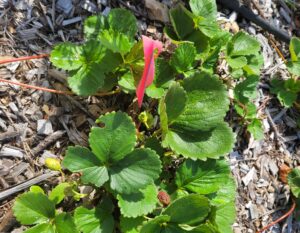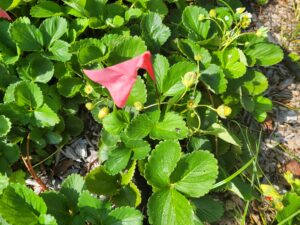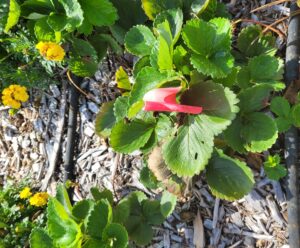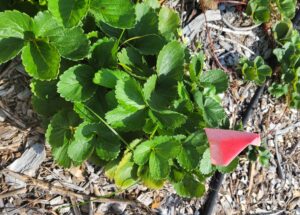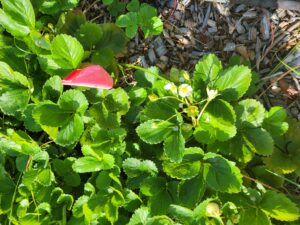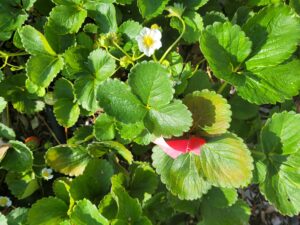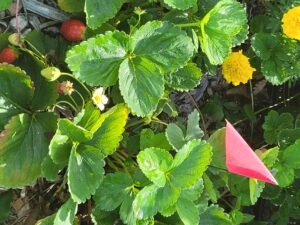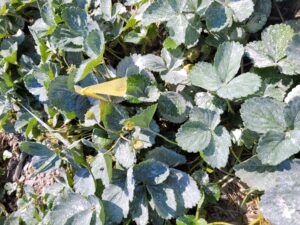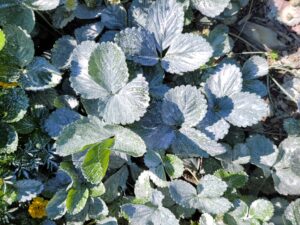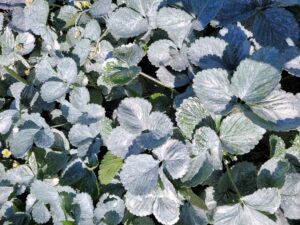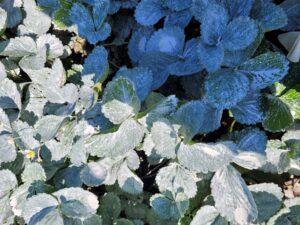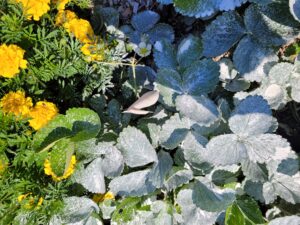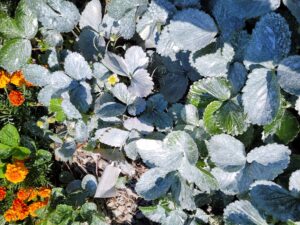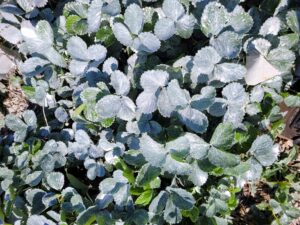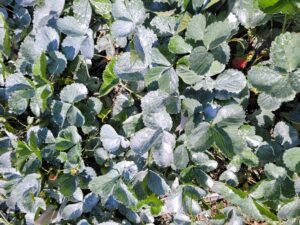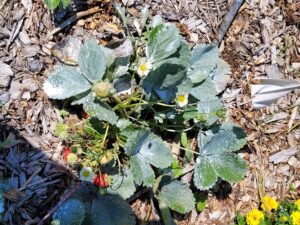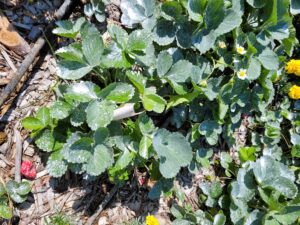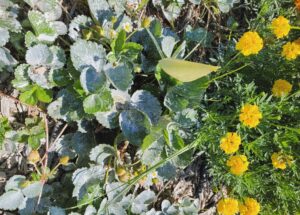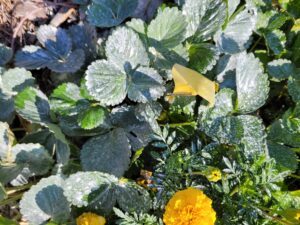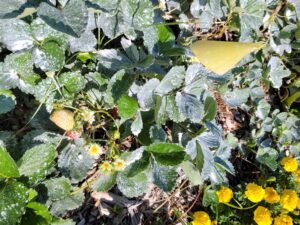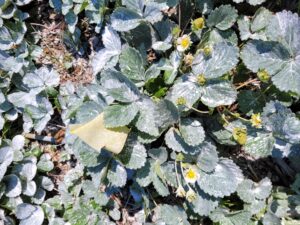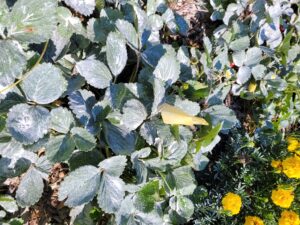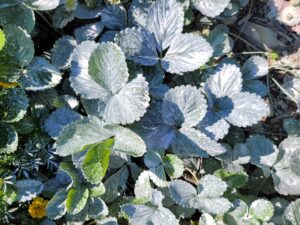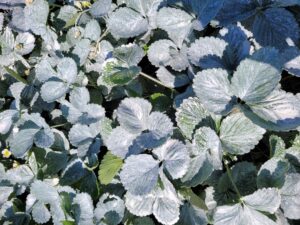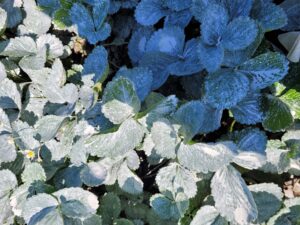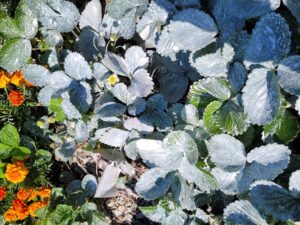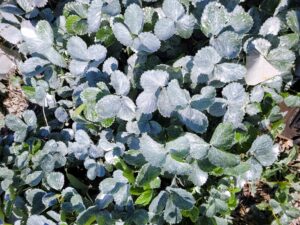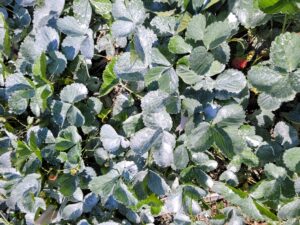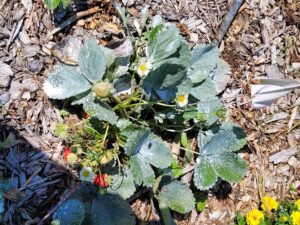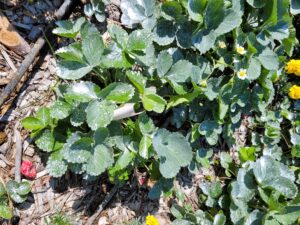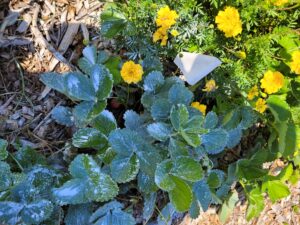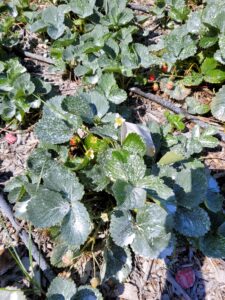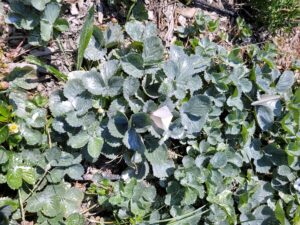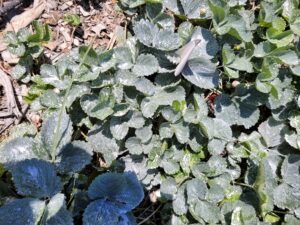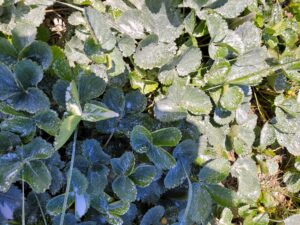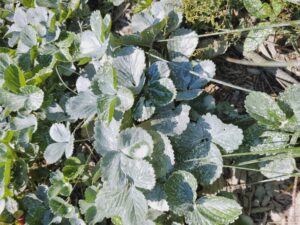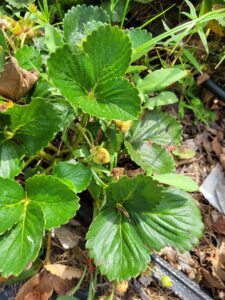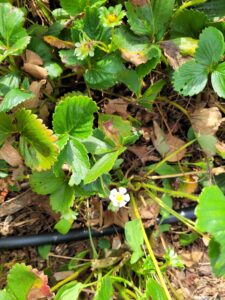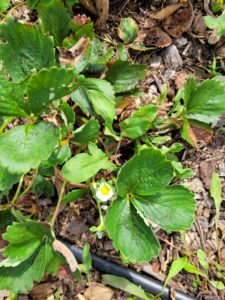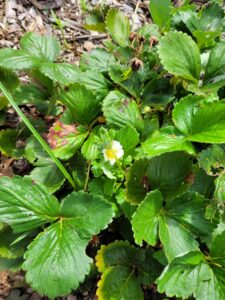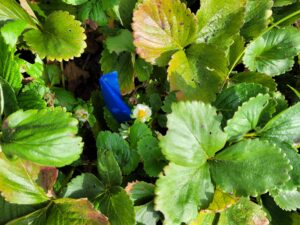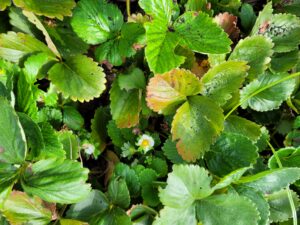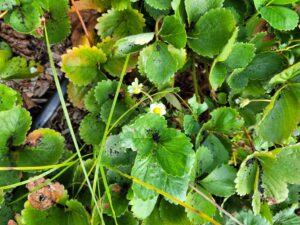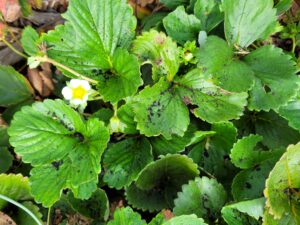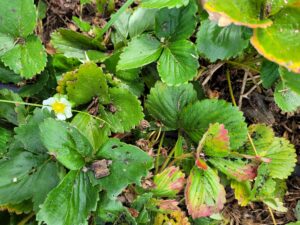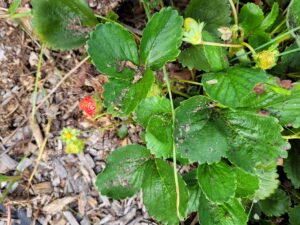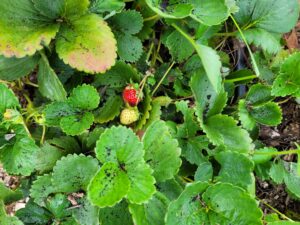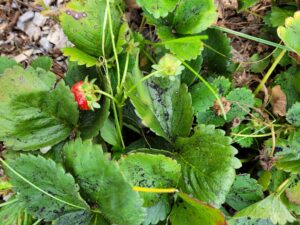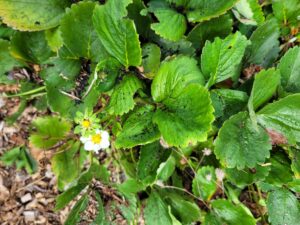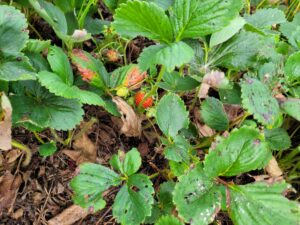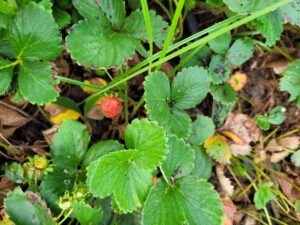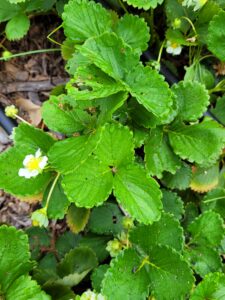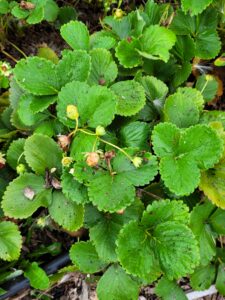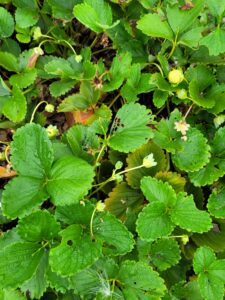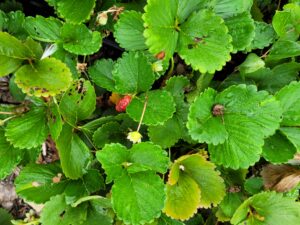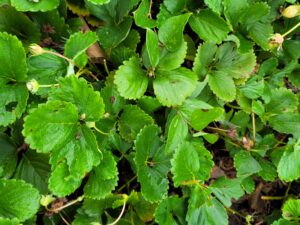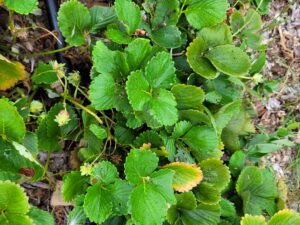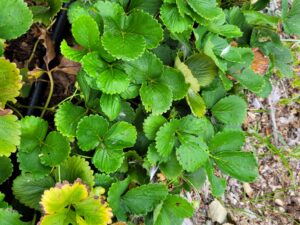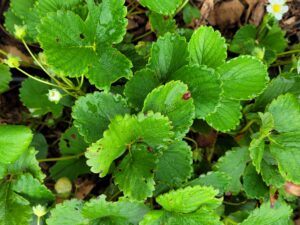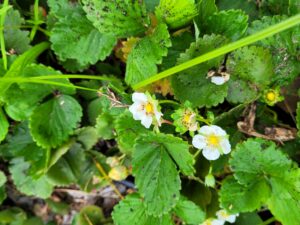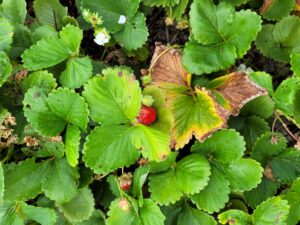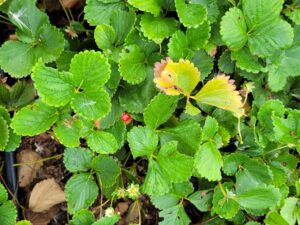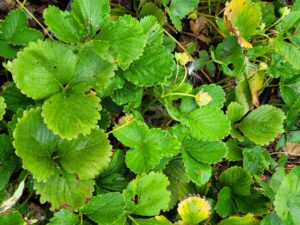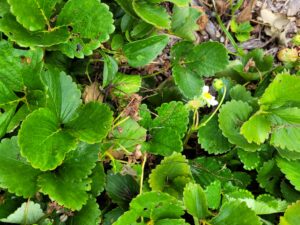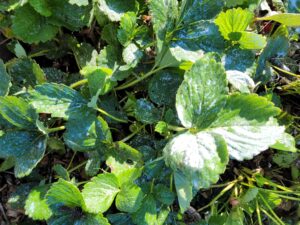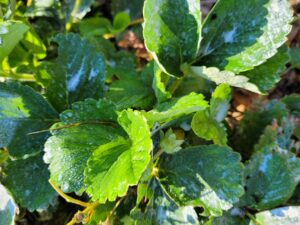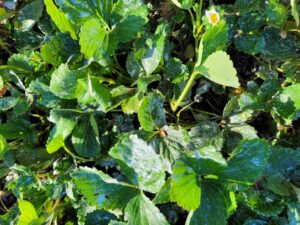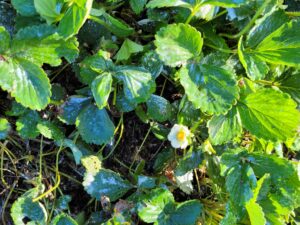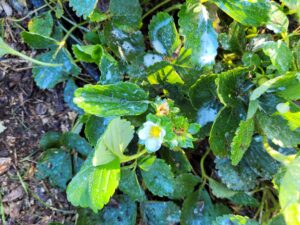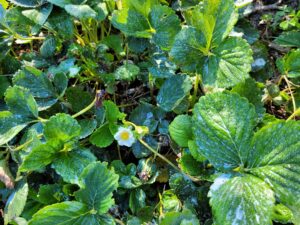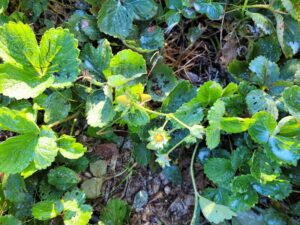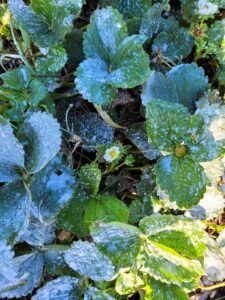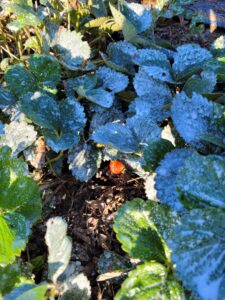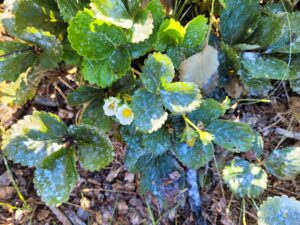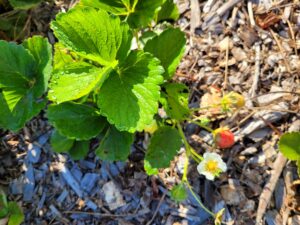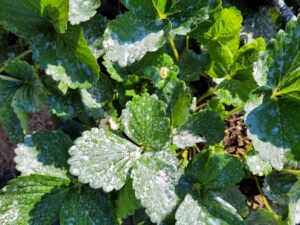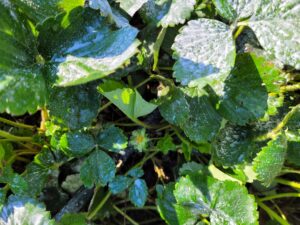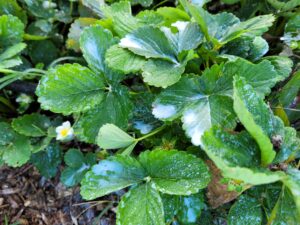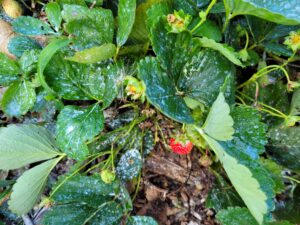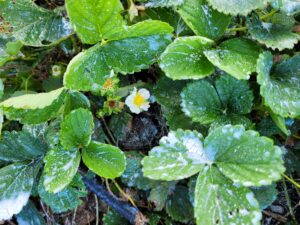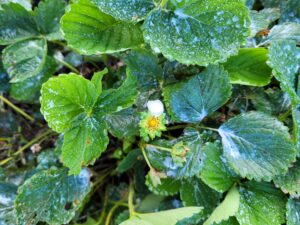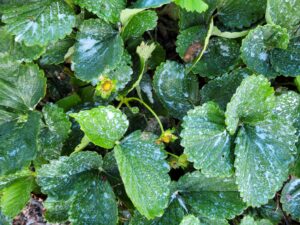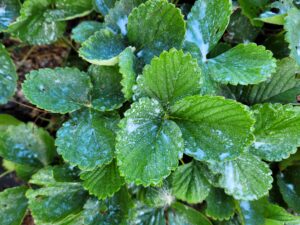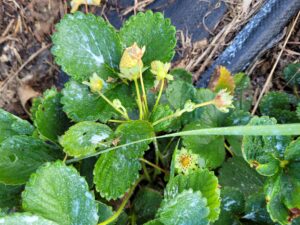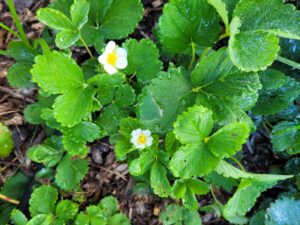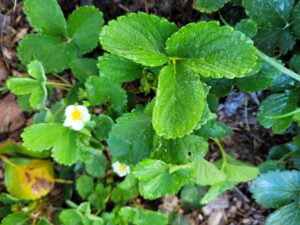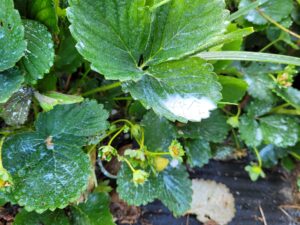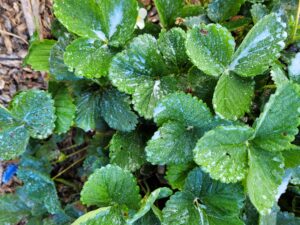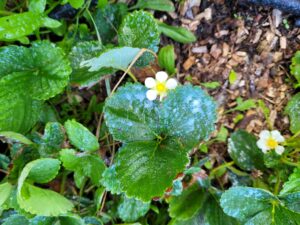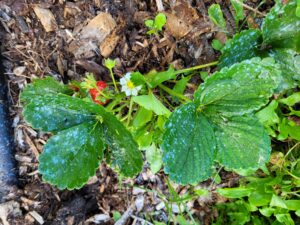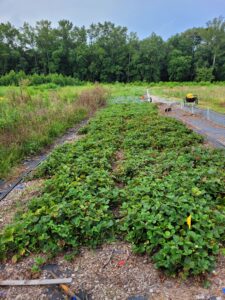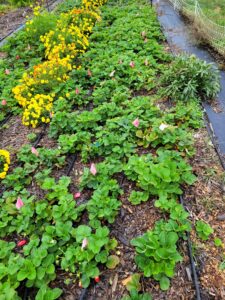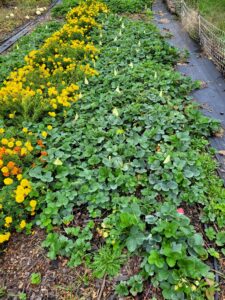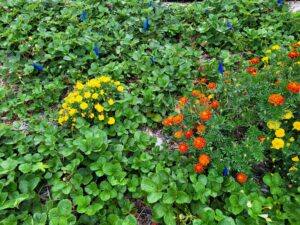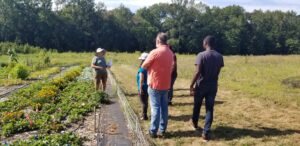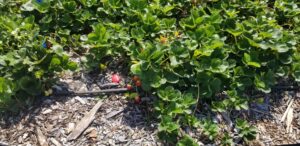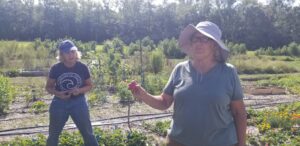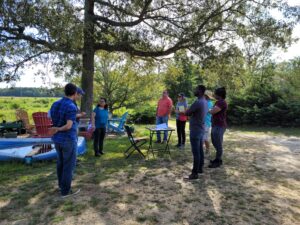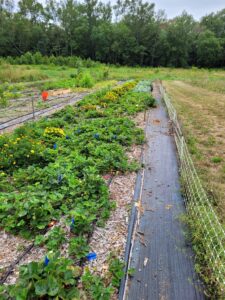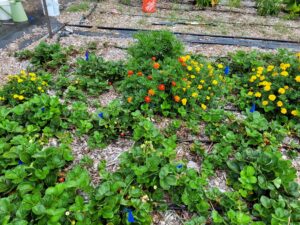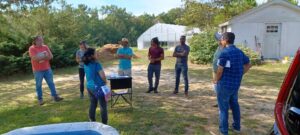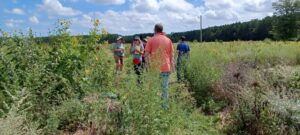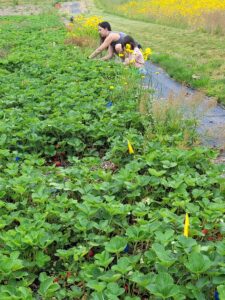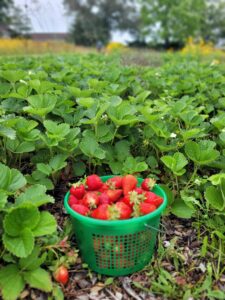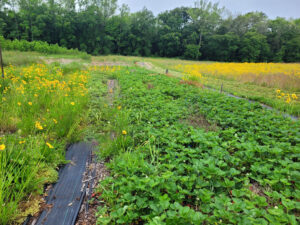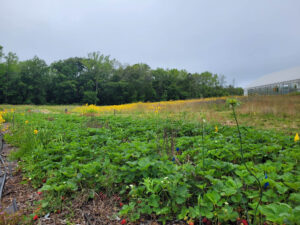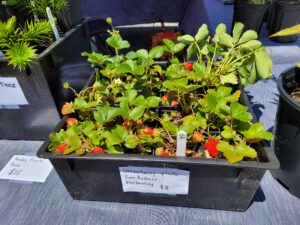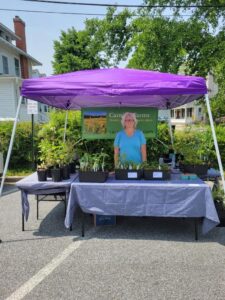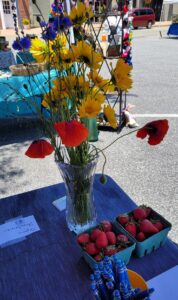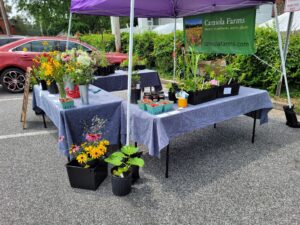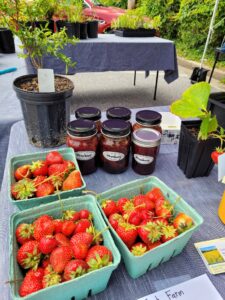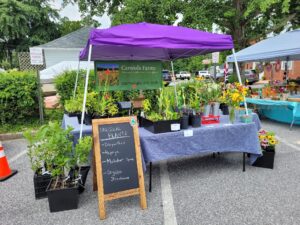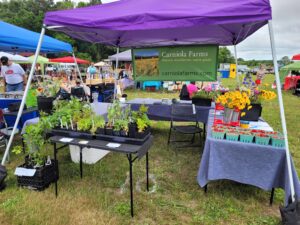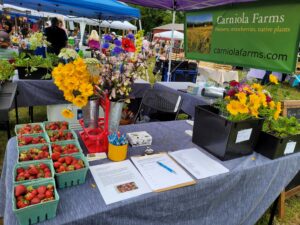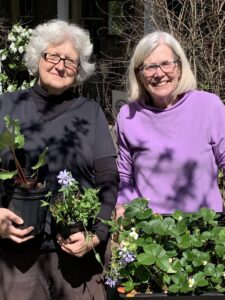Final report for FNE22-031
Project Information
The purpose of the project was to demonstrate that Kaolin clay spray can be applied to strawberries to prevent disease and control pests, in lieu of toxic synthetic chemicals. Strawberries were planted into wood chip beds, and watered via drip irrigation. Two varieties of day-neutral strawberries were used, and four sections created. Half the plants were used as control and half were sprayed weekly with Kaolin clay. Strawberries and plants were photographed and assessed weekly for signs of mold, leaf disease and insect damage, and ranked on a scale of 0 to 5, with 5 being the most severe. The averaged results showed that there was no sign of mold, on any plant. There was minimal damage caused by leaf disease (between 0 and 1 on the scale) and insects (between 0 and 1), shown as follows:
Average for 2022 season:
|
Average |
Section 1 |
Section 2 |
Section 3 |
Section 4 |
|
Mold |
0 |
0 |
0 |
0 |
|
Leaf scorch/spot |
0.66 |
.85 |
.16 |
0 |
|
Insect damage |
1 |
.66 |
.66 |
.66 |
Average for 2023 season:
|
Average |
Section 1 |
Section 2 |
Section 3 |
Section 4 |
|
Mold |
0 |
0 |
0 |
0 |
|
Leaf scorch/spot |
0.2 |
.2 |
.2 |
.2 |
|
Insect damage |
1 |
1 |
.8 |
.8 |
Outreach included hosting a Field Day and presenting to 12 farmers and 8 educators, giving an interview to the eastern shore Delmarva farming online newspaper (reaching potentially many farmers and educators), and giving a presentation to farmers, educators and agricultural professionals at the University of Maryland Eastern Shore Small Farm conference held in November 2022.
Outreach in 2023 included engaging the Maryland eastern shore community via the farm's facebook page, having U Pic Strawberry days, selling strawberries, strawberry jam and strawberry plants at the Snow hill Farmer's Market in Maryland weekly, and selling strawberries at the Pittsville Maryland annual Strawberry Festival in June. We also sold and advertised our strawberries at our Arlington Virginia stand in May and June. Our farmer's market stand posted information about the SARE grant for strawberries every week.
Objective #1: This project will evaluate the effectiveness of Kaolin clay spray on different day neutral strawberries in controlling common fungal strawberry diseases on the Eastern shore of Maryland, including strawberry leaf scorch, gray mold, and strawberry leaf spot. Data will be shared with local growers through field days and UMES Small Farm Conference.
Objective #2: This project will evaluate the effectiveness of Kaolin clay spray on different day neutral strawberries in thwarting common pests on the Eastern shore of Maryland, including Japanese beetle, crickets, and leaf hoppers. Data will be shared with local growers through field days and UMES Small Farm Conference.
If proven effective, Kaolin clay will be shown to be an organic and safer method for local farmers to treat strawberries. Presently, very few farmers grow fruit on the Eastern shore due to the excessive amounts or inorganic treatments required under conventional farming. This information will be shared with other farmers to accelerate local production of strawberries in our area. This research will encourage local farmers to grow fruit using organic methods.
In recent years, several economically important fungal pathogens (leaf spot, leaf scorch, and gray mold; 1) and insects (Japanese beetles, crickets and grasshoppers; 1) of strawberry became resistant and prone to commercially available fungicide (quinone outside inhibitors and succinic dehydrogenase inhibitor (2) and insecticides (malathion and spinetoram; 3) due to multiple applications throughout the growing season. The Eastern shore has high humidity, high temperatures and more rain than in most parts of the USA, so there are more diseases in our area (4). Generally, the use of synthetic chemicals is not good for the soil or humans. There is an urgent need to use innovative environmental friendly and organic approaches to control strawberry diseases and pathogens (5). An organic approach to thwart pests and diseases is preferred, such as the use of kaolin clay, to be sprayed as both a pesticide and to reduce disease problems (5, 6). Kaolin has been found to be effective in both suppressing pests and fungal diseases in citrus (5). Kaolin was applied at 7 and 14 day intervals on citrus trees. Kaolin interfered in the navigation of the insect Diaphorina citri, as the kaolin reflected light as white in color. Kaolin also suppressed fungal diseases in the citrus as the clay inhibited the penetration of fungus (5, 6). Foliar applications of clays, such as kaolin, have been suggested as a method of reducing fungal diseases in greenhouse cucumbers by interfering with the ability of the fungus to penetrate the leaf surface (6). By using an organic approach, there will be fewer or no toxins in the strawberries. They can be sold at our farm stand and in local markets. People in our area have shown they are willing to pay more in order to eat local organic and safe food. This in turn will increase our sales and profit at our farm. Very few farmers are growing fruit on the Eastern shore, because it is thought that growing fruit, like strawberries, requires the use of too many toxic chemicals. Sales of fruit by Eastern shore farmers at farmers markets is almost non-existent. Information gleaned from this study on controlling strawberry diseases and thwarting pests using kaolin clay will be shared with other farmers. These farmers can then add strawberries to what they are already producing, which will increase employment in local farm communities. A recent workshop report published in ‘HortTechnology’ recommend the cultivation of DNC for season extension and increase yield in Mid-Atlantic USA (7). Strawberry research and has enormous potential and opportunity on the Delmarva Peninsula to promote local strawberry production. The use of non-toxic Kaolin clay will promote sustainable agriculture in our area and could introduce a new pest management practice. The additional capacity built through this project will accelerate a diversified local food production that contain strawberries.
Carniola Farms is an 11-acre diverse permaculture-style, beyond-organic farm in Parsonsburg, Maryland, purchased in 2019. We have a 32-hive bee house near completion, a two-acre orchard with 200 orchard trees (17 different varieties) and small fruit plants including strawberries; a 20’ x 48’ greenhouse, a 24’ x 72’ high tunnel purchased with NCRS grant of $7500; a one-acre market garden; and three acres of seeded flowers and herbs for cut flowers and medicinal herbs. The farm is an extension of its first location in Arlington, Virginia where bees have been kept for five years and honey sold. In April 2023, we are opening a nursery and market garden on the farm, with a focus on perennial plants and herbs. Both strawberries and strawberry plants will be sold. The strawberry plants were planted in the existing market garden area, which has an electric fence surrounding it and drip irrigation. The entire market garden area is heavily mulched with wood chips. In spring 2023, the strawberry bed area will be expanded to plant the additional strawberry plants grown from this project. Strawberries and strawberry plants will be sold at various markets on the eastern shore of Maryland.
Project Director M.Velikonja works on the farm full-time; S. Oaxaca part-time. In summer 2022 the farm had one part-time staff employee.
M. Velikonja has 30+ years’ experience with gardening, composting and beekeeping, is a master gardener, has certifications in sustainable urban agriculture and permaculture design, and is the chief grower for the farm full-time. Technical advisor has extensive experience. Farm has sold produce/beekeeping services by word of mouth for five years in Arlington, Virginia. S. Oaxaca is an experienced builder of sheds, workshops and greenhouses.
Cooperators
- - Technical Advisor (Educator)
Research
The following methodology was used for the evaluation objective 1 and 2.
Strawberries were planted into organic beds using wood chips as mulch. Water was delivered via drip irrigation, thereby preserving soil and water. Two varieties of day neutral strawberries (San Andreas, Seascape) were used. Strawberry plants were grown in beds with wood chip mulch (Dimension: 100’ x 4’), planted 12 inches apart (with help of the Technical advisor). 100 plants per variety were used. 50% of the plants will be used as control and be untreated. Bare root plants were planted in April 2022, due to extended periods of frost and rain during March. The study has four groups of 50 plants each as follows: 1. San Andreas, untreated; 2. Seascape, untreated; 3. San Andreas treated; 4. Seascape, treated. Kaolin clay spray was applied to Groups 1 and 2 every 7 to 10 days, from April through October 2022, Two gallons of kaolin spray mix was used per application (Ratio is one gallon water, 2 cups dry Kaolin clay, and 1 tablespoon dishwater soap). All four groups received organic fertilizer treatments using comfrey tea (applied weekly) and True Organic Berry and Fruit organic granules (applied monthly). Additionally, small rocks spray painted red were placed around the plants in each section, to thwart birds eating the berries.
Data analysis: Plants in all four groups were examined weekly for diseases and pests, using severity ratings, and photos taken (with help of the technical advisor). The central 15 plants from each treatment were used for the estimation of yield/plant. Colored flags were placed at each original plant, to ensure that the same plants were examined (because the number of plants grew).
Disease Severity: Severity of gray mold was rated on a scale of 1 to 5 using the following scale: 1 = presence of dark brown spots on basal leaves with absence of conidiophores; 2 = presence of conidiophores in dark brown spots on basal leaves; 3 = conidiophores in basal leaf spots and lesions but no conidiophores on second level of leaves; 4 = conidiophores visible on lesions on second level of leaves; 5 = widespread rotting of the head throughout the season (11). Disease severity for leaf scorch and leaf spot were assessed using following scale: 0 = no lesion, 1 = 20% or less, 2 = 21–40%, 3 = 41–60%, 4 = 61–80%, 5 = 81–100% of leaf infected area. Disease was recorded 100 days after transplanting . Insect damage was assessed by rating each damaged leaf on a scale from 1 (the least damage) to 5 (the most severe damage) for each variety throughout the season. These scores were averaged and recorded.
Monthly reports to the Technical Advisor were submitted and uploaded on Google Drive. They are copy and pasted here, along with sample photos.
March 2022:
Grant period began on March 1, 2022.
During March, the bed was prepared by measuring a pre-existing bed. Four sections were created as follows:
1st section: 50 San Andreas strawberries, used for control, blue flags
2nd section: 50 Seascape strawberries, used for control, red flags
3rd section: 50 San Andreas strawberries, to be sprayed, yellow flags
4th section: 50 Seascape strawberries, to be sprayed, white flags
The varieties of San Andreas and Seascape were chosen because they are regularly available for purchase from organic nurseries (Raintree was chosen), and because they are commonly grown in our region.
The bed was covered by approximately 5 inches of fresh, rough-cut wood chips, in fall 2021. Additional wood chips will be applied in April 2022. Underneath the wood chips is a layer of contractor’s paper, serving as a temporary weed barrier. A six-foot area of separation was created between Sections 2 and 3, in order to ensure that the Kaolin clay spray does not drift over from Section 3 to Section 2. The four sections were measured to allow for approximately ten inches between each planted strawberry.
15 onion plants per section were planted in a row, to serve as companion plants to deter pests.
Due to the cold weather in March, delivery of the strawberries was delayed until March 28. Because the cold weather continued, the strawberry plants were not planted until April 2, 2022, to ensure their survival.
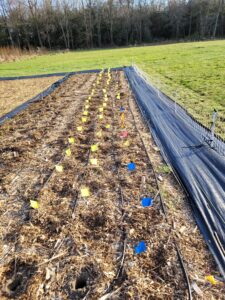
April 2022
Strawberries were planted on 4/2/2022 and watered. It was too cold to plant before this date.
125 strawberry plants of each Seascape and San Andreas were ordered. The extra 25 plants were purchased in order to ensure enough plants for the study, assuming that some plants would arrive dead or too weak to survive. 62 or 63 plants were planted into each section. The plants arrived bareroot with no leaves. For each plant, the wood chips were moved aside so that the soil underneath was exposed. Some soil (which is sandy) was mixed in with ordinary topsoil. Plants were planted directly into the soil. The wood chips were then moved back around, but not touching, the plant.
4/5/2022 Wood chip mulch that was ordered was applied around the strawberries, adding 5 inches of height to the wood chips.
4/11/2022 One tablespoon of bonemeal was spread around the base of each plant. Some leaves on a few plants were showing.
4/17/2022 One tablespoon of bloodmeal was spread around the base of each plant. By count, at least 50 plants in each section were now showing leaves. However, it is clear that the Seascape variety is the stronger/larger variety, as they had more leaves overall and the leaves were larger than the San Andreas variety. All flowers on the plants were nipped off in order to allow the plants to concentrate on developing.
4/25/202 One tablespoon of organic vegetable fertilizer was spread around the base of each plant. Each section had at least 50 plants each. No plant deaths were observed. A number of plants simply never began growing leaves, particularly the San Andreas variety.
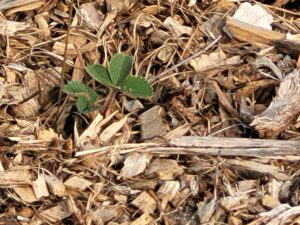
May 2022
5/3/2022 and 5/10/2022 Comfrey tea applied as fertilizer
5/11-12/2022 Visit by Technical Advisor Kirsten Conrad. Soil samples taken and sent to Virginia Tech.
5/13/2022 Stopped picking off strawberry flowers
5/17/2022 Planted 13 marigolds in each section, as companion plants to deter pests.
5/21/2022 Added one cup of compost around the base of each strawberry plant.
5/23/2022 One tablespoon of organic strawberry fertilizer was applied around the base of each plant.
5/24/2022 Large storm with heavy rains
5/25/2022 Kaolin foliar spray applied to leaves and berries of each plant in Sections 3 and 4
5/26/2022 Received soil sample report from Virginia Tech. All good, but recommended to add nitrogen. One tablespoon of bloodmeal was applied to each plant.
5/31/2022 It was observed that the marigolds planted in each section appear dry and do not look well. Several grasshoppers were observed eating the marigolds. The strawberry plants look good and are growing well. Several strawberries are at maturity and most plants have flowers and/or berries. The Seascape plants continue to grow larger than the San Andreas variety.
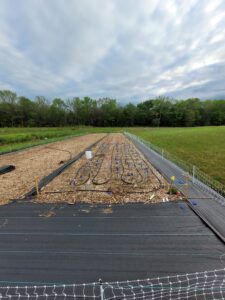
June 2022
6/1, 6/8, 6/15, 6/30 Comfrey tea applied
6/2, 6/9, 6/17, 6/25 Applied kaolin clay
6/3 Prof. Kuman-Dixit advised to spray entire strawberry plant with kaolin.
6/11 Noted that beds are dry despite watering. Some ants present on some strawberries. Began hand watering until a better drip irrigation system is installed
6/13 Birds may be pecking at strawberries. Will add more painted red rocks
6/20 Fewer berries growing since high temperatures began
6/22 Attended Field Day in Painter VA. Noted red leaves with holes at the base of some plants. Removed all red leaves.
6/23 Applied berry fertilizer
6/29 Noted that San Andreas strawberries not flowering as well as Seascape
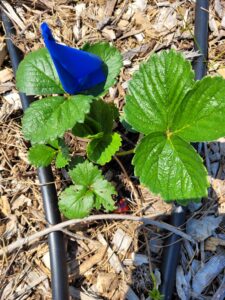
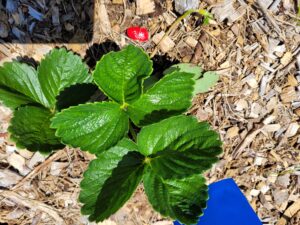
June
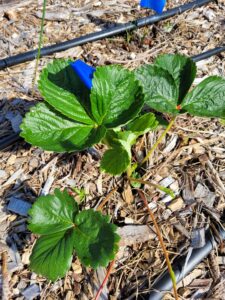
June
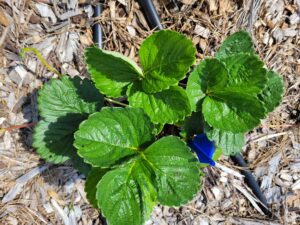
July 2022
According to the Proposal Summary Methods and Materials/Methodology section, the Project Manager will evaluate the disease severity of the strawberry plants based on the photographs taken every 7 to ten days (beginning in mid-July 2022).
Disease Severity: Severity of gray mold will be rated on a scale of 1 to 5 using the following scale: 1 = presence of dark brown spots on basal leaves with absence of conidiophores; 2 = presence of conidiophores in dark brown spots on basal leaves; 3 = conidiophores in basal leaf spots and lesions but no conidiophores on second level of leaves; 4 = conidiophores visible on lesions on second level of leaves; 5 = widespread rotting of the head.
Disease severity for leaf scorch and leaf spot will be assessed using following scale: 0 = no lesion, 1 = 20% or less, 2 = 21–40%, 3 = 41–60%, 4 = 61–80%, 5 = 81–100% of leaf infected area. Disease will be recorded 100 days after transplanting. Insect damage will be assessed by rating each damaged leaf on a scale from 1 (the least damage) to 5 (the most severe damage) for each variety. These scores will be averaged and recorded.
Disease Severity Scale for July 2022
Section 1 = San Andreas, control (no treatment)
Section 2 = Seascape, control (no treatment)
Section 3 = San Andreas, sprayed with Kaolin clay
Section 4 = Seascape, sprayed with Kaolin clay
Date of photos:7/10/22
|
Type of Disease |
Section 1 |
Section 2 |
Section 3 |
Section 4 |
|
Mold |
0 |
0 |
0 |
0 |
|
Leaf scorch/spot |
0 |
1 |
0 |
0 |
|
Insect damage |
1 |
1 |
1 |
1 |
|
|
|
|
|
|
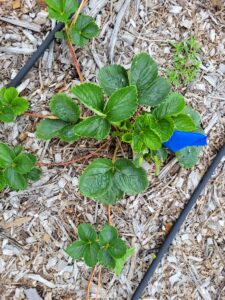
Date of photos: 7/20/22
|
Type of Disease |
Section 1 |
Section 2 |
Section 3 |
Section 4 |
|
Mold |
0 |
0 |
0 |
0 |
|
Leaf scorch/spot |
1 |
0 |
1 |
0 |
|
Insect damage |
1 |
1 |
1 |
1 |
|
|
|
|
|
|
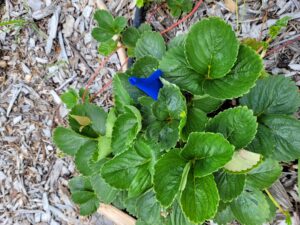
Date of photos: 7/31/22
|
Type of Disease |
Section 1 |
Section 2 |
Section 3 |
Section 4 |
|
Mold |
0 |
0 |
0 |
0 |
|
Leaf scorch/spot |
1 |
1 |
0 |
0 |
|
Insect damage |
1 |
1 |
1 |
0 |
|
|
|
|
|
|
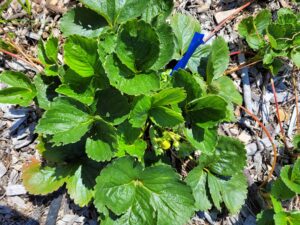
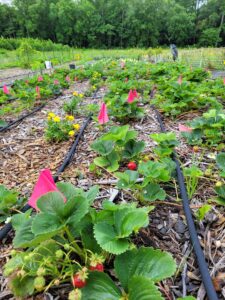
Daily Log
7/7, 7/15, 7/22 Comfrey applied
7/4, 7/10, 7/20, 7/31 Photos taken, Kaolin clay sprayed
7/4 Observed that early cycle of San Andreas strawberry ending
7/6 New soaker hose purchased. Current drip irrigation is insufficient to adequately water strawberry plants. Due to bed consistently entirely of sand except for the top soil layer, more frequent watering is required
7/9-7/10 Rained all day
7/10 Soaker hose installed
7/20 Observed that there are many more strawberries growing now (only Seascape). Leaf spot has diminished
7/30 Applied berry fertilizer
General observation: Plants and berry look very healthy and berries are tasty. There is no presence of mold. There is the occasional insect nibble from crickets. No Japanese beetles observed in strawberry area. Red leaves are diminished.
August 2022
According to the Proposal Summary Methods and Materials/Methodology section, the Project Manager will evaluate the disease severity of the strawberry plants based on the photographs taken every 7 to ten days (beginning in mid-July 2022).
Disease Severity: Severity of gray mold will be rated on a scale of 1 to 5 using the following scale: 1 = presence of dark brown spots on basal leaves with absence of conidiophores; 2 = presence of conidiophores in dark brown spots on basal leaves; 3 = conidiophores in basal leaf spots and lesions but no conidiophores on second level of leaves; 4 = conidiophores visible on lesions on second level of leaves; 5 = widespread rotting of the head.
Disease severity for leaf scorch and leaf spot will be assessed using following scale: 0 = no lesion, 1 = 20% or less, 2 = 21–40%, 3 = 41–60%, 4 = 61–80%, 5 = 81–100% of leaf infected area. Disease will be recorded 100 days after transplanting. Insect damage will be assessed by rating each damaged leaf on a scale from 1 (the least damage) to 5 (the most severe damage) for each variety. These scores will be averaged and recorded.
Disease Severity Scale for August 2022
Section 1 = San Andreas, control (no treatment)
Section 2 = Seascape, control (no treatment)
Section 3 = San Andreas, sprayed with Kaolin clay
Section 4 = Seascape, sprayed with Kaolin clay
Date of photos: 8/10/2022
|
Type of Disease |
Section 1 |
Section 2 |
Section 3 |
Section 4 |
|
Mold |
0 |
0 |
0 |
0 |
|
Leaf scorch/spot |
0 |
1 |
0 |
0 |
|
Insect damage |
1 |
0 |
0 |
1 |
|
|
|
|
|
|
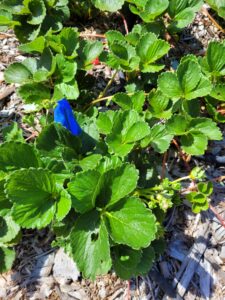
Date of photos: 8/20/2022
|
Type of Disease |
Section 1 |
Section 2 |
Section 3 |
Section 4 |
|
Mold |
0 |
0 |
0 |
0 |
|
Leaf scorch/spot |
1 |
1 |
0 |
0 |
|
Insect damage |
1 |
1 |
1 |
1 |
|
|
|
|
|
|
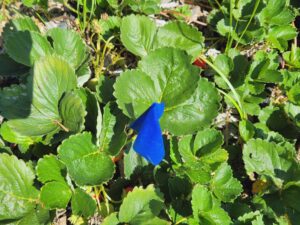
Daily Log
8/10, 8/17, 8/25 Comfrey applied
8/10, 8/20 Photos taken, Kaolin clay sprayed
8/11 Observed that berry production is very high now. Berry plants have also grown well in size, and are producing many runners.
8/25 San Andreas berries are now larger than the Seascape berries
8/31 Applied berry fertilizer
General observations: No rain all month. Plants are vigorous and look very healthy. Towards the end of the month San Andreas plants began surpassing Seascape in the number of berries produced. .Have observed some wasps on the berries, and occasionally crickets/grasshoppers on some leaves. Near the end of the month, plants in Sections 3 and 4 are getting overcrowded with the new plants produced from runners. August has thus far been the month for highest production of berries.
September 2022
Date of photos: 9/9/2022
|
Type of Disease |
Section 1 |
Section 2 |
Section 3 |
Section 4 |
|
Mold |
0 |
0 |
0 |
0 |
|
Leaf scorch/spot |
0 |
1 |
0 |
0 |
|
Insect damage |
1 |
0 |
0 |
0 |
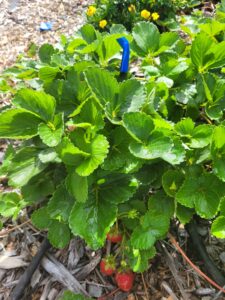
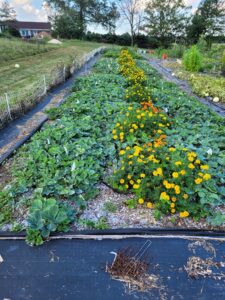
Average for 2022 season:
|
Average |
Section 1 |
Section 2 |
Section 3 |
Section 4 |
|
Mold |
0 |
0 |
0 |
0 |
|
Leaf scorch/spot |
0.66 |
.85 |
.16 |
0 |
|
Insect damage |
1 |
.66 |
.66 |
.66 |
March 2023:
Grant period continued through August 2023.
During March, the beds were cleaned and over 1,000 strawberry plants were removed and re-potted for sale. Four sections remained as before:
1st section: 50 San Andreas strawberries, used for control, blue flags
2nd section: 50 Seascape strawberries, used for control, red flags
3rd section: 50 San Andreas strawberries, to be sprayed, yellow flags
4th section: 50 Seascape strawberries, to be sprayed, white flags
15 onion plants per section were planted in a row, to serve as companion plants to deter pests.
March was a cold month and strawberries did not grow.
April 2023
April continued to be cold. Clearing of beds continued throughout the month.
4/03/2023 One tablespoon of bloodmeal was spread around the base of each plant.
4/17/2023 One tablespoon of berry fertilizer was spread around the base of each plant.
May 2023
5/1/2023 and 5/8/2023 Comfrey tea applied as fertilizer
5/21/2023 Added one cup of compost around the base of each strawberry plant.
5/22/2023 One tablespoon of organic strawberry fertilizer was applied around the base of each plant.
5/25/2022 Kaolin foliar spray applied to leaves and berries of each plant in Sections 3 and 4
5/26/2022 Soil sample reports from Maryland indicate to add nitrogen. One tablespoon of bloodmeal was applied to each plant.
5/31/2022 The strawberry plants look good and are growing well. Several strawberries are at maturity and most plants have flowers and/or berries. The Seascape plants continue to grow larger than the San Andreas variety. Kaolin foliar spray applied to leaves and berries of each plant in Sections 3 and 4.
June 2023
6/5, 6/12, 6/19, 6/26 Comfrey tea applied
6/7, 6/17, 6/30 Applied kaolin clay. Marigolds planted.
6/12 Noted that beds are fairly dry despite watering.
6/20 Fewer berries growing since high temperatures began.
6/19 Applied berry fertilizer
6/29 Noted that San Andreas strawberries not flowering as well as Seascape
6/30 Fewer berries growing since high temperatures began.
July 2023
According to the Proposal Summary Methods and Materials/Methodology section, the Project Manager will evaluate the disease severity of the strawberry plants based on the photographs taken every 7 to ten days (beginning in mid-July 2023).
Disease Severity: Severity of gray mold will be rated on a scale of 1 to 5 using the following scale: 1 = presence of dark brown spots on basal leaves with absence of conidiophores; 2 = presence of conidiophores in dark brown spots on basal leaves; 3 = conidiophores in basal leaf spots and lesions but no conidiophores on second level of leaves; 4 = conidiophores visible on lesions on second level of leaves; 5 = widespread rotting of the head.
Disease severity for leaf scorch and leaf spot will be assessed using following scale: 0 = no lesion, 1 = 20% or less, 2 = 21–40%, 3 = 41–60%, 4 = 61–80%, 5 = 81–100% of leaf infected area. Insect damage will be assessed by rating each damaged leaf on a scale from 1 (the least damage) to 5 (the most severe damage) for each variety. These scores will be averaged and recorded.
July 2023
Section 1 = San Andreas, control (no treatment)
Section 2 = Seascape, control (no treatment)
Section 3 = San Andreas, sprayed with Kaolin clay
Section 4 = Seascape, sprayed with Kaolin clay
Date of photos:7/05/23
|
Type of Disease |
Section 1 |
Section 2 |
Section 3 |
Section 4 |
|
Mold |
0 |
0 |
0 |
0 |
|
Leaf scorch/spot |
0 |
0 |
0 |
0 |
|
Insect damage |
1 |
1 |
1 |
0 |
|
|
|
|
|
|
Date of photos: 7/19/23
|
Type of Disease |
Section 1 |
Section 2 |
Section 3 |
Section 4 |
|
Mold |
0 |
0 |
0 |
0 |
|
Leaf scorch/spot |
0 |
0 |
0 |
0 |
|
Insect damage |
1 |
1 |
1 |
1 |
August 2023
According to the Proposal Summary Methods and Materials/Methodology section, the Project Manager will evaluate the disease severity of the strawberry plants based on the photographs taken every 7 to ten days (beginning in mid-July 2023).
Disease Severity: Severity of gray mold will be rated on a scale of 1 to 5 using the following scale: 1 = presence of dark brown spots on basal leaves with absence of conidiophores; 2 = presence of conidiophores in dark brown spots on basal leaves; 3 = conidiophores in basal leaf spots and lesions but no conidiophores on second level of leaves; 4 = conidiophores visible on lesions on second level of leaves; 5 = widespread rotting of the head.
Disease severity for leaf scorch and leaf spot will be assessed using following scale: 0 = no lesion, 1 = 20% or less, 2 = 21–40%, 3 = 41–60%, 4 = 61–80%, 5 = 81–100% of leaf infected area. Disease will be recorded 100 days after transplanting. Insect damage will be assessed by rating each damaged leaf on a scale from 1 (the least damage) to 5 (the most severe damage) for each variety. These scores will be averaged and recorded.
August 2023
Section 1 = San Andreas, control (no treatment)
Section 2 = Seascape, control (no treatment)
Section 3 = San Andreas, sprayed with Kaolin clay
Section 4 = Seascape, sprayed with Kaolin clay
Daily Log
8/7, 8/14, 8/21 Comfrey applied
8/10, 8/20 Kaolin clay sprayed
8/8 Observed that berry production is very high now. Berry plants have also grown well in size, and are producing many runners.
8/28 Applied berry fertilizer
General observations: No rain all month. Plants are vigorous and look very healthy, but toward the end of the month are getting too dry and the drip system cannot keep up. This year, San Andreas and Seascape plants seem about equal in the number of berries produced. Have observed some wasps on the berries, and occasionally crickets/grasshoppers on some leaves. Already at the beginning of the month, plants in all sections are overcrowded with the new plants produced from runners. August had the highest production of berries at the beginning of the month, which diminished due to lack of rain and sufficient water.
Date of photos: 8/7/2023
|
Type of Disease |
Section 1 |
Section 2 |
Section 3 |
Section 4 |
|
Mold |
0 |
0 |
0 |
0 |
|
Leaf scorch/spot |
0 |
0 |
0 |
0 |
|
Insect damage |
1 |
1 |
1 |
1 |
|
|
|
|
|
|
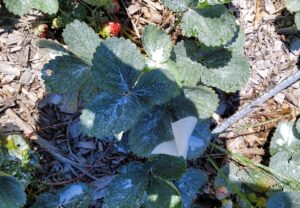
Date of photos: 8/17/2023
|
Type of Disease |
Section 1 |
Section 2 |
Section 3 |
Section 4 |
|
Mold |
0 |
0 |
0 |
0 |
|
Leaf scorch/spot |
0 |
0 |
0 |
0 |
|
Insect damage |
1 |
1 |
0 |
1 |
|
|
|
|
|
|
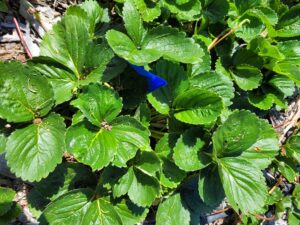
Date of photos: 8/25/2023
|
Type of Disease |
Section 1 |
Section 2 |
Section 3 |
Section 4 |
|
Mold |
0 |
0 |
0 |
0 |
|
Leaf scorch/spot |
1 |
1 |
1 |
1 |
|
Insect damage |
1 |
1 |
1 |
1 |
|
|
|
|
|
|
1st Section-Blue
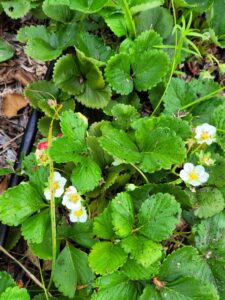
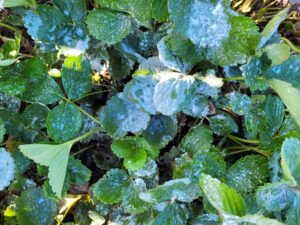
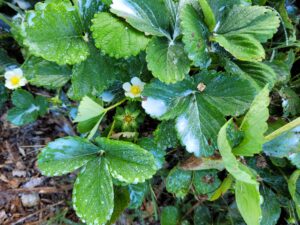
September 2023
The drought continued into September, and the strawberry plants continued to get drier without sufficient water from the insufficient drip irrigation system. The Project Director became ill in early September, so made the determination to end the 2023 portion of the project at the end of August 2023.
The purpose of the project was to demonstrate that kaolin clay spray can be applied to strawberries to prevent disease and control pests, in lieu of toxic synthetic chemicals. The problem in our area is that strawberries in the mid-Atlantic are dominated by June bearers/short day cultivars, and that pest and disease pressure on eastern shore are high due to high temps/humidity. As a result, this has prevented or dissuaded farmers from growing strawberries without the use of toxic inorganic pesticides.
In 2022, I studied the effects of spraying Kaolin clay on two varieties of day neutral strawberries, to reduce diseases and thwart pests. This sustainable approach promotes organic cultivation of strawberries in our area. I examined the plants weekly for diseases and pests. Disease severity and insect damage were recorded, using a scale of 0 to 5, and averaged.
Throughout the 2022 season, there was no sign of any mold on any plant. There was occasional leaf spot or reddening on a few plants, but never more than a 1 on the scale. There were occasionally holes in some leaves, likely made by grasshoppers, resulting in a rank of 1 on the scale for a few months. No Japanese beetles were observed on the plants, and no birds were observed eating the berries after red rocks were placed among the plants. There appeared to be little difference between the sections treated with Kaolin clay, and those untreated, in terms of mold, leaf damage or insect damage:
Average for 2022 season:
|
Average |
Section 1 |
Section 2 |
Section 3 |
Section 4 |
|
Mold |
0 |
0 |
0 |
0 |
|
Leaf scorch/spot |
0.66 |
.85 |
.16 |
0 |
|
Insect damage |
1 |
.66 |
.66 |
.66 |
Overall, the plants in all sections looked very healthy and produced many large and delicious strawberries.
There was a noticeable difference in the size and number of plants between the sections by the end of the season. The plants sprayed with Kaolin clay (Sections 3 and 4) had visibly larger plants, and many more, compared to the untreated plants (Sections 1 and 2). In Sections 3 and 4, the plants had almost completely filled out the entire bed, with runners spilling over onto the plastic outside the beds. In 2023, the plants completely filled all four beds.
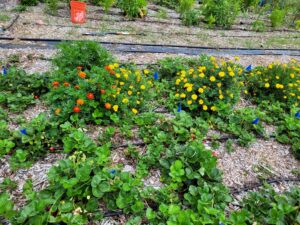 Section 1 close up showing gaps between plants
Section 1 close up showing gaps between plants
Section 2 in October 2022
Education & Outreach Activities and Participation Summary
Participation Summary:
- Field day at Farm.
On September 10, 2022, a Field Day was held at Carniola Farms. Participants were given a tour of the strawberry field, as well as the permaculture fruit orchard. In the strawberry field, participants were given an overview of the SARE research, as well as the preliminary results of the research. Participants were shown how to plant strawberry plants in mulch beds, how to spray with kaolin clay, and how to make comfrey tea from the comfrey plant used for fertilization.
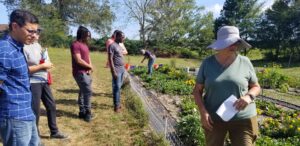
2. Journal article in the Delmarva Farmer: "Strawberries showing very little pest Damage". https://americanfarmpublications.com/strawberries-showing-very-little-pest-damage/?fbclid=IwAR3rVXpWpmhnwgVWOf-igchYllt82bnLb8k0-5xm2K09PSwn86g52zDTaOE
Strawberries showing ‘very little pest damage’ - American Farm Publications (pdf)
3. SARE Project presentation at the University of Maryland Eastern Shore Small Farm conference.
On November 5 2022, Maria Velikonja gave a presentation at the UMES conference reporting her SARE research project activities and preliminary conclusions.
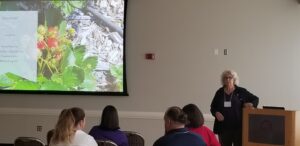
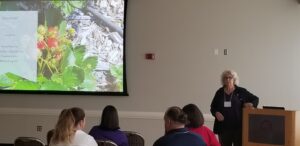
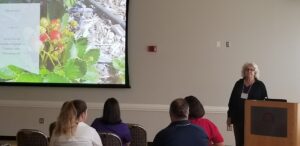
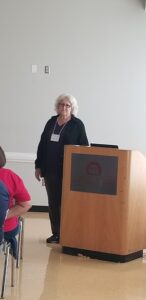
Presentation:
SARE grant at UMES, Nov 5, 2022
U Pick Strawberries at Farm May-June 2023
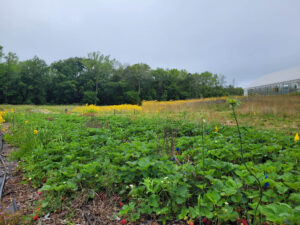
Snow Hill Maryland Farmers Market
Wicomico County Strawberry Festival 2023
Arlington Native Plants & Edibles market 2023
The Field Day 2023 that was written into the grant was not conducted with the Maryland SARE director as there was a schedule conflict.
4. Outreach in 2023 included engaging the Maryland eastern shore community via the farm's facebook page, having U Pic Strawberry days, selling strawberries, strawberry jam and strawberry plants at the Snow hill Farmer's Market in Maryland weekly, and selling strawberries at the Pittsville Maryland annual Strawberry Festival in June. We also sold and advertised our strawberries at our Arlington Virginia stand in May and June. Our farmer's market stand posted information about the SARE grant for strawberries every week.
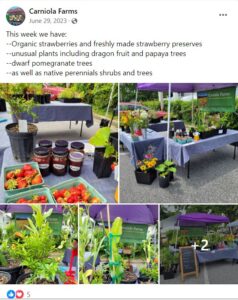
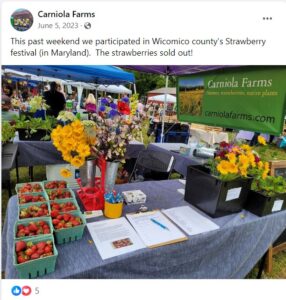
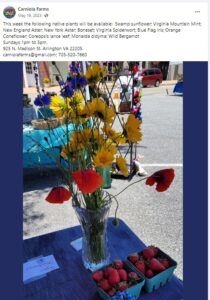
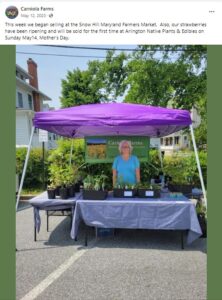
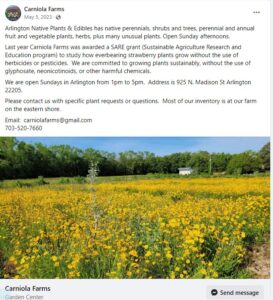
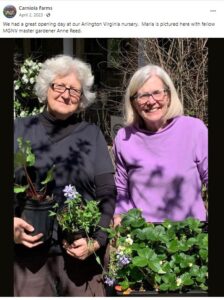
Learning Outcomes
Day-neutral variety strawberries grow very well on the eastern shore of Maryland without the use of synthetic inputs or chemicals. Organic measures can be used to produce an abundance of strawberries and strawberry plants, including the use of kaolin clay spray to help deter pests and protect the plants from the strong summer sun.
Project Outcomes
Carniola Farms was the first farm in Wicomico county to produce strawberries using organic methods, and possibly the first to do so on the eastern shore. With the opening of the farm stand and nursery in spring 2023, we advertised our organic methods to grow produce, which benefitted the local community, as well as an additional community, Arlington Virginia, where we sold our products at our market stand. We will unable to get into any additional farmers markets beyond Snow Hill, as the markets said they were already full.
In 2023 a nearby farm practicing sustainable methods also grew strawberries without the use of inorganic pesticides.
Unfortunately, the practice of farmers market managers on the eastern shore is detrimental to farms trying sustainable methods. With the exception of one market, the remainder accept "growers" who are mainly re-sellers, and who sell fruits and vegetables from outside the region as well as from the local chain grocery stores. The majority do not accept new farms into the markets, resulting in organic and sustainable farms going out of business due to lack of access to customers. Our recommendation would be to add farmers market management as key partners in supporting sustainable farming.
The key approach was to be determined to use only non-synthetic inputs for growing strawberries, and to be creative. Everywhere in this region, farmers, educators, and the extension office, say that high inputs of synthetic pesticides and herbicides are required to grow fruit in our region. Yet, this study shows that "common knowledge" is not true. In 2023, this research continued, with now established 2-year old plants. We sold both strawberries and strawberry plants on the farm and at local markets. The results in 2023 were the same as in 2022. There was very little insect damage, and no mold or disease issues. As the summer wore on the the plants received insufficient water, the plants that were sprayed with kaolin browned less as they were more protected from the sun.
Our farm has largely sandy soil, which requires that the plants receive more water. In summer it rains very little, which likely contributes to the lack of mold on the berries. Possibly plants were spared from Japanese beetles in June due to the sand. In 2023, a few Japanese beetles were spotted, but damage was minimal. We did treat the farm with milky spore, so likely there were few beetles overall in the area as a result. It would be useful to read of studies and trials with farmers who have different growing conditions (clay soils, wetter summer, for example) growing strawberries using similar methods to this study.
Going forward, we will not spray the plants with kaolin next year, simply because there was no damage to the berries that were not sprayed. We feel it is an effective barrier to insects, and will continue to spray kaolin on our orchard trees. Another factor is the need to improve our irrigation system. We tried four different drip irrigation systems over two years, and none were sufficient during the drought in August or September. Therefore we will install an overhead sprinkler system, which then makes the use of kaolin spray impractical.
